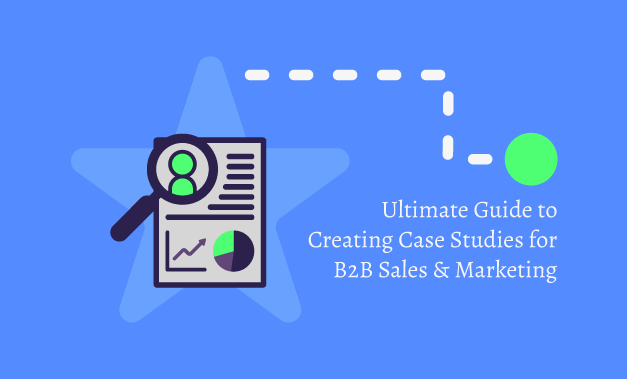

Ultimate Guide to Creating Case Studies for B2B Sales and Marketing
- November 15, 2021
- Creating Case Studies
Interested in creating Case Studies to use for your B2B sales efforts and marketing campaigns but don’t know where to start? This ultimate guide has you covered! This article points you in the right direction when it comes to the steps of creating Case Studies of your own, including how to schedule and prepare for interviews as well as develop and finalize your first draft.
What are Case Studies, and Why Should I Create Them?
Before you can create great Case Studies, you need to know the purpose they serve. Most of our blog posts define the term, as we can’t emphasize the importance of Case Studies enough.
In short, a Case Study is an overview of how your business has helped a real-life client. It’s an expanded, more sophisticated version of a Success Story that provides more context about your offering. It explains what issues the client had before you stepped in and how much the client’s business transformed once your product or service was in place.
Case Studies are extremely useful in B2B sales and marketing . They build confidence in your brand, as they serve as proof that your product or service works as it should and has resulted in satisfied customers.
However, high-quality Case Studies aren’t easy to create; they can take a significant amount of time, resources, and organizational skills. Furthermore, the creation process can go belly-up if a client doesn’t want to participate or if the right questions aren’t asked or the inappropriate tools are used. This is why many businesses rely on a third-party company like SuccessKit to create their Case Studies.
But you don’t find that daunting, we can tell! You’ve got a DIY spirit and the availability, tools, and know-how to take this project on yourself; you just need to know the steps. This brings us to our next section…
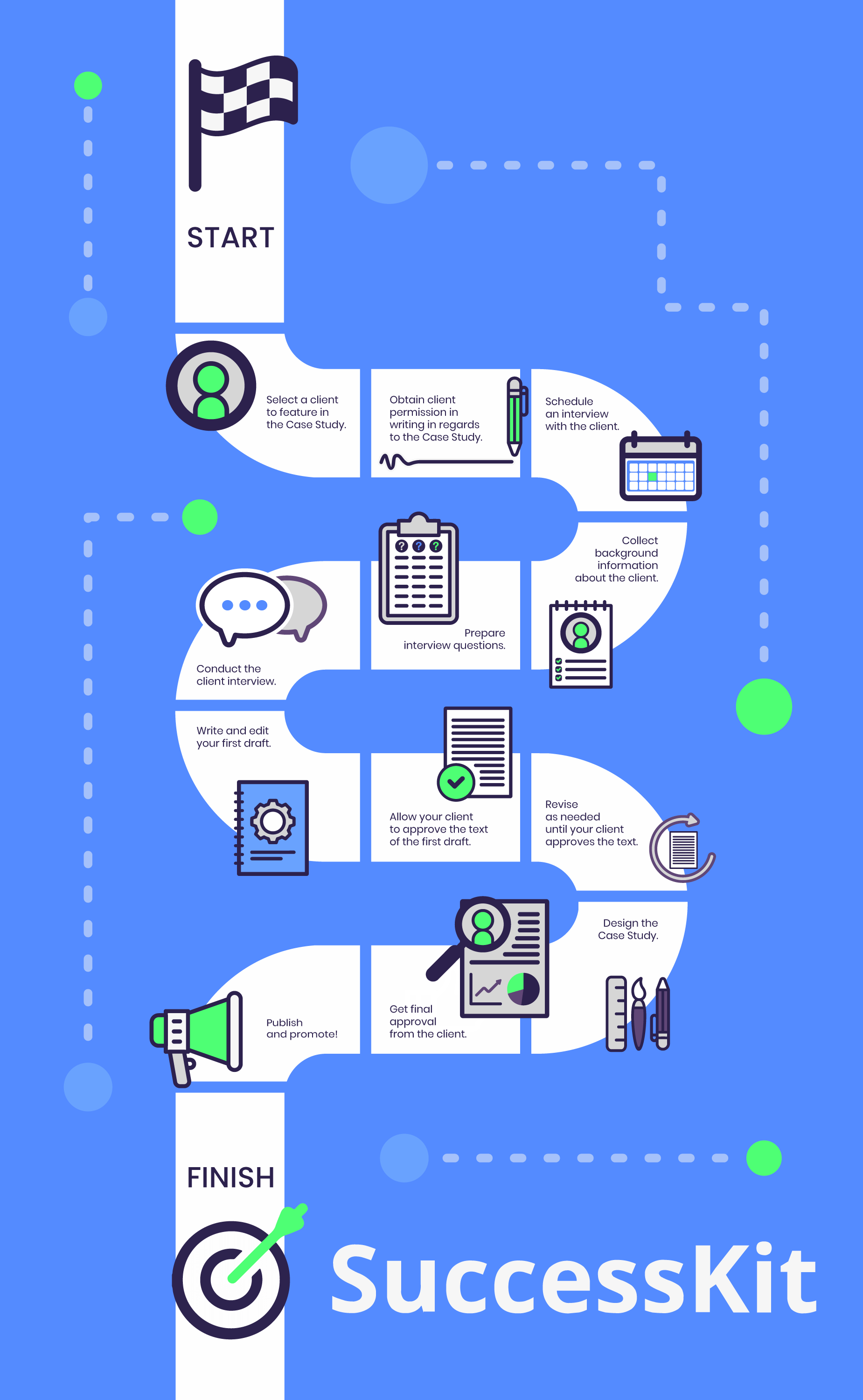
How Do I Go About Creating Case Studies?
Here’s a bare-bones overview of the steps you should follow when creating Case Studies:
- Select a client to feature in the Case Study.
- Obtain client permission in writing in regards to the Case Study.
- Schedule an interview with the client.
- Collect background information about the client.
- Prepare interview questions.
- Conduct the client interview.
- Write and edit your first draft.
- Allow your client to approve the text of the first draft.
- Revise as needed until your client approves the text.
- Design the Case Study.
- Get final approval from the client.
- Publish and promote!
Need more details? Aspects of each step are explored in more depth throughout this post—just find your burning question below.
What Makes for a Successful Case Study?
Now that you know what a Case Study is and the steps to create one, here’s how to identify one that’s successful.
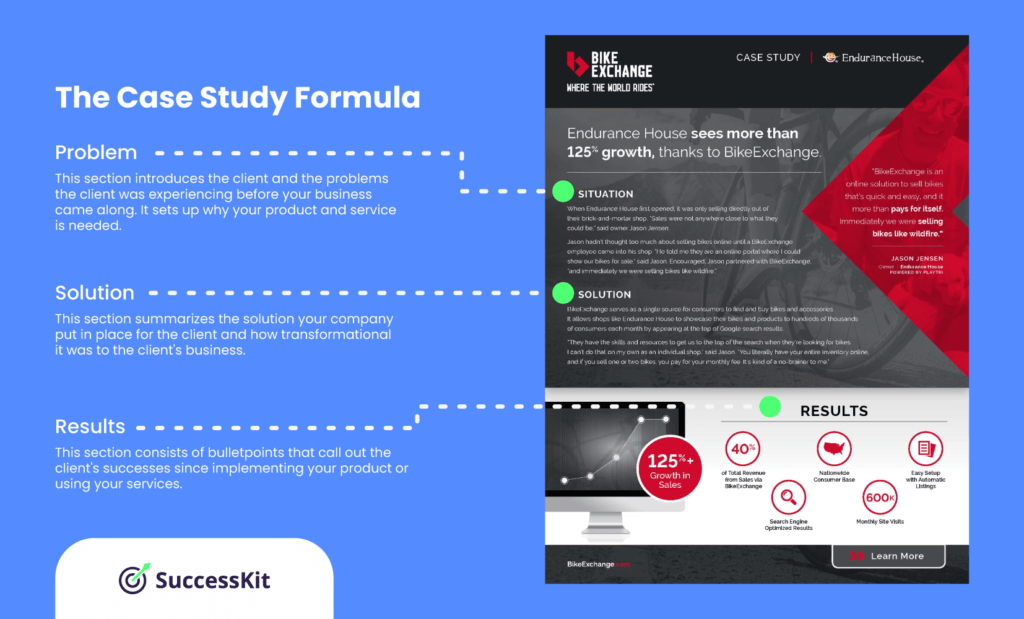
Structured Format
A successful Case Study follows a certain formula, namely the following:
- The Problem (or Situation) section introduces the client and the problems the client was experiencing before your business came along. It sets up why your product and service is needed.
- The Solution section summarizes the solution your company put in place for the client and how transformational it was to the client’s business.
- The Results (or Benefits) section consists of bulletpoints that call out the client’s successes since implementing your product or using your services.
By following this formula, the Case Study can’t help but tell the complete story —from start to finish.
Well-Written Content
A Case Study should not only be informative—it should also be organized and entertaining so that it compels prospects to keep reading. Don’t hesitate to hire a writer to ensure you wind up with a well-written product that flows logically from point to point. An editor is also crucial when it comes to polishing the work. Remember: You’re going to use this Case Study to generate more business for yourself, so it should be professional.
High-Quality Design
The design of a Case Study is going to be the very first thing a prospect notices about it, so it’s worth investing in. After all, this will be a tool used by both your sales and marketing teams. It’s going to be used a lot to attract new clients and it should look fantastic.
Make sure you have the right software (and people who know how to use it) in order to create an eye-catching, cohesive Case Study template. Consider hiring a designer experienced in creating layouts if you need to. This individual will also be able to effectively apply your branding and incorporate graphics, icons, charts, and other interesting and relevant visual elements to the document.
Successful Clients
Make sure the showcased client—the subject of your Case Study—is one who has reason to be truly enthusiastic about your business. When selecting a Case Study subject, consult with your sales or account management teams to learn which clients have enjoyed increased revenue, site traffic, and so on thanks to your company’s product or service. Clients who’ve seen real results are more likely to agree to feature in your Case Study and speak highly of your company.
Examples of High-Quality Case Studies
Take a look at our library of Case Studies to get an idea of what yours should look and read like. Note that each template is tailored specifically to each client, and they all follow the Problem > Solution > Results formula.
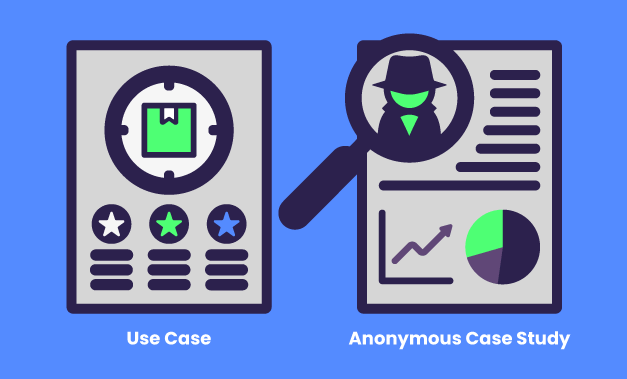
What If My Client Won’t Participate in a Case Study?
You absolutely must get your clients’ permission to feature them in your Case Studies; their participation, names, logos, images, and quotes bolster any claims made. However, clients tend to grant different levels of approval varying from full and partial participation to no participation at all. Some clients will provide you with unrestricted access to their brand assets, while others may agree to be interviewed but refuse to let you publish the Case Study. It’s also possible that clients may grant full permission only after seeing a draft.
You can increase the likelihood that your clients will grant permission by having positive relationships with them before you start and being transparent about the Case Study process. But whatever combination of approvals and permissions your clients provide, you need to fully understand them—and ensure they’re fully documented—before doing any work on the Case Study. Doing this will avoid any costly mistakes or wasted time—or even legal issues .
If your client can’t agree to a Case Study, that’s not a problem. You can opt to use the information you do have about the client and your offering to create a Use Case or an Anonymous Case Study.
A Use Case features your company’s product or service and explains how it might be used in a real-world scenario. It focuses purely on your offering and doesn’t mention a specific client.
Meanwhile, an Anonymous Case Study is just what it sounds like: a Case Study about a client without any identifying information. This type of Case Study can be created with or without the client’s full participation. If you have full participation, you’ll refer to the subjects of the Case Study by their job titles instead of their name. You’ll also use descriptive terms to refer to the client’s business (e.g., “a farm-equipment manufacturer in New Jersey”). If you have no client participation, you’ll use quotes and anecdotes from members of your in-house team who are familiar with the client.

How Do I Conduct a Case Study Interview?
Before the interview.
If your client agrees to be interviewed for the Case Study, it’s time to gather and create some key information in preparation for the interview.
Background Details About the Client
In order to ask insightful questions, you’re going to have to do a little research first. Ensure you have a full understanding of the value you’ve brought to your client’s business. Collect statistics and figures that emphasize how your client’s business improved since your involvement. Talk to the members of your in-house team who’ve worked with your client to get the inside scoop about what your client is most excited or concerned about.
Interview Questions
Develop some questions that concern the three key areas of the Case Study (i.e., the Problem, Solution, and Results). The following are examples of each:
- “What was your company like before working with us?” (Problem)
- “In what ways does using our product change your day-to-day operations?” (Solution)
- “How does our product help you to grow as a company?” (Results)
Use the background information you collected to help craft these questions. You’ll have already learned what aspects of your offering that your client is most excited about. Use that information to guide your questioning to get some enthusiastic responses.
During the Interview
Start the Case Study interview by setting expectations . Define the purpose of the interview and state how long it will take. Remind the client that the interview is being recorded and confirm permissions given (or not given) before getting underway.
Then, conduct the interview in the same order that the Case Study will have—again, the Problem, Solution, and Results.
Questions About the Problem
When asking questions about the problem, push beyond surface-level answers like “Our manual data-entry process was a pain.” Learn the full extent to which the problem impacted the client’s profits, customers, growth, and so on. (For example, “Because our employees had to spend so much time manually entering data, they didn’t have time to give our customers quality service and support.”)
Questions About the Solution
When asking about the solution, connect the dots between your offering and your client’s problem. For example, “How have your day-to-day operations changed now that our software has automated your previously manual data-entry process?”
Questions About the Results
If you collected key metrics about the client, it’s time to bring them up when talking about the results. (For instance, “How did our software save your employees two extra hours every day?”) If the client doesn’t have specific figures to share, go for qualitative results by asking opinion-based questions (“How has our software made your employees more efficient?”).

How Do I Write and Design a Case Study?
When the interviews conclude, it’s time to get into the actual creation of your Case Study. The blank page can be daunting, so to energize the process, copy and paste the transcript of your client interview into a word processing program. Whittle away any irrelevant conversation, and then organize the content into the three main sections. (Yep, Problem > Solution > Results come into play once again!)
Then, use this skeleton to actually write your Case Study . The story should flow logically. Avoid being redundant with quotes and facts—pick the very best phrasing and go with that. Make your client look good, especially if you’ve only received partial or restricted approval . (This increases the chances the client will grant full approval.)
If you get stuck, consult our free Case Study Template . It offers prompts and visual cues to provide you with enough inspiration and direction to produce an impactful piece of content.
Once you’ve written (and edited!) the Case Study, have your client review the text. You don’t want to go forward with the design phase without your client signing off on the text; the client may request substantial changes that will dramatically alter the design. Also, this creates an opportunity for the client to grant that highly desired full, unrestricted approval .
When the time comes to design your Case Study , aim to create a layout that’s attractive and easy to read. Clearly indicate the Problem/Solution/Results sections. Additionally, incorporate your company branding guidelines and visuals such as images, graphs, charts, icons, and so on.
Remember: If you’re really struggling with writing, editing, and/or designing your Case Study, bring in help from a third party. Hire someone with experience who knows what to do to create a high-quality, professional Case Study.
It’s time for the final round of client approvals once you’ve completed your Case Study design. The client shouldn’t have too many changes at this point. At most, the client may point out a typo, provide a new image, or request a quote revision. Furthermore, the client isn’t approving the design—that’s your company asset with your branding. This is a courtesy to the client (and yes, a last chance to get full permission if you haven’t yet received it). Your client invested time in helping you create this, so it stands to reason that the client should see how it turned out!

What Do I Do with My Case Studies?
Even the most brilliant Case Studies are no good if no one ever reads them. This section lists a few ideas for what you can do with your Case Studies once they’re finished.
The Sales Cycle
Case Studies can be effectively used in outbound sales prospecting . This is especially true if the prospect has a similar business and/or problem to the client featured in the Case Study. Members of the sales team should use the Case Study to craft tailored messaging to prospective clients .
Marketing Campaigns
A Case Study is a gold mine for a marketing campaign . Pieces of it can be used for so many different purposes. This includes ad and newsletter content, website features, and nurturing efforts.
Social Media Content
Social media is a great place to share your Case Studies. Craft your post so that it intrigues your target audience to the point where they can’t help but want to know more. Make it short, mysterious, and personal.
Creating Case Studies involves a significant amount of work. However, they’re worth the time, money, and energy to create because they’re tools you’ll use to grow your business.
If you need guidance with your Case Study projects, reach out to us at [email protected] . SuccessKit is here to help !

Stef Mates, SuccessKit's Creative Director, has been writing, designing, editing, and managing a variety of content types for several different industries for more than 15 years. She started at the company as a freelancer in November 2019 and became an official part of the team in June 2021.
Recent Posts
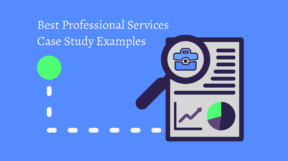
Best Professional Services Case Study Examples
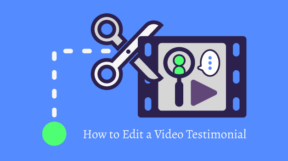
How to Edit a Video Testimonial
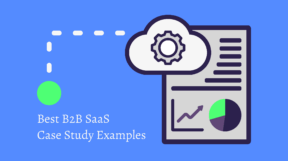
Best B2B SaaS Case Study Examples
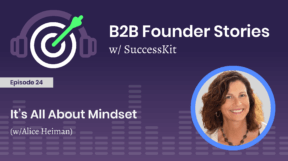
It’s All About Mindset (w/Alice Heiman) [PODCAST]
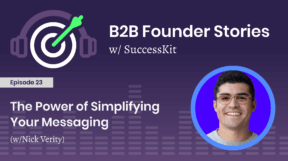
The Power of Simplifying Your Messaging (w/Nick Verity) [PODCAST]
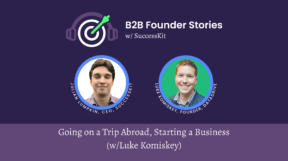
Going on a Trip Abroad, Starting a Business (w/Luke Komiskey) [PODCAST]

The Business of Podcasting, and How to Market Organically (w/Jeremy Shere) [PODCAST]
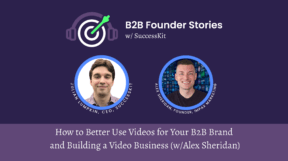
How to Better Use Videos for Your B2B Brand and Building a Video Business (w/Alex Sheridan) [PODCAST]
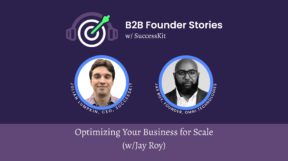
Optimizing Your Business for Scale (w/Jay Roy) [PODCAST]

How to Write a Case Study
Leave a comment, leave a reply cancel reply.
Your email address will not be published. Required fields are marked *
Save my name, email, and website in this browser for the next time I comment.
What people are saying
Milo Sindell President, Skyline G
“If you’re looking for Case Studies, this is a really nice little organization to partner with. Our experience, frankly, has been excellent.”
Franklyn Peart Co-Founder, CentreStack
“We’re already recommending SuccessKit to our customers.”
John Morgan Director of Marketing, Elemental Machines
“The SuccessKit team has been great. We can tell them, ‘ABC Company had this problem,’ and they will document our solution.”

Don Mennig CEO, Evolve IP
“Julian and his team have done an excellent job for us. Definitely recommend working with them for Case Studies. ”

David Bohram Director of Marketing, Tax Guard
“I didn’t think it’d be successful to outsource Case Studies, but Julian and his team made it so easy.”

Erin Wathen Director of Branding and Events, Assure
“I really appreciate how SuccessKit takes the reins and produces such great results, allowing us to focus on what we need to do to grow the business.”

Damon Baker CEO, Lean Focus
“SuccessKit’s Case Studies give us a distinct advantage over our competition when prospects are comparing service providers.”

Chris Connor Sales Manager, SwervePay
“We’ve really appreciated the work that Julian and his team have done for us. Very happy with the results.”
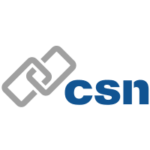
Shawn O’Daniels CEO, CSN
“SuccessKit figured out how to show the world what we do for our clients. I am blown away by the Case Study .”

James Dirksen CEO, DeepSurface Security
“This is just about the best Case Study I’ve ever seen.”

Christopher Levy CEO, BuyDRM
“The Case Study SuccessKit created for us was elite.”

Kendall Kunz CEO, Forms On Fire
“SuccessKit made it easy for clients to see what other clients see, and it’s led to more sales.”

Phil Curtolo Vice President of Sales, Software Consulting Services
“SuccessKit takes the pain and suffering out of creating quality Case Studies.”

Luke Anemone CEO, COMMANDO
“Working with SuccessKit has been pivotal in growing our client base and giving potential advertisers really good content about what we can do.”

Linze Kay Lucas Business Analyst and SEO Consultant, Stellium SEO
“I cannot speak highly enough about my experience working with SuccessKit. They were completely respectful of my client’s time and needs, as well as my own.”

Joanie Berkery Marketing Director, Adapex
“SuccessKit really helped us build the framework and presentation for our Case Study.”

Troy Stein VP, Customer Advocacy, TechSmith
“Quality results. Authentic storytelling and quotes. Easy to work with. I’m signing up for more.”

Julie Matheney Associate Director of Digital Marketing, Feathr
“I highly recommend the SuccessKit team to anyone who’s looking to produce Case Studies.”

Robin Smith Founder and President, ASK-CRM
“We are definitely recommending SuccessKit to the peers that we work with and our existing clients.”

Ace Rosenstein President, Bravo Business Media
“I recommend SuccessKit due to the efficiency and the extreme price to value.”

Ari Haas Founder, Dijy
“The SuccessKit team knows what they’re doing. It’s easy to work with them, the end result is a beautiful product, and all parties involved feel super comfortable.”

Sidney Rogers Marketing Manager, Groove Technology Solutions
“The SuccessKit team is very professional, and they ensure that they take care of everything in a timely manner.”

Ashlyn Burgett Director of Marketing, Dedicated IT
“The SuccessKit team makes the Case Study process painless, and they have the expertise to create high-quality content that is invaluable to sales and marketing teams.”

Carly Brightwell Head of Marketing, North Labs
“If you need Case Studies for your business, we highly recommend SuccessKit. We recieved exactly want we asked for!”

Luke Komiskey Founder and Managing Director, DataDrive
“I love working with the SuccessKit team because they make it really easy for me to focus on my business while they produce Case Studies that drive our brand forward.”
Have a question? Reach out to us directly.
How to Define Your Case Study Strategy (And Why You Need One)
Unfortunately, few companies have a defined customer case study strategy in place.
Often, they’ll just identify a good customer or project (“This would make a great case study!”) and then fly at it.
If they get that case study done, they may eventually turn to another good candidate and repeat the process.
And that’s as far as it goes.
But when you take this piecemeal approach, and overlook the strategy piece, you may run into the following problems:
- You struggle to get customers to agree to participate in your case study
- You get agreement but then struggle to find the right people to interview
- You feel weird asking because the engagement is over and done with
- You completed one (or maybe two) case studies but the rest have stalled
- Your completed case studies focus on a solution or industry you’re trying to transition away from
- All your case studies are over a year old
- Your case studies are relegated to some sad part of your website.
You don’t want to plunge in without a plan.
Instead, start by developing a strategy to guide your efforts and keep the case study train going.
Developing Your Case Study Strategy
So how do you develop a case study strategy?
You start by asking these three questions BEFORE you get the customer on the phone:
Question #1: What is your goal?
Are you trying to promote a certain service? Drive a certain type of lead? Upsell part of your offering?
You need to know your main purpose before you start.
Question #2: Whom are you targeting?
Not all positions are the same. The pressures a CEO and CMO face are different than the pressures faced by someone in IT.
You need to know who you’re selling to because you want them to see themselves in the story.
After all, case studies are human stories . They’re not really about the company.
They’re about how you helped the people within the company succeed and reach their objectives.
Case studies are human stories. They’re not really about the company.
Question #3: how will you use them.
Will you relegate your case studies to the resources section of your website? (Hopefully not.)
Will you put them on your blog? Use them in outreach? Arm your sales team with them?
You need to know HOW you will use your case studies because that will influence the case study format and how you put them together.
Figure out the story you want to tell
Once you’ve asked yourself these questions, you can go deeper into figuring out the kind of stories you want to tell.
If you’re trying to promote a particular service , for example, you’ll want to speak with a customer who’s gone through the experience of implementing that service.
If you’re trying to promote a particular service within a particular industry , you’ll want to speak with a customer who’s implemented that service in that industry.
Or maybe you want to show leads that you solved a particular challenge within that industry with that service.
Or maybe you want to appeal to a particular role within that industry who implemented that particular service.
As you can see, you can define your “ideal” case study candidate by many factors, drilling down from service, to industry, to challenge, to role:
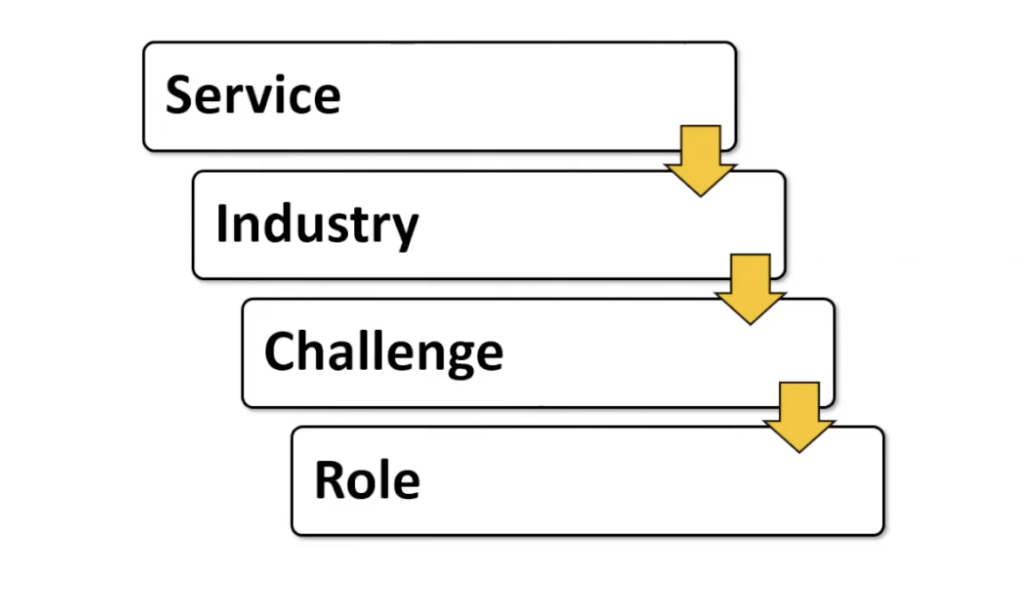
By considering all of these layers, you can figure out who on your client roster can give you the story you want.
Tip: Talk to your sales team
A possible shortcut in this kind of analysis is to talk to your sales team.
Salespeople need case studies like oxygen. They’re the most persuasive asset they have to close deals.
Customer success stories are the most persuasive asset your sales team has to close deals.
Your sales team will know the kinds of stories they need to share with leads and the most common problems and pushback.
So rather than huddling with your marketing team to develop your strategy , bring your sales team into the conversation.
The stories you tell will be the stories you attract
One last key point: The stories you tell will be the stories you attract.
If all of your case studies tell the story of how small accounting firms have used your software to grow, you will attract small accounting firms that want to use your software to grow.
Which is a problem if you want to attract bigger accounting firms, for example.
So think carefully about the stories you want to tell and plan accordingly.
Define your case study strategy BEFORE you start
It’s easy to overlook the strategy piece in your excitement to get started, but it’s super important.
Creating customer case studies isn’t easy. It takes time and resources to do well.
So when you do it, you want to make sure you’re doing it right.
Want our team to create those case studies for you—and help with the strategy piece?
Contact us to start the conversation.
Head of Writing and Interviewing
Based in Vancouver, Canada, Holly is pumped to tell stories of companies succeeding and doing good in the world.
Ya, you like that? Well, there’s more where that came from!
Should you send case study interview questions in advance.
Sending your case study interview questions to your interviewee in advance sounds like a no-brainer, doesn’t it? And certainly, if you type “should you send case study interview questions in advance” into Google, that’s the boilerplate advice everyone gives. But is that truly good advice? Or does it depend on the situation? At Case Study Buddy, we’ve conducted (literally) hundreds and hundreds of case study interviews, and we’re continually testing new and better ways of conducting them. And the answer...
Best AI Case Study Examples in 2024 (And a How-To Guide!)
Who has the best case studies for AI solutions? B2B buyers’ heads are spinning with the opportunities that AI makes possible. But in a noisy, technical space where hundreds of new AI solutions and use cases are popping up overnight, many buyers don’t know how to navigate these opportunities—or who they can trust. Your customers are as skeptical as they are excited, thinking… “I’m confused by the complexity of your technology.” “I’m unsure whether there’s clear ROI.” “I’m concerned about...
How to Write Cybersecurity Case Studies
When it comes to case studies, cybersecurity poses special challenges. The cybersecurity landscape is saturated with solutions—and so sales and marketing teams have never been hungrier for customer success stories they can share as proof of their product’s abilities. But cybersecurity clients are very reluctant to be featured. They don’t want to talk about the time they almost got hacked, they don’t want to disclose the details of their setup and risk more attacks, and they just plain don’t want...
Let’s tell your stories together.
Get in touch to start a conversation.
Free tracking template:
How to capture video, testimonials at live events.
Free Report:
The big list of 100 ways to use your case studies.
If your case studies and video testimonials live only on the customer success page of your website, you’re missing out. You can do SO MUCH MORE with these versatile assets.
Get our actionable guide to using case studies across your sales and marketing funnel (and beyond) to wring out every ounce of value.

13 Important Tips To Use Sales Case Studies Effectively: The Do's And Don'ts
Sales case studies are a type of sales research that can be used for various purposes. They can help sales teams identify the most effective sales strategies, educate salespeople about what to do and how to do it, and provide clear evidence of successes and failures.
Sales case studies are the sales professional's best friends, and they tell you what to do and how to do it to generate more sales for your business. Sales professionals who don't keep sales cases studies around as often as they wonder sales aren't going up as they should be.
Case studies are the best way to learn sales strategies that have worked for other sales professionals. They can be found, stored, and used effectively in many different ways. Let's hop onto some basics.
What Is a Sales Case Study?
A sales case study is a sales research method where sales professionals and businesses share their experiences by providing documented examples of what has worked for them.
They can be used to demonstrate success, but they are most valuable when shared as a learning tool so that other sales teams learn from the successes and failures of others. Sales cases studies don't just tell you what works – they also show you exactly how it was done!
Case studies allow you to define your product in the way you want, and they let you create one of the most valuable and difficult-to-find assets in sales confidence. This is why case studies are one of your most powerful sales tools.
A case study in sales is any story, data, or evidence of your product or service benefitting a customer. The sales case study may include:
- ROI and sales data.
- Reports from customers who have benefited from the product or service.
- Insights into how you can implement this strategy in your own sales business.
How Do Case Studies Work?
The key with sales case studies is knowing how to find ones relevant to your business or field, knowing which details matter most.
For example, the information within them has meaning, deciding who will use those insights (yourself alone or as part of a team), and making sure that case studies are stored and used for sales strategy in the long term.
Case studies differ from sales statistics because they are a narrative, and they allow sales professionals to read an account of what happened and see how it can be applied to their own sales strategies in real life.
Being able to use case studies effectively is contingent upon finding ones that apply directly or indirectly but tangibly enough for them to make sense as inspiration, instruction, or evaluation for your business's sales process.
The Value of a Sales Case Study?
Case studies tell sales professionals precisely what to do and how to do it. While there is no single sales strategy that works for every sales professional, case studies can help demonstrate the effectiveness of specific techniques.
They also provide a documented example of real-life results so other salespeople know if an idea could work or not without having to guess at all!
Sales cases studies are most effective when used as part of a learning session where everyone on the sales team learns from examples of sales success. They are most valuable when shared with salespeople across different companies and business units, as each case study is unique to the company that produced it.
Sales teams should look for sales strategies that work in similar or related fields (if possible) but that do not overlap too much – this will help inspire new ideas without unnecessarily limiting them.
How Can I Use Sales Case Studies Effectively?

There are many ways you can use case studies effectively:
- As part of your personal development , share relevant examples with yourself when preparing for important meetings or phone calls.
- As part of training sessions where new hires learn from experienced members on your team
- As resources shared among groups who want more information about common challenges they're facing.
- As sales tools that you can use to promote your products and services.
The Do’s of case studies:
- Create a Case Studies page on your sales website
Start building case studies on demand that you can share with potential customers
Approach companies who are having challenges similar to the ones your product or service addresses.
Ask if they would consider sharing their sales case study to demonstrate how much progress was made after incorporating it into their sales process.
Share relevant case studies internally among teams to inspire new ideas for everything from marketing, operations, recruiting, etc.
Put case studies on your blog or LinkedIn page so they can be shared more easily. You can also use case studies to create a resource list that you share with potential customers, which will undoubtedly help them understand the value of working with you!
To find sales strategies that work for different industries and companies, look at examples of what has worked well in similar fields, but focus on those with some differences (this is how new ideas are created).
Highlight details beyond just pricing strategy when sharing sales cases study results. Create an easy-to-use system for storing all kinds of sales data.
- Include reviews in your case studies:
Case studies that include reviews from salespeople and customers are much more helpful than those that don't. Don't just use sales case study examples as a sales tool – create your very own sales case study to inspire others!
Sales professionals should share case studies across different companies to get new ideas for improving their strategies. Sales managers should look for sales techniques that have been proven successful but also consider trying out some of the ones from examples.
This will help teams gain inspiration without limiting them too much when it comes time to brainstorm new solutions as we advance.
- Make case studies easy to use :
Salespeople can easily pull up case studies on their mobile devices are much more helpful than those they have to print out. For example, include sales tools in sales case study examples.
Sales professionals who see sales techniques applied to real-life challenges will be inspired by them and want to try them themselves or with their team.
Create your own sales case study as a way of inspiring others – this is the best way of demonstrating how successful an idea was without having to rely solely on someone else's testimonial!
Sales teams should look at successful sales strategies and consider experimenting with ideas from outside fields where there may even be overlap (this is how new ideas are created).
Sales managers should seek out proven solutions when completing case studies and try out some of the ideas they learn about through examples, even if there's overlap with what you already know works well for your company.
- Create an easy system for storing all kinds of sales data:
Including receipts and notes makes future reports easier to read and understand than just numbers alone.
Highlight some vital elements for success to give other companies ideas about adapting these strategies for their industry or business model. Don't only focus on what has worked well; also look at creative ways someone else's idea didn't work out.
- Include CTAs in your Case Studies
Sales case studies are most useful when they also include some kind of call-to-action so salespeople can apply the strategies you highlight to their own sales efforts. CTAs help the users in clear navigation and what should be their next steps?
The Don’ts of case studies:
When it comes to case studies, there are a few dangers to avoid.
- Don't lie or stretch the truth.
This is self-evident in today's environment, and it is now easier than ever to fact-check. If you're discovered to be a liar, and trust you've gained — and most likely the sale itself — will be destroyed.
- Don't lose sight of who you're talking to.
As I said before, the case study should be comparable to the client you're addressing, and they shouldn't have to imagine how this might apply to them.
- In the case study, don't emphasize how fantastic your company is.
The emphasis should be on the client's advantage. You'll lose your customer focus if it sounds like propaganda or a sales pitch. When people believe they're being sold to, they'll usually stop listening or trusting you.
They'll become much more discerning in their approach to everything you say, wondering whether you're telling them the truth or not. Even though you never said it directly, they'll still walk away thinking your firm is excellent, even if you didn't mention it at all in the case study.
- Do not forget about data.

The more data you have, the better. A good story should be backed by facts, even if it is in a story form. This has the bonus of being able to use graphs and charts that are visually engaging. Did you know, 81% of customers read reviews and check ratings.
So, back up your claims and stories with data and stats that buckle you up for real success and improve your closing deals ratings.
Are Case Studies Effective?
Sales cases studies are practical when used correctly! An excellent place to start is by looking at examples online through platforms like Unbounce, where users have shared real-life results obtained using different methods.
Having access to this kind of information will help any sales professional find inspiration even when case studies are not directly applicable to the situation at hand.
When used correctly, case studies will help salespeople get into a winning mindset and inspire new ideas that can be implemented immediately using tried-and-true strategies from other companies that have successfully managed similar challenges.
13% of marketers name case studies as one of the primary forms of media used within their content strategy which makes case studies the 5th most popular content type preferred.
What Kind of Case Studies Should I Be Using?
There are different kinds of case studies for a variety of purposes. These include:
- Sales strategy case studies: They tell the story from beginning to end, demonstrating how a sales team was able to implement their plan by following best practices.
- Success stories – these provide evidence that the product or service works in real-world situations. They also highlight what worked well during a particular situation so others may be inspired by it!
- Failure stories – some companies choose not only to share what has been successful but also to talk about issues they faced along the way and why specific strategies didn't work out as planned. This may help salespeople avoid mistakes.
- Sales process case studies - sales processes can be challenging to describe in abstract terms, so many sales professionals choose to share step-by-step guides of how a sales team can get from one point to another.
This helps other sales professionals learn more about what they should or shouldn't do when following that particular strategy and why the result might look different for them, depending on their field/company's context.
Finding Case Studies: Where to Find Them?
The best place to find sales case studies is by asking sales professionals you know and trust, but if you can't do so in person, search online or ask your sales teammates!
The Internet can be a great tool when looking for case studies because many different kinds of businesses out there use them as part of their marketing strategies. When searching online, look for keywords that are relevant to your industry.
The most effective way of finding case studies is by hearing about them through word-of-mouth marketing – either within the industry, you work in or related fields.
It isn't always easy finding resources where these types of stories have been shared publicly before, so don't underestimate the power of reaching out to sales professionals you think have valuable case studies through an email or phone call.
Sales case studies are essential sales tools that help salespeople deliver effective presentations. They also inspire new ideas and strategies for successful selling!
Sales case studies prove the value of a product or service by showing real-life results from other companies. This is an excellent sales tool to use when pitching your company's services because it demonstrates how others have used similar methods with great success.
This validates that your approach will work too, even if you haven't tried it before. These types of stories can be shared in person during sales meetings and online through various social media channels like LinkedIn and Pinterest.
Where business professionals share their expertise with others looking for guidance on best practices within many different industries. There are so many case studies online that it can be hard to find the right one for your sales meeting or pitch.
Because of this, salespeople should always ask their customers about what they've done to get them into a positive buying state and build trust with potential leads/clients who may still need some convincing.
This is also an excellent way to start building rapport before asking if they'd like to share any case studies themselves!

Get Paid for Your Time
Join the marketplace for b2b pitches, meetings, and connections, see cliently in action, start engaging with your prospects, start engaging with your users and clients today, don't miss out, sign up for our newsletter.

Sales Case Study: How to Make a Sale in 7 Steps
Sales case studies are a great way to learn how to make a sale. I remember when I was first starting in sales, I would read as many sales case studies as I could get my hands on. They were a huge help in learning the ropes and understanding the different steps involved in making a sale. This sales case study will show you how to make a sale in 7 steps. By following these simple steps, you’ll be well on your way to becoming a top-performing sales rep!
Sales Case Study: Successful Sales Techniques
A sales case study is an important tool for sales teams. It can provide insight into how other companies have been able to successfully sell products and services and can help sales teams learn new strategies and techniques.
Additionally, sales case studies can help to identify potential customers and target markets.
What are Sales Case Studies and How Do They Help You?
A case study analyzes a specific instance –– or case if you will –– that shows how your product has been effective in solving a problem.
When you market with customer success stories, you allow your prospective customers to get to know your existing customers on a more personal level. This can help them see how your product has benefited other people, which can in turn make it easier for them to purchase.
Would you hire a company to produce video content for you if they just said, “We produce high quality, high return-on-investment (ROI) generating videos”?
Wouldn’t it be more beneficial for you to see the quality of their work first and read a personal recommendation from someone who has worked with them before through case studies? This way, you can make a more informed decision about whether or not this is the right company for your needs.
Most customers read reviews before making a purchase. This is because 81% of people do their research before buying anything.
B2B sales are just like any other kind of sale – the prospect does their research before committing to a purchase. To get an idea of what a company is like, it can be helpful to read reviews from past customers. This way, you can learn about a company’s reputation before making a decision.
Case studies are an excellent way to show your potential customers the benefits of your product or service. By reading about how other companies have benefited from using your product, they can see the logic behind your claims and also get a sense of what a satisfied customer looks like. This can help to remove any objections they may have about purchasing from you.
How to Write a Sales Case Study
The customer is a small business owner who needs help with bookkeeping and accounting. They have a goal of being able to track their finances and make better decisions for their business. We helped them by providing bookkeeping and accounting services. The result was that they were able to track their finances and make better decisions for their business.
B2B Case Study
88% of customers trust online reviews, so having testimonials and reviews on your site is a great way to establish credibility.
When you’re marketing to other businesses, case studies can be extremely impactful. Why? Because when your target audience reads about success stories within their industry, they’ll assume that the same approach will work for them.
Marketing Case Study
Case studies are an excellent way to show that you are comfortable in a specific field and familiar with industry-specific needs. By using case studies, you can demonstrate that you have the expertise to provide targeted results to that industry.
Sales Case Study Examples
Customer case studies are a particularly effective way of selling.
A sales case study is an in-depth look at how your service or product helped a client. It not only shows their opinion of your brand but highlights the results they achieved with you.
Make Impactful Statistics Pop in Your Sales Case Study
Case studies don’t have to be limited to just written words. You can include images, videos, and more.
To make your statistics pop in your sales case study, use icons to highlight areas that are particularly interesting or relevant. This will help your readers quickly identify the most important information in your study.

Icons are visual images that help to summarize important information quickly.
The use of icons in the business case study examples above helps to quickly represent areas of impressive growth and act as visual cues to help draw the reader’s attention to certain parts of the page.
Use High Contrast Shapes and Colors in Your Sales Case Study
Use contrasting colors and shapes to help your key info pop.
Use a different or complementary color scheme, or add a graphic such as a square or a circle.

This visual design uses blue boxes to separate the information to make it more readable.
This information is easily digestible and retainable for a potential customer, thanks to the use of icons and strong statistics.

8. Tips For Creating a More Effective Sales Case Study

Case studies are a powerful way to increase conversions and revenue.
They show how your product/service helps customers achieve their own goals.
An extensive, detailed, and specific case study that outlines your achievements and shows potential customers how you helped them achieve their goals.
Writing a compelling and action-oriented case study can be a real challenge. Most out there are boring, uninspiring, and fail to deliver all the information they should.
It’s time to change that. Here are 8 tips to help you create a more effective case study.
1. Write About Someone Your Customer Can Relate
If your target audience is in the education industry, then make a case study about one of your university clients .
If it’s related to the automotive industry, then make a case study about car parts and car accessories.
The purpose of your case study is to show that you are comfortable in their industry, you understand their specific needs, and you know how to deliver results.
Think about writing a how-to post for a blog. The content is geared toward average readers. But when you read a case study that deals with your industry and needs, you are much more likely to understand and apply the information presented.
The same can be said for case studies – people reading them will think that the same methods worked for the company.
This means you’ll need to write multiple case studies, each tailored to a different customer type.
2. Narrate a Story From Start to Finish
Storytelling is a powerful marketing tool. They allow readers to get to know your customers on a deeper level.
Who is the customer? What do they do? What are their needs and goals? How do you satisfy those needs so they can meet those goals?
Continue following up with your customer in your case studies and show how your solutions provide ongoing value.
In your case studies, be sure to include both the emotional benefits of your solutions as well as more concrete, measurable results.
Did your software help boost productivity, reduce turnover, or free up employees’ time? By including these metrics, you’ll provide your readers with a complete picture of how your services have helped your customers.
3. Make Your Case Study Easier to Read
No one likes reading large blocks of texts, regardless of how informative or entertaining they might be. Like a blog post, a case study should be easily scanned and readable.
Use the same elements of content and writing that you would for an article, blog post, or website copy.
When you’re writing a case study, use effective design elements like bold or italic fonts, bullet points, and header tags to help readers easily digest the information.
By including these simple, yet effective, techniques in your case studies, you’ll help readers find the information they’re looking for and better understand your value proposition.
In addition to writing blog posts, consider including videos and other types of media to spice things up.
Including images of your actual customers, screenshots of your results, or even videos of you explaining your process will help make your case studies more engaging.
4. Highlight Real Numbers
Have you ever wondered if doubled traffic in a case study meant going from 100 to 200 visitors or 10,000 to 20,000?
To strengthen your case studies, share exact figures. Show how much your increase in website traffic, sales, or whatever else matters to your clients.
This adds credibility to your case studies and builds trust with your audience.
Your case studies should be as detailed and as factual as humanly possible. Don’t just say you increased their website traffic by 50%, say you boosted their web traffic by 50%, and back it up with hard numbers.

It’s important to provide context when sharing these statistics. Explain why they’re important to you and your company.
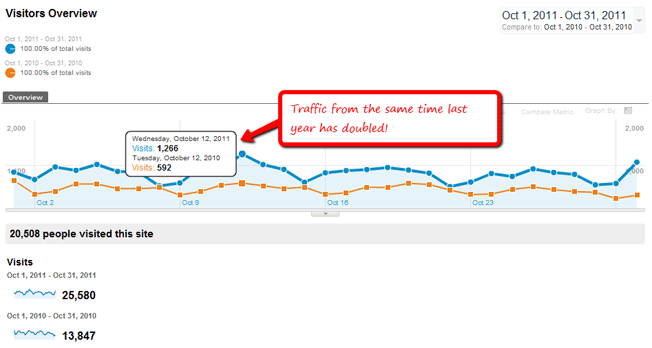
By showing your customers’ journeys, you can show readers how you’ve helped customers get to where they are now.
Including before and after photos in your case studies helps your readers visualize the results you achieved for your clients. Seeing these before and after shots lets your prospects know that you are capable of achieving similar results for them.
5. Talk About Specific Strategies
So, you managed to improve your client’s web traffic? How did you do it?
This is where you tell the prospect which products or services you used to achieve your goal.
“Thanks to our digital marketing strategies, we increased website traffic from 2,000 to 15,000 visitors a month in just three months. Our social media marketing campaigns on Facebook and Youtube helped increase our brand awareness, and our link-building campaigns helped us rank higher on search engines.”
Don’t worry about giving away your secrets — your goal here is to establish yourself as a thought leader and showing that you know your stuff is key to that.
6. Test Different Content Formats
You don’t have to always write case studies in story format.
Try interviewing your clients and asking them the same questions, such as how they started their business, what their goals are, and what you did to help them.
Be sure to include quotes from your customers in your case studies. This will make your stories more believable and relevant to your prospects than if you were to tell your story yourself.
If you’re looking for ways to make your case studies more engaging, consider using infographics, webinars, or podcasts. These formats can help you capture your audience’s attention and communicate your key points more effectively. Experiment with different content types to see what works best for your business and your customers.
When Vortex switched to a brochure style, they noticed a significant boost in conversion rates. Their case studies highlight exactly how they achieved those results and can help convince customers that the same techniques will work for them.
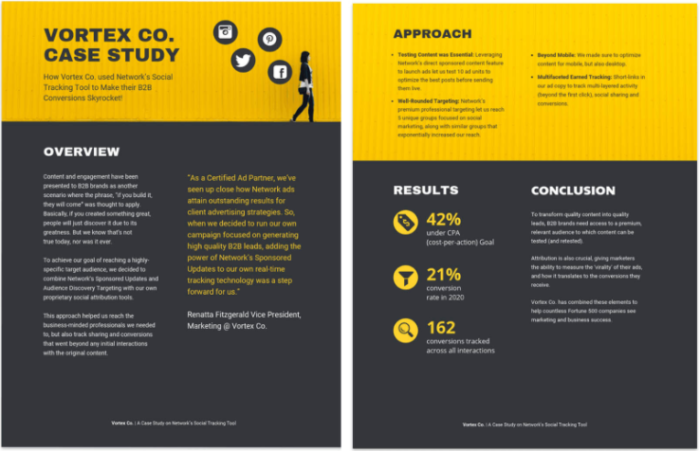
7. Repurpose Your Case Study for Different Audiences
While some people are happy reading your text-based case studies, other people may like to listen to them, watch them, or see them in a visual format. So, take your written content and repurpose it as a podcast, a YouTube video, or an engaging infographic.

The main benefit of video marketing is that videos are easily sharable. This means that your case study could reach more potential customers.
You can embed case studies in ebooks, blog posts, and resource guides. You can also link your case study to posts that prove your value and mention them in webinars.
8. Make Your Case Study Easily Accessible
What’s the point of creating a great case study if no one ever reads them? Be sure to organize your case studies in a way that makes them easy to locate.
List them on your website, optimize them for search engines, and promote them on your social media accounts.
Here are a few examples of easy-to-find case studies.
Amazon Web Services
If you’re in an industry like manufacturing, finance, or fitness and are looking for a case study, check out what Amazon Web Services has to offer. With AWS Digital Asset Management , industries like manufacturing, finance, or fitness can leverage a centralized, secure, and easily accessible platform to manage their extensive digital assets, simplifying the workflow while ensuring data integrity and accessibility.
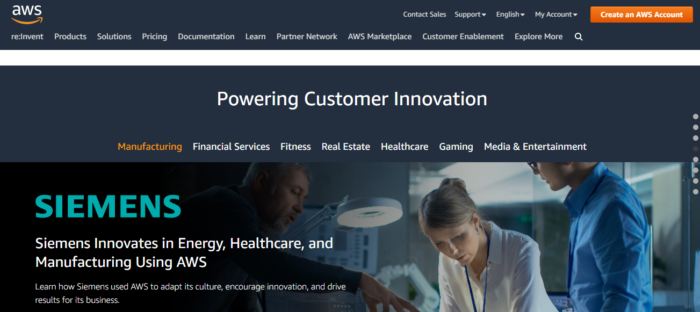
The case study section on the landing page for drupal.org features several success stories from major brands, making it simple to see how Drupal can help your business.
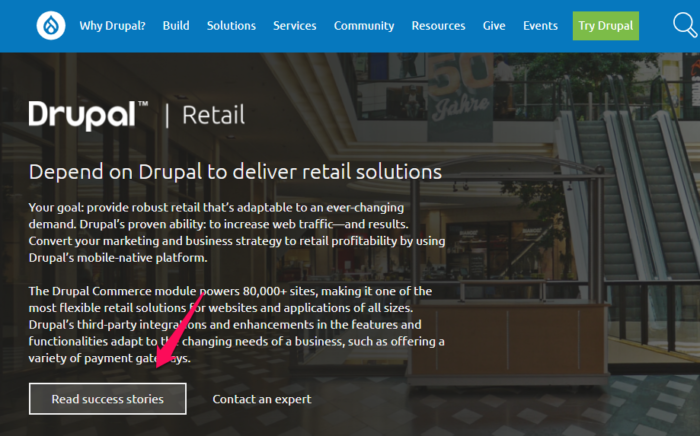
How to Use Case Studies in Marketing
Follow up your case studies with blog posts that highlight a challenge or obstacle that your customer or company faced. Then, show the steps you took to overcome that issue.
In your post, show the steps you took to solve these issues.
Let’s say we had a client case study that detailed how a company used videos to build their trust. We might write a blog post that was called “Using Videos To Build Your Brand’s Credibility”.
A customer success blog post should focus on how your customers overcame their challenges and used your product or service to do so.
Most customers don’t want to spend a long time reading through a long explanation when they’re buying something. It’s much easier for them to watch the video that explains the service or product quickly. Our research shows that 96% of buyers would prefer watching a short video over having to read long explanations.
It’s easier for them and saves time if they view a video that gives them all the information they’re looking for.
Including statistics, and data, and ending with a call to action, video case studies are a great way to show your prospect how your product/service has benefited someone else.
If you can demonstrate to your prospects how your product or service is helping them solve their problem, you will be in an excellent spot.
Through videos, you can establish an emotional connection between your brand, product, and customers. Having satisfied customers explain the benefits of your product will help build a stronger relationship with your prospects.
This leads to more sales and more loyal clients.
You can display your testimonials or customer success stories directly on your home page. This will show web visitors that other people have had success with your product or service.
How to Present Your Case Studies
Here are a few suggestions for how to display your success stories:
- Feature a quote from your case study on your homepage
- Create a dedicated page featuring your testimonial or video case study
- Include a graphic or image of your case study
Email Marketing
Case studies are a great way to connect with those already-cold, disengaged contacts and re-ignite their interest.
Our preferred method is product-specific segments.
Do you have case studies from a specific product or service? Look at your analytics to see who was at one time interested in it.
Then, send an email to your subscriber list with your case study.
Social Media
Case studies are an easy way to promote your business on social.
Share a link to your customer’s success story and mention them.
To get the most out of a case study, post the case study in a way where readers are inspired to action. Focus on the benefits, be direct, and link to the page.
What other creative ways can you think of to use social media to promote your case study?
There are many ways to use a case study on social media.
You can show your happy, smiling face with a testimonial on your Facebook page, your Twitter account, and your LinkedIn profile.
You can also share your case study on LinkedIn, or add it to your company’s page.
Finally, you can post your case studies in related Facebook groups, or tweet about them. By doing all of these things, you will increase your engagement, and reach more potential clients.
According to Accenture, 41% of customers switched to a different business due to a lack of personalized communication.
When quoting your case studies, choose quotes that are specific to how your company helped the customer or quote metrics that demonstrate what the results were.
“We were able to increase the number of our email list by 80% in only a year. Their professionalism, dedication, and results speak for themselves.”
These quotes are a great way to boost your social media presence and website views.
Newsletters
Case studies can be included in your newsletter to both attract new potential clients and solidify your relationship with existing ones.
When companies focus on their customers, they not only improve relationships with current clients but can also attract more business. It’s natural to want to be part of a group, and when customers see that a business cares about them, they’re more inclined to support that company.
Case Studies for sales teams
Did you know that 70% of B2B customers do their research before even speaking to a sales rep? And 44% of those same people are looking for a specific solution before reaching out to a salesperson.
As customers become more and more educated, sales reps need content that speaks to each stage of a buyer’s journey. This ensures that reps are providing customers with information that’s relevant to their stage in the buying process.
Case studies are an excellent way to showcase your successes.
Have you heard of the saying “right place right time”?
Case studies are a great way to build credibility and trust with potential buyers. By showing past successes, you can demonstrate to potential clients that your product works.
What is a Sales Case Study?
To recap, a sales case study is a written document that describes a sales process from start to finish. It details the challenges faced by the salesperson and how they were overcome. A sales case study can be used to teach best practices, highlight successes, and identify areas for improvement.
A good example of a case study is a research paper that analyzes a particular subject in depth. Case studies are usually conducted on people, businesses, or organizations, and they often involve interviews and observation in addition to secondary research.
A sales case study is a great way to learn how to make a sale. This sales case study has shown you how to make a sale in 7 steps. By following these simple steps, you’ll be well on your way to becoming a top-performing salesman or woman!
Need Help Automating Your Sales Prospecting Process?
LeadFuze gives you all the data you need to find ideal leads, including full contact information.
Go through a variety of filters to zero in on the leads you want to reach. This is crazy specific, but you could find all the people that match the following:
- A company in the Financial Services or Banking industry
- Who have more than 10 employees
- That spend money on Adwords
- Who use Hubspot
- Who currently have job openings for marketing help
- With the role of HR Manager
- That has only been in this role for less than 1 year
Want to help contribute to future articles? Have data-backed and tactical advice to share? I’d love to hear from you!
We have over 60,000 monthly readers that would love to see it! Contact us and let's discuss your ideas!
About Author: Justin McGill
Read our ultimate guides on:.
- B2B Lead Generation
- Google Alerts
- Account Based Marketing
- Prospecting
- LinkedIn Sales Navigator
- Sales Strategy
- Cold Calling
- Sales Pitch
Share the Knowledge
Find fresh leads, instantly., contact data for 500m+ people and 10m+ companies, globally., leads are cleaned and verified in real-time., build lists for custom audience ad targeting, direct mail, cold email, social selling, or even cold calling campaigns..

Helping sales, marketing, and recruiting teams find new leads.
How to write a case study — examples, templates, and tools

It’s a marketer’s job to communicate the effectiveness of a product or service to potential and current customers to convince them to buy and keep business moving. One of the best methods for doing this is to share success stories that are relatable to prospects and customers based on their pain points, experiences, and overall needs.
That’s where case studies come in. Case studies are an essential part of a content marketing plan. These in-depth stories of customer experiences are some of the most effective at demonstrating the value of a product or service. Yet many marketers don’t use them, whether because of their regimented formats or the process of customer involvement and approval.
A case study is a powerful tool for showcasing your hard work and the success your customer achieved. But writing a great case study can be difficult if you’ve never done it before or if it’s been a while. This guide will show you how to write an effective case study and provide real-world examples and templates that will keep readers engaged and support your business.
In this article, you’ll learn:
What is a case study?
How to write a case study, case study templates, case study examples, case study tools.
A case study is the detailed story of a customer’s experience with a product or service that demonstrates their success and often includes measurable outcomes. Case studies are used in a range of fields and for various reasons, from business to academic research. They’re especially impactful in marketing as brands work to convince and convert consumers with relatable, real-world stories of actual customer experiences.
The best case studies tell the story of a customer’s success, including the steps they took, the results they achieved, and the support they received from a brand along the way. To write a great case study, you need to:
- Celebrate the customer and make them — not a product or service — the star of the story.
- Craft the story with specific audiences or target segments in mind so that the story of one customer will be viewed as relatable and actionable for another customer.
- Write copy that is easy to read and engaging so that readers will gain the insights and messages intended.
- Follow a standardized format that includes all of the essentials a potential customer would find interesting and useful.
- Support all of the claims for success made in the story with data in the forms of hard numbers and customer statements.
Case studies are a type of review but more in depth, aiming to show — rather than just tell — the positive experiences that customers have with a brand. Notably, 89% of consumers read reviews before deciding to buy, and 79% view case study content as part of their purchasing process. When it comes to B2B sales, 52% of buyers rank case studies as an important part of their evaluation process.
Telling a brand story through the experience of a tried-and-true customer matters. The story is relatable to potential new customers as they imagine themselves in the shoes of the company or individual featured in the case study. Showcasing previous customers can help new ones see themselves engaging with your brand in the ways that are most meaningful to them.
Besides sharing the perspective of another customer, case studies stand out from other content marketing forms because they are based on evidence. Whether pulling from client testimonials or data-driven results, case studies tend to have more impact on new business because the story contains information that is both objective (data) and subjective (customer experience) — and the brand doesn’t sound too self-promotional.

Case studies are unique in that there’s a fairly standardized format for telling a customer’s story. But that doesn’t mean there isn’t room for creativity. It’s all about making sure that teams are clear on the goals for the case study — along with strategies for supporting content and channels — and understanding how the story fits within the framework of the company’s overall marketing goals.
Here are the basic steps to writing a good case study.
1. Identify your goal
Start by defining exactly who your case study will be designed to help. Case studies are about specific instances where a company works with a customer to achieve a goal. Identify which customers are likely to have these goals, as well as other needs the story should cover to appeal to them.
The answer is often found in one of the buyer personas that have been constructed as part of your larger marketing strategy. This can include anything from new leads generated by the marketing team to long-term customers that are being pressed for cross-sell opportunities. In all of these cases, demonstrating value through a relatable customer success story can be part of the solution to conversion.
2. Choose your client or subject
Who you highlight matters. Case studies tie brands together that might otherwise not cross paths. A writer will want to ensure that the highlighted customer aligns with their own company’s brand identity and offerings. Look for a customer with positive name recognition who has had great success with a product or service and is willing to be an advocate.
The client should also match up with the identified target audience. Whichever company or individual is selected should be a reflection of other potential customers who can see themselves in similar circumstances, having the same problems and possible solutions.
Some of the most compelling case studies feature customers who:
- Switch from one product or service to another while naming competitors that missed the mark.
- Experience measurable results that are relatable to others in a specific industry.
- Represent well-known brands and recognizable names that are likely to compel action.
- Advocate for a product or service as a champion and are well-versed in its advantages.
Whoever or whatever customer is selected, marketers must ensure they have the permission of the company involved before getting started. Some brands have strict review and approval procedures for any official marketing or promotional materials that include their name. Acquiring those approvals in advance will prevent any miscommunication or wasted effort if there is an issue with their legal or compliance teams.
3. Conduct research and compile data
Substantiating the claims made in a case study — either by the marketing team or customers themselves — adds validity to the story. To do this, include data and feedback from the client that defines what success looks like. This can be anything from demonstrating return on investment (ROI) to a specific metric the customer was striving to improve. Case studies should prove how an outcome was achieved and show tangible results that indicate to the customer that your solution is the right one.
This step could also include customer interviews. Make sure that the people being interviewed are key stakeholders in the purchase decision or deployment and use of the product or service that is being highlighted. Content writers should work off a set list of questions prepared in advance. It can be helpful to share these with the interviewees beforehand so they have time to consider and craft their responses. One of the best interview tactics to keep in mind is to ask questions where yes and no are not natural answers. This way, your subject will provide more open-ended responses that produce more meaningful content.
4. Choose the right format
There are a number of different ways to format a case study. Depending on what you hope to achieve, one style will be better than another. However, there are some common elements to include, such as:
- An engaging headline
- A subject and customer introduction
- The unique challenge or challenges the customer faced
- The solution the customer used to solve the problem
- The results achieved
- Data and statistics to back up claims of success
- A strong call to action (CTA) to engage with the vendor
It’s also important to note that while case studies are traditionally written as stories, they don’t have to be in a written format. Some companies choose to get more creative with their case studies and produce multimedia content, depending on their audience and objectives. Case study formats can include traditional print stories, interactive web or social content, data-heavy infographics, professionally shot videos, podcasts, and more.
5. Write your case study
We’ll go into more detail later about how exactly to write a case study, including templates and examples. Generally speaking, though, there are a few things to keep in mind when writing your case study.
- Be clear and concise. Readers want to get to the point of the story quickly and easily, and they’ll be looking to see themselves reflected in the story right from the start.
- Provide a big picture. Always make sure to explain who the client is, their goals, and how they achieved success in a short introduction to engage the reader.
- Construct a clear narrative. Stick to the story from the perspective of the customer and what they needed to solve instead of just listing product features or benefits.
- Leverage graphics. Incorporating infographics, charts, and sidebars can be a more engaging and eye-catching way to share key statistics and data in readable ways.
- Offer the right amount of detail. Most case studies are one or two pages with clear sections that a reader can skim to find the information most important to them.
- Include data to support claims. Show real results — both facts and figures and customer quotes — to demonstrate credibility and prove the solution works.
6. Promote your story
Marketers have a number of options for distribution of a freshly minted case study. Many brands choose to publish case studies on their website and post them on social media. This can help support SEO and organic content strategies while also boosting company credibility and trust as visitors see that other businesses have used the product or service.
Marketers are always looking for quality content they can use for lead generation. Consider offering a case study as gated content behind a form on a landing page or as an offer in an email message. One great way to do this is to summarize the content and tease the full story available for download after the user takes an action.
Sales teams can also leverage case studies, so be sure they are aware that the assets exist once they’re published. Especially when it comes to larger B2B sales, companies often ask for examples of similar customer challenges that have been solved.
Now that you’ve learned a bit about case studies and what they should include, you may be wondering how to start creating great customer story content. Here are a couple of templates you can use to structure your case study.
Template 1 — Challenge-solution-result format
- Start with an engaging title. This should be fewer than 70 characters long for SEO best practices. One of the best ways to approach the title is to include the customer’s name and a hint at the challenge they overcame in the end.
- Create an introduction. Lead with an explanation as to who the customer is, the need they had, and the opportunity they found with a specific product or solution. Writers can also suggest the success the customer experienced with the solution they chose.
- Present the challenge. This should be several paragraphs long and explain the problem the customer faced and the issues they were trying to solve. Details should tie into the company’s products and services naturally. This section needs to be the most relatable to the reader so they can picture themselves in a similar situation.
- Share the solution. Explain which product or service offered was the ideal fit for the customer and why. Feel free to delve into their experience setting up, purchasing, and onboarding the solution.
- Explain the results. Demonstrate the impact of the solution they chose by backing up their positive experience with data. Fill in with customer quotes and tangible, measurable results that show the effect of their choice.
- Ask for action. Include a CTA at the end of the case study that invites readers to reach out for more information, try a demo, or learn more — to nurture them further in the marketing pipeline. What you ask of the reader should tie directly into the goals that were established for the case study in the first place.
Template 2 — Data-driven format
- Start with an engaging title. Be sure to include a statistic or data point in the first 70 characters. Again, it’s best to include the customer’s name as part of the title.
- Create an overview. Share the customer’s background and a short version of the challenge they faced. Present the reason a particular product or service was chosen, and feel free to include quotes from the customer about their selection process.
- Present data point 1. Isolate the first metric that the customer used to define success and explain how the product or solution helped to achieve this goal. Provide data points and quotes to substantiate the claim that success was achieved.
- Present data point 2. Isolate the second metric that the customer used to define success and explain what the product or solution did to achieve this goal. Provide data points and quotes to substantiate the claim that success was achieved.
- Present data point 3. Isolate the final metric that the customer used to define success and explain what the product or solution did to achieve this goal. Provide data points and quotes to substantiate the claim that success was achieved.
- Summarize the results. Reiterate the fact that the customer was able to achieve success thanks to a specific product or service. Include quotes and statements that reflect customer satisfaction and suggest they plan to continue using the solution.
- Ask for action. Include a CTA at the end of the case study that asks readers to reach out for more information, try a demo, or learn more — to further nurture them in the marketing pipeline. Again, remember that this is where marketers can look to convert their content into action with the customer.
While templates are helpful, seeing a case study in action can also be a great way to learn. Here are some examples of how Adobe customers have experienced success.
Juniper Networks
One example is the Adobe and Juniper Networks case study , which puts the reader in the customer’s shoes. The beginning of the story quickly orients the reader so that they know exactly who the article is about and what they were trying to achieve. Solutions are outlined in a way that shows Adobe Experience Manager is the best choice and a natural fit for the customer. Along the way, quotes from the client are incorporated to help add validity to the statements. The results in the case study are conveyed with clear evidence of scale and volume using tangible data.

The story of Lenovo’s journey with Adobe is one that spans years of planning, implementation, and rollout. The Lenovo case study does a great job of consolidating all of this into a relatable journey that other enterprise organizations can see themselves taking, despite the project size. This case study also features descriptive headers and compelling visual elements that engage the reader and strengthen the content.
Tata Consulting
When it comes to using data to show customer results, this case study does an excellent job of conveying details and numbers in an easy-to-digest manner. Bullet points at the start break up the content while also helping the reader understand exactly what the case study will be about. Tata Consulting used Adobe to deliver elevated, engaging content experiences for a large telecommunications client of its own — an objective that’s relatable for a lot of companies.
Case studies are a vital tool for any marketing team as they enable you to demonstrate the value of your company’s products and services to others. They help marketers do their job and add credibility to a brand trying to promote its solutions by using the experiences and stories of real customers.
When you’re ready to get started with a case study:
- Think about a few goals you’d like to accomplish with your content.
- Make a list of successful clients that would be strong candidates for a case study.
- Reach out to the client to get their approval and conduct an interview.
- Gather the data to present an engaging and effective customer story.
Adobe can help
There are several Adobe products that can help you craft compelling case studies. Adobe Experience Platform helps you collect data and deliver great customer experiences across every channel. Once you’ve created your case studies, Experience Platform will help you deliver the right information to the right customer at the right time for maximum impact.
To learn more, watch the Adobe Experience Platform story .
Keep in mind that the best case studies are backed by data. That’s where Adobe Real-Time Customer Data Platform and Adobe Analytics come into play. With Real-Time CDP, you can gather the data you need to build a great case study and target specific customers to deliver the content to the right audience at the perfect moment.
Watch the Real-Time CDP overview video to learn more.
Finally, Adobe Analytics turns real-time data into real-time insights. It helps your business collect and synthesize data from multiple platforms to make more informed decisions and create the best case study possible.
Request a demo to learn more about Adobe Analytics.
https://business.adobe.com/blog/perspectives/b2b-ecommerce-10-case-studies-inspire-you
https://business.adobe.com/blog/basics/business-case
https://business.adobe.com/blog/basics/what-is-real-time-analytics

Subscribe to Our Blog
Stay up to date with the latest marketing, sales, and service tips.
The 22 Best Case Study Examples That Boost Sales (+ Templates and Tips)

Jackie Jacobson | June 29, 2023 | Case Studies | 20 min read
Quick Links
- 1. What Is It?
- 2. Why They're Important
- 3. Case Study Length
- 4. Where Do I Put Them?
- 5. Case Study Format
- 6. How to Write One
- 7. Examples
- a. PDF
- b. Online
The Best Case Study Examples
- 1. Adobe: Royal Bank of Scotland
- 2. BrightEdge: Stanley
- 3. LeadGnome: Host Analytics
- 4. Bitly: Vissla
- 5. Taboola: The Line
- 6. OutBrain: Lane Bryant
- 7. Google Analytics: Optimizely
- 8. LinkedIn: HubSpot
- 9. LevelEleven: Staples
- 10. Life Size: Rackspace
- 11. Five9: Weed Man
- 12. LogMeIn: Extent Technologies
- 13. Red Hat: North Carolina State Websites
- 14. VMWare: CenturyLink
- 15. HPE: Mendix
- 16. Gravitate: Global Expeditions Group
- 17. IDEO: INFARM
- 18. Forge and Smith: Happy Planet
- 19. CoSchedule: English Heritage
- 20. Slack: OpenAI
- 21. Square: The Epicurean Trader
- 22. Bluleadz: BandGrip
Building an effective content marketing strategy that can take your prospects through every stage of the buyer's journey means creating a variety of content.
From relevant, informative blog content to engaging webpages, landing pages, whitepapers, and emails, a comprehensive content marketing strategy should run deep.
One powerful, but often underused, piece of content is the case study .
What Is a Case Study?
A case study acts a narrative, featuring real-world situations where certain products or services are used in a way that demonstrates their value. They are a special type of thought leadership content that brands can use in marketing and sales to guide their target audience to the decision stage of their buyer's journey . Engaging case studies walk prospects through how a real life customer identified a specific pain point , started using your product or service, and overcame that pain point while reaping additional benefits.
A case study is a unique type of thought leadership content that tells a story.
Case studies are narratives that feature real world situations or uses of products or services to demonstrate their value. A well written case study will follow a customer as they define a problem, determine a solution, implement it, and reap the benefits.
Case studies offer readers the ability to see a situation from the customer's perspective from beginning to end.
Need an example of a case study? Check out some of our case studies here !
Why case studies are important.
A marketing case study is one of the most compelling content items in your sales funnel .
It’s the perfect way to guide people into and through the decision phase, when they have the best options laid out on the table and they’re ready to puzzle through that final selection.
Because of this, case studies are uniquely useful as bottom of the funnel content .

By the time prospects are ready to read case studies, they have a nuanced grasp of the problem in front of them. They also have a good selection of potential solutions and vendors to choose from.
There may be more than one option that’s suitable for a given situation. In fact, there usually is. But there’s just one option that fits the prospect best. The challenge is figuring out which one.
Since B2B decision makers aren’t mind readers, they need content to bridge the gap between “what they know about your solution” and “what they know about their own business.” The case study does that by showing how a similar customer succeeded.
The more similar the prospect is to the customer in the case study, the more striking it will be.
For that reason, you might want to have a case study for every buyer persona you serve. And naturally, case studies pertain to specific products or services, not your whole brand.
So, you could find yourself with multiple case studies for each buyer type.
However, the effort is worth it, since case studies have a direct impact on sales figures.

How Long Should a Case Study Be?
Honestly, the more to-the-point you can be in a case study, the better.
Great case studies should pack a lot of meaning into a small space. In the best examples, your reader can grasp the single main idea of each page in a short paragraph or two.
Each detail should build on the next, so they’ll keep moving forward until the end without getting distracted.
Sure, it’s no Dan Brown novel, but if you do it right, it’ll still be a real page-turner.
Note: Some businesses will have a brief case study in PDF form to use as sales collateral then a longer form, more in-depth version of the same case study on their website. In this case, it can be normal to write a lengthier case study.
Where Should I Put My Case Studies?
Anywhere you want, really!
Ideally, you should upload case studies somewhere on your website so new leads coming to your site have the opportunity to see just how kickass your business is at driving revenue and results for your current customers.
Whether it's an online case study or a PDF version, making your successes available to the public can prove just how valuable your efforts are.
Plus, make sure every member of your sales team has access to your case studies so they can use them as sales collateral to send to prospects and opportunities! A quick PDF attachment to a sales email can be very convincing.
It can also help to sprinkle links and CTAs to your case studies throughout your content:

The Best Case Study Format
- Introduction: Provide context for the story.
- Challenge: Describe the primary issue being faced.
- Solution: Identify the product or service being used.
- Benefit: Emphasize the most impactful advantages.
- Result: Detail the specific outcomes the customer earned.
Like press releases, case studies often fall into a certain specific format.
While it’s not required that you have all of the possible topics in a particular order, picking a consistent format will help you accelerate production down the road. It also makes your content easier to read.
Many B2B businesses use the following approach:
- Introduction: sets the stage by providing context for the situation.
- Challenge: discusses the key problem that the customer was facing.
- Solution: a basic overview of the product or service the customer used.
- Benefit: recaps the solution’s top advantages – why it was the right choice.
- Result: the positive business outcome arising from the solution and benefits.
This formula gives you enough flexibility to highlight what’s most important about your enterprise, solution, and the customer you’re showcasing.
At the same time, it ensures that your team will know exactly what information they need to compile to design case studies in the future.
It also serves as an intuitive trail of breadcrumbs for your intended reader.
How to Write a Case Study

1. Ask Your Client/Customer for Approval.
This first step is crucial because it sets the layout for your entire case study.
If your client or customer gives the ok to use their name and information, then you can add as much detail as you want to highlight who they are, what you helped them do, and the results it had.
But, if they would rather remain anonymous or want you to leave out any specific details, you’ll have to find a way to keep your information more generalized while still explaining the impact of your efforts.
2. Gather Your Information.
Like any good story, a marketing case study has a beginning, middle, and end. Or, you could think of it as “before, during, and after.”
Before: The Problem
Your case study will always open by presenting a problem suffered by one of your clients.
This part of the study establishes what’s at stake and introduces the characters – your company, the client company, and whichever individual decision makers speak for each side.
During: The Solution
Once you define the problem, the next step presents your offering, which serves as the answer to the dilemma.
Your product or service is, in a very real sense, the hero of the story. It catalyzes the change, which you describe in terms of your features, advantages, and other differentiators.
After: The Result
In the final step, you discuss the “happy ending” brought about by your solution.
Returning to the “stakes” you established at the very start, you expand on how much better things are thanks to your intervention. You want prospects to imagine themselves enjoying that level of success.
3. Get a Quote.
Of course, a study about two corporations isn’t very interesting on its own. The best case studies personify the protagonists, including the vendor and the client company, by having plenty of quotes peppered throughout the entire story.
Naturally, the business problem to be solved is the big, bad villain here, so you want the client (and preferably, your own team as well) to weigh in on that problem: How complex it is, what solving it would mean, and what not solving it would cost.
Then, as the situation turns around, testimonials become essential.
Naturally, the longest, most emphatic testimonial should come from the top decision maker. But you should aim to include a glowing quote from many different stakeholders – representing the full cast of “characters” who might be making consensus buying decisions around your solution.
Note: Don’t use a testimonial or quote if your case study is anonymous.
4. Find Some Compelling Graphics.
A case study isn’t a whitepaper: You shouldn’t be trudging through page after page of text.
In fact, some of the most powerful case studies establish their own vivid, graphics-heavy style – looking a lot more like an infographic, or even a magazine, than traditional B2B marketing collateral.
Color blocks , strong contrasts, skyscraper photography, and hero shots are all on the table when it comes to case studies. The more data you have to convey, the more creative you should be in presenting it so it can be understood at a glance.
15 Great Examples of Offline Case Studies
1. adobe: royal bank of scotland.
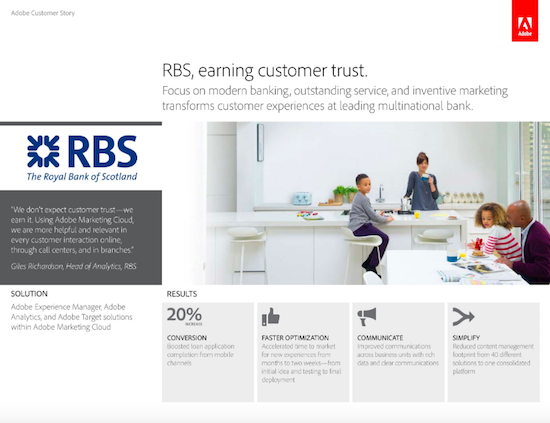
This study focuses on the solutions Adobe provided for the Royal Bank of Scotland. Their top challenges included fostering a culture of data driven decision making, eliminating disjointed systems, and delivering digital experiences that are relevant and easy to use.
Adobe's approach resulted in a 20 percent increase in conversion, as well as improved internal communications, faster optimization, and a reduction of their content management footprint.
2. BrightEdge: Stanley
In 2015, Stanley consolidated two separate brand web properties into one site. The process needed to mitigate traffic disruption, improve traffic, and increase organic search results.
The results? Almost 40 percent of keywords Stanley ranked for were on the first page of organic results, and the company generated a 100 percent lift in revenue, thanks to support from the BrightEdge platform.
3. LeadGnome: Host Analytics
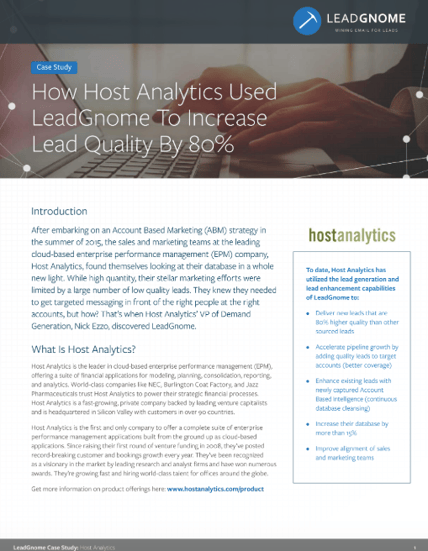
Host Analytics moved to an account based marketing strategy in 2015. They noticed that the marketing efforts were limited by a large number of low quality needs.
Their problem was solved when they used an automated email marketing approach from LeadGnome to nurture and qualify leads via email marketing.
4. Bitly: Vissla
Vissla is an online ecommerce company with a need to understand big data across multiple marketing platforms.
Bitly provided a a way to consolidate data and literally link channels together to display all information on a single dashboard.
5. Taboola: The Line

The Line is an online boutique that offers shoppers a unique experience and showcases products that can be found at their brick and mortar store in NYC's Soho neighborhood. Their goal was to increase first time visitors to their site.
Taboola offers a product that drives first time users. The result? Over 72 million impressions within three months, and email subscriber growth of 12 percent.
6. OutBrain: Lane Bryant
Lane Bryant, the leading retailer for women sized 14 – 28, launched a campaign designed to celebrate all women and redefine the traditional notion of sexy with a simple message – ALL women are sexy.
The goal was to amplify the campaign and drive traffic and engagement.
The result? OutBrain used media amplification to take the campaign viral, resulting in over 48,500,000 impressions in just two weeks!

7. Google Analytics: Optimizely
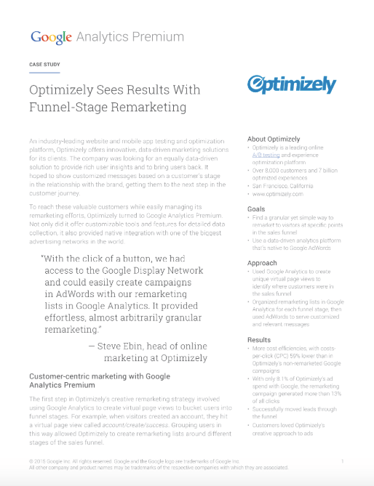
Optimizely is a leading online A/B testing and user experience optimization platform that offers innovative data-driven marketing solutions to maximize user experience and keep them coming back for more.
The challenge they faced was better identifying page views to determine where customers are in the buying cycle.
The solution was provided by using data from Google Analytics Premium to successfully move leads through the sales funnel.
8. LinkedIn Marketing Solutions: HubSpot
HubSpot, in search of quality leads, turned to LinkedIn Marketing Solutions to engage with marketing professionals in small to medium sized businesses, targeting them with ebooks, webinars, and how-to guides. Sponsored organic content appeared in members' LinkedIn feeds.
The result: 400 percent more leads within their target audience than efforts on other platforms.
9. LevelEleven: Staples
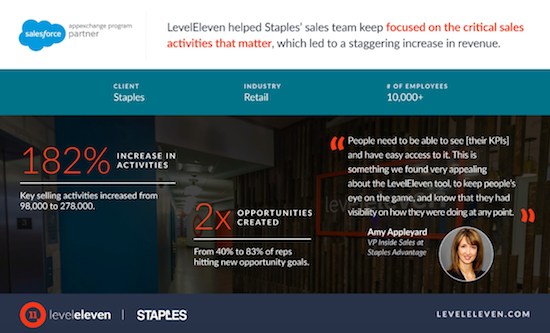
LevelEleven helped Staples focus their teams on the critical sales activities that matter.
The end result? Their team developed a better understanding of the KPIs that matter and experienced a 182 percent increase in key selling activities.
10. LifeSize: Rackspace
Rackspace is a world leader in hybrid cloud computing with offices throughout the world. The challenge was collaborating and communicating across offices.
The approach? LifeSize created a video solution to build stronger relationships across international offices.
11. Five9: Weed Man
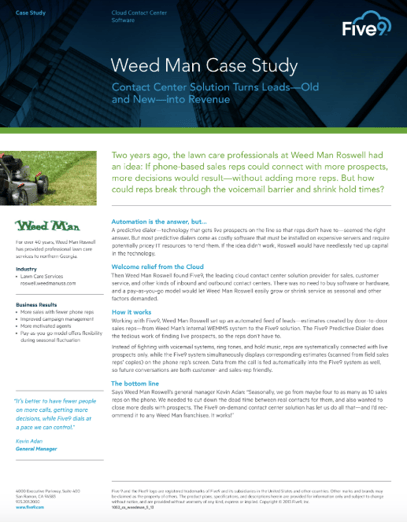
Five years ago, the lawn care company Weed Man had an idea -- If their phone-based reps could connect with more prospects, more decisions would result, without adding sales reps.
The solution? Five9 assisted Weed Man with migrating their data to the cloud. This case study shows why SMBs like Weed Man should store business data on the cloud for CRM.
12. LogMeIn: Extent Technologies
One of the better, more concise case study examples, this one page synopsis clearly defines the challenges and goals of Extent.
It explores how LogMeIn provided effective solutions and produced stellar results, including a boost in staff productivity, an increase in first contact resolution rate, and an improvement in overall service.
13. Red Hat: North Carolina State Websites
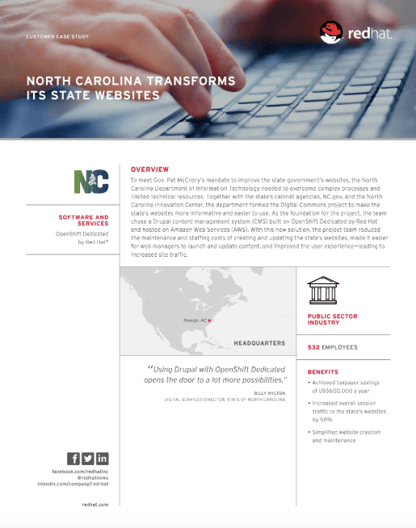
Under mandate from the governor, the North Carolina Department of Information Technology needed to update state websites to overcome complex processes and limited technical resources.
The resulting solutions from Red Hat reduced maintenance times and lowered staffing costs.
14. VMWare: CenturyLink
This study addresses the complexities of cloud hosted infrastructure. One element of all case study examples is to educate perspective clients about the services and products offered.
This study takes a complex subject and makes it easy to understand, while clearly outlining the solutions VMWare can provide.
15. Hewlett Packard Enterprise: Mendix
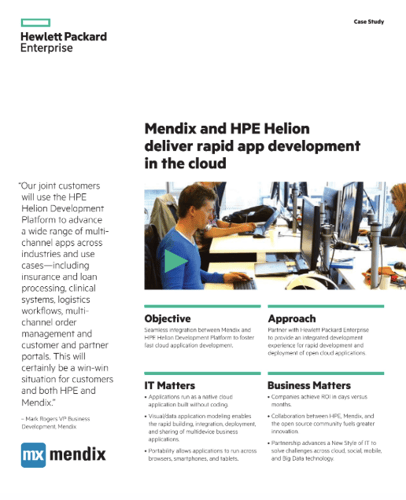
This study breaks down another complex subject: rapid hosted cloud app development.
HPE links to additional content so readers can gain even more knowledge about the subject and the solutions HPE offers.
7 of the Best Online Case Studies
1. gravitate: global expeditions group.
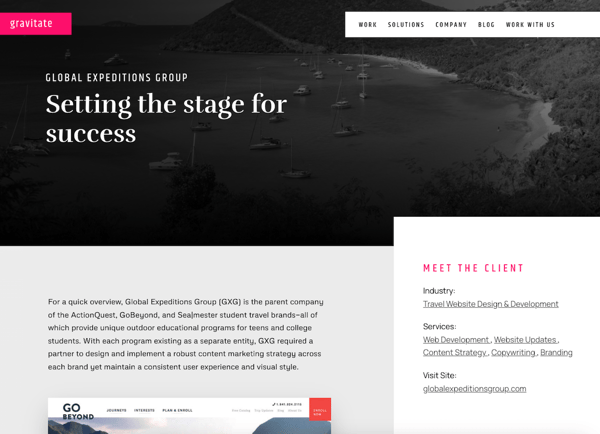
This case study is a great example of how to break up a detailed case study for an easier read.
Gravitate starts off by introducing their client, Global Expeditions Group (GXG), to give visitors a little background into what they do. They then dive straight into what their role was in helping GXG with a robust content marketing strategy.
What catches your eye at the beginning of this case study is the results. Rather than forcing readers to find out the impact of their efforts at the very end, they call out some major statistics and improvements that they helped GXG achieve. It's a great way to entice readers to keep them wanting to learn just how they did it.
Gravitate did a great job breaking up their rather long case study. Since it focuses on an entire content marketing strategy, they put various parts of their case study into separate sections, from their rebranding efforts to their website design and copywriting.
2. IDEO: INFARM
What we like so much about IDEO's case study about INFARM is that it reads just like a simple blog post – there's no sections and no busy graphics. While this doesn't work for everyone, it really matches the vibe of IDEO's brand.
This case study is short, sweet, and to the point, with the largest elements on the page being the images and a quote. At the very top, they outline the entire case study in two small sections – the challenge and the outcome.
What we like about this particular case study is how IDEO talks about what's next for INFARM. Beyond the typical problem-solution-result structure, they took it one step further to talk about the future and what INFARM plans on doing next.
3. Forge and Smith: Happy Planet
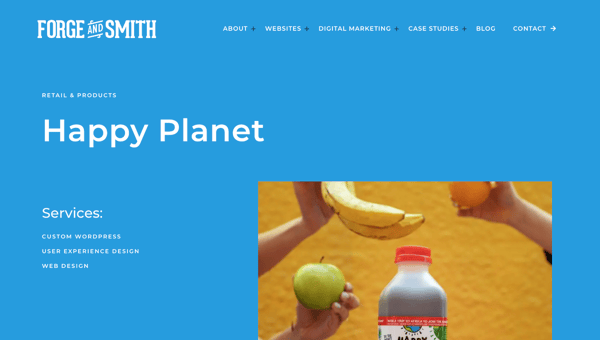
Forge and Smith effectively uses real mockups and examples from the work they did for Happy Planet to showcase their work in action.
This case study is perfectly designed into multiple modules to break up chunks of text into three phases. They start off with the objectives they set in place for their website design and development work for Happy Planet, which is pretty unique for a case study.
What's great about this case study is the opportunity to view the finished website. A hyperlink isn't just hidden within the text forcing you to dig around looking for it; it's called out right then and there to let you view their finished work on the Happy Planet website.
Another great feature is the option to view a previous case study or all the case studies if you're interested. No need to locate the main page, you have direct access!

4. CoSchedule: English Heritage
CoSchedule treats their case studies as customer stories, highlighting who their customers are and how their platform was able to help them. Their case study on English Heritage is simple to view and comprehend.
On the left, there is a customer spotlight on English Heritage, complete with a company logo, brief description, industry, company size, size of the marketing team, and more. These little details help give you a better idea of who the company is.
Then, on the right side of the screen, is a blog-like case study.
Rather than breaking up their message into the standard format, CoSchedule calls out the results that English Heritage has seen since switching to CoSchedule. Within each result, they touch on the challenge they had before CoSchedule then the lasting impact it created.
Throughout the case study, CoSchedule includes relevant screenshots and impactful quotes from English Heritage employees. This helps readers visualize what they are talking about.
5. Slack: OpenAI
Artificial Intelligence (AI) tools have quickly claimed center stage in the digital world. Slack is one business that hopped on the bandwagon and incorporated AI generated assistance into their platform, and this case study tells a story of success using modern technology.
In this case study , Slack relies heavily on testimonials to share the impact that OpenAI has made on their product. The story of Slack and OpenAI is told directly to readers by the people who experienced the partnership and how it can improve user experience for all kinds of businesses. Sharing a success story in this way makes the whole case study feel much more personal than just providing a list of statistics.
When customers read through the case study, they'll get to know perspectives from multiple people, hopefully coming across one that really resonates with them.
6. Square: The Epicurean Trader
The Epicurean Trader case study featured on the Square website follows the tried and true structure for a closer look into a success story. First, this case study introduces The Epicurean Trader and what problems they were facing as a retail business.
The next section of the case study discusses the solution proposed by Square and the implementation of their products as The Epicurean Trader expanded their business. Finally, this case study concludes with notable impacts as a result of using Square's software, including revenue growth and comparisons to standards set within the industry.
Reading through this case study, you'll join The Epicurean Trade on their journey to enhance their retail practices. Thanks to testimonials from the owner of the business, you'll also get an inside look at how this brand was able to grow with some help from Square.
Overall, this case study example is clear, concise, and easy to follow. Readers will get to know a highlighted business and how Square stepped in to resolve a problem they were facing.
7. Bluleadz: BandGrip
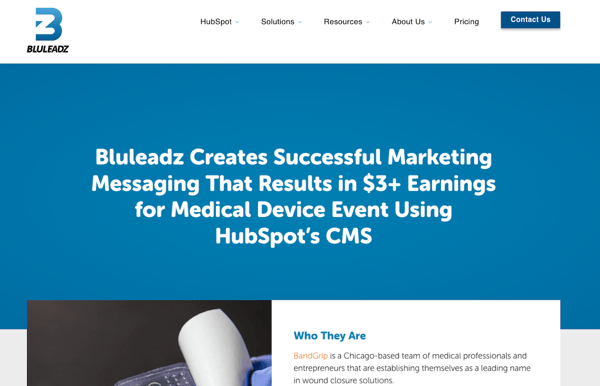
We couldn't not pat our own backs for recently publishing a case studies page on our website.
Bluleadz often uses case study PDFs as sales collateral to send to qualified prospects. While we used these PDF designs internally, we wanted to make sure our client success stories were available to everyone coming to our site.
Thus, our case study page was born.
Our BandGrip case study really sticks out to us. We start off by introducing who BandGrip is, who they serve, and what they do.
Then, we highlight the struggles they were having with getting demo sign-ups on their page. We included relevant quotes from the CEO to show their need for a solution.
We then begin to outline all the pre-show and post-show tactics that we implemented to help them tackle their challenge and earn them more demo sign ups. Landing page screenshots and other various graphics help readers visualize what we were able to do.
Toward the end of the case study, we highlight the impact of our efforts, calling out some of the major statistics.
Highlight Your Past Successes to Attract Future Business
Each of these case study examples does an excellent job of outlining the challenges, solutions, and results provided. If you are building a portfolio of case studies, use these excellent examples for inspiration and format.
Once you master the art of the case study, you’ll find it’s packed with marketing power, giving you a huge ROI for the time you put into creating it.
If your leads have been falling off in the decision phase, a marketing case study may be just what you need.
Case studies are a powerful tool in your content marketing arsenal, so why not create one today? Click below to create your very own case study!

General FAQ
What is a case study.
Case studies are narratives that feature real-world situations or uses of products or services to demonstrate their value. A well-written case study will follow a customer as they define a problem, determine a solution, implement it, and reap the benefits.
The more to-the-point you can be in a case study, the better. Case Studies typically range from 500 words to 1,500 words depending on what's getting highlighted.
What Format Should My Case Study Be In?
Typically, a case study contains an introduction, a challenge, a solution, a benefit, and a result.
Why are Case Studies Important?
Case studies allow businesses to showcase how their product or service has been implemented successfully by their customers. It allows businesses to show how their product/service is actually used and the impact that it can have.

Jackie Jacobson
Jackie is a Copywriter at Bluleadz. She graduated from Elon University with a degree in Creative Writing and is currently living in Charlotte, NC. If you need her, you can find her exploring the city or relaxing with a good book.
More Marketing Insights
Can't find what you're looking for try using a keyword..

What Is a Case Study & Customer Success Story?
Learn the definition of a business case study, its meaning, benefits & use in marketing. Get best methods to research, write & design business case studies.

Dominika Krukowska
10 minute read

Short answer
What is a business case study.
A case study, also called customer success story, is a product marketing document used to show how your clients solved a business problem with the aid of your product or service. Case studies include statistics, quotes, and concrete examples with the goal of credibly demonstrating your capability to deliver results.
Bad case studies are not just ineffective - they lead to lost sales
A poorly done business case study can be a real bottleneck in your marketing funnel.
Sure, you have to have them; they're a non-negotiable part of the buying process. But if they're not compelling, you might as well not waste your time on it.
It’s bad enough that it’s hard to make a case study that gets results. But making a weak case study can actually cause you to look less attractive than the competition and cost you leads and sales.
Sometimes more is less.
This post is your roadmap to transforming your case studies from forgettable fillers to customer magnets. And ultimately, turning more prospects into customers.
Let's jump in!
What are the benefits of case studies in business and marketing?
Case studies are an essential part of any well-oiled marketing engine. They demonstrate real-life applications, showcase your unique value, build trust, address concerns, and connect with your audience.
Let’s get a bit into detail.
Demonstrating real-life applications: Business case studies show your product or service in action, offering a peek into how it can be used in real-world situations. It's like offering a test drive before asking customers to commit.
Showing your unique value: Customer success stories let your product or service shine. They illustrate exactly what you bring to the table and why customers should choose you over anyone else.
Building trust: Think of business case studies as your brand's personal advocate. They show how you've helped others succeed, which makes potential customers more likely to trust you with their business.
Easing concerns and objections: Got customers sitting on the fence? Business case studies can gently nudge them towards you by addressing common doubts or worries. It's about showing potential customers that you can deliver what they need.
Connecting with your audience: A good business case study is like a mirror—your potential customers should be able to see themselves in it. It's all about tapping into their hopes, their worries, and their needs.
What to include in a case study?
A successful business case study is the product of a strategic blend of essential components. Each one carries its weight, shaping a narrative that is both engaging and impactful.
Introduction: Set the stage with a one-liner summarizing your unique value proposition. Tailor it to grab your readers' attention and pique their curiosity.
Company overview: Give your audience a snapshot of your customer's business, helping them understand who they are and what they do.
The problem/challenge: Dive into the nitty-gritty of the issue your customer was facing (from their perspective), making it relatable to your audience.
Your solution: Detail how your product or service swooped in as the game-changing solution, addressing the customer's problem.
Results: Showcase the impressive outcome of your solution, demonstrating tangible success that can't be ignored. Back it up with relevant data and metrics.
Customer quotes/testimonials: Add authenticity and credibility to your case study with direct quotes from the customer who experienced the transformation first-hand.
Next steps: Conclude with a call to action, guiding the reader on what to do next, whether it's contacting your company or booking a product demo.
Here's an example of a case study designed according to this structure:

UX Case study
This template for case studies in UX and UI comes with tons of space for text and many visual elements such as charts, timelines, or graphs. This one is perfect for those case studies in which you need to explain the process in greater detail.
What makes a good case study?
A good case study follows a story format of problem-solution-impact. It includes key details of the client’s problem, how they solved it with the help of your product, and the impact it brought them.
8 critical components of a successful case study:
- Talking from the client’s perspective
- Addressing well-defined business problem
- Telling the WHY, not just the WHAT and the HOW
- Giving concrete example
- Backing the story with statistics and facts
- Weaving quotes and testimonials into the story
- Making the content interactive
- Including a call to action
In principle, a top-tier business case study is more than a testimonial.
Think of it as a blockbuster movie, where your customer is the hero Luke Skywalker, the problem is the looming death star, and your solution is the trusted guide Obi-Wan Kenobi.
This gives readers an engaging narrative that not only captures interest but also propels action.
Now let's take a look behind-the-scenes. at the key elements that make a good business case study.
1. Story from the client’s perspective
The key to a captivating case study lies in whose story you're telling. Let your customer be the hero, not your product or service. By focusing on their journey, you'll create a narrative that resonates with your audience, making them more invested in the outcome.
A great example is Adobe’s case study with Under Armour :
In this case study, Adobe tells the story of how Under Armour used Adobe Experience Manager Assets to streamline and enhance their creative asset management. The case study is presented from Under Armour's point of view, providing a customer-centric perspective.
2. Common but well-defined business problem
The best case studies revolve around relatable, well-articulated problems. The issue should be common enough for your audience to identify with, yet specific enough to avoid being generic.
Shoot for the sweet spot that makes a specific segment of your prospective clients say, "That sounds like us!"
A great example is Slack’s case study with HubSpot :
HubSpot, a well-known inbound marketing , sales, and service software provider, grappled with the challenge of maintaining internal communication and collaboration across a rapidly expanding global team.
This case study by Slack outlines how they addressed HubSpot's problem - a common issue faced by many growing businesses.
3. Tell the WHY, not just the WHAT and the HOW
The magic of a compelling case study lies in the mystery of 'why' your solution works. It's crucial to share what happened and how, but digging into the reasons behind the decisions and outcomes adds mystery to your story and keeps your audience intrigued.
An example of this is Marketo’s case study with Panasonic :
In this business case study, Marketo digs into why Panasonic decided to implement a new marketing automation solution.
The case study doesn't just focus on the solutions Marketo provided, but also highlights the reasons behind Panasonic's decision, adding depth to the narrative.
4. Concrete examples
Details make your case study relatable and tangible. Incorporate specifics - who did what , when , where , and how . These concrete examples help your audience visualize the scenario, making your narrative more compelling and memorable.
Zendesk's case study with LendingClub presents concrete examples:
It follows how LendingClub used Zendesk's customer service software to improve their customer support operations.
The case study offers a clear narrative about the problems LendingClub faced, the solutions provided by Zendesk, and the impact these solutions had on LendingClub's business.
Numbers lend authority and credibility that words often cannot. They provide concrete evidence of your solution's impact, creating a stronger case for your product or service.
But remember, these stats should be significant, reliable, and, most importantly, show real impact on your customer’s bottom line.
Here's an example of a great animated numbers slide:

6. Quotes and testimonials
There's nothing like a testimonial from a happy customer to boost your credibility. Direct quotes add a personal touch and authenticity to your case study, making it more believable and trustworthy.
Here’s a great testimonial example from Hotjar:
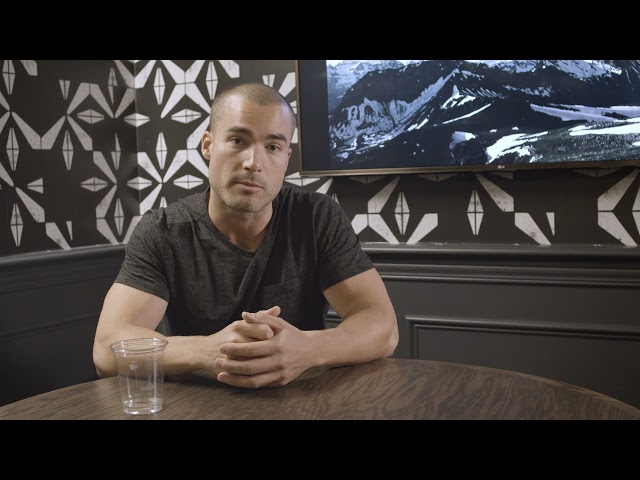
7. Interactive design
Incorporating interactive design elements will make your case studies stand out, but more importantly, drive high-engagement.
Use eye-catching graphics, use clickable elements like tabs, videos, and menus, include live graphs, animated flipbooks , and so on. Use these elements tactically in order to break up your text into digestible chunks and make your content easier to read and to navigate.
Here’s an example of an interactive business case study:

Marketing case study
White glove delivery with a focus on process optimization explained by a compelling story.
8. Call to action
A good case study doesn't just end; it leads your reader to the next step. Be it trying your product, booking a demo, getting in touch with your team, or reading another case study - your call to action should be clear, compelling, and easy to follow.
Here’s what a clear, singular call to action should look like:

If you want to learn more practical tips, check out our post on how to create a business case study that converts .
How to use a case study in business and marketing?
Often underestimated and underused , business case studies have the power to leverage real-life narratives to shape opinions, influence decision-making, and ultimately, drive conversions.
Let me show you how you can use that power to your advantage.
1. Used as sales collateral
In the world of sales, your case study can be the difference between a polite “we’ll consider it” and a bought-in “show me how it works!”
Picture this: you're reaching out to potential clients, and you slip in a case study showcasing how you've helped a similar business overcome a common hurdle. It's not just a pitch, it's proof you can do it.
But the magic doesn't stop there. Weave these real-life success stories into your sales presentations , and watch as they accelerate your pipeline.
They provide tangible evidence of your value proposition, helping you remove objections, demonstrate value, and differentiate yourself in a crowded market.
2. Used as marketing collateral
I) Use on your website:
On the marketing front, case studies can significantly boost your self-serve conversion rate . By featuring them on your website, you're offering visitors a peek into your track record of success - letting them feel like they're missing out.
II) Add to brochures and product catalogs:
Just sprinkle in a few case studies, and you've just added an extra layer of credibility.
III) Leverage social media:
Share your case studies on platforms like LinkedIn, Facebook, or Twitter, to promote your business; and start a conversation around your brand.
IV) Include in PPC campaigns on Google AdWords:
Add case studies as site links to give potential customers another reason to click. It's like saying, "Don't just take our word for it, see how we've helped businesses like yours."
Here’s an example of what it looks like:
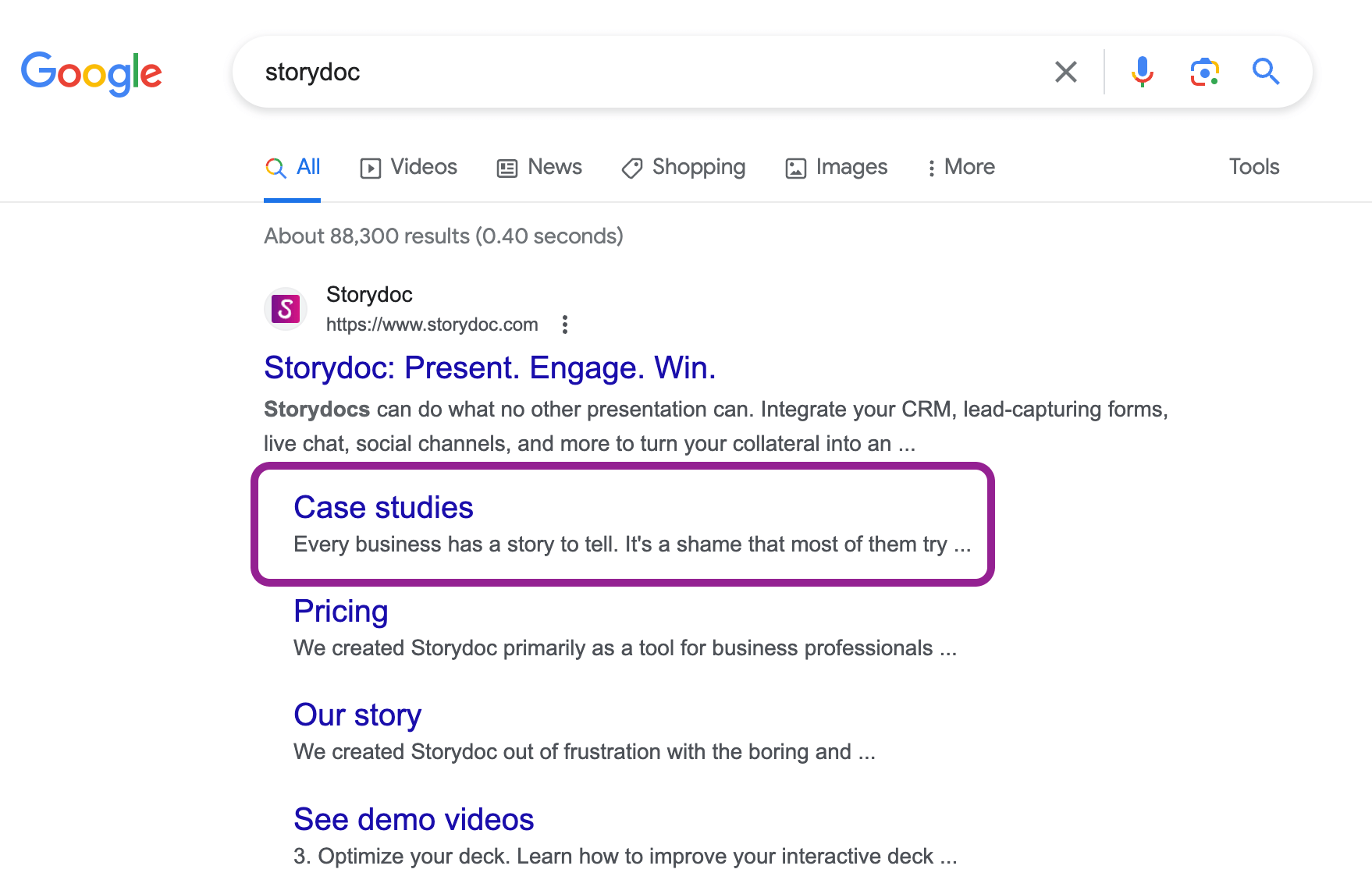

Obstacles for creating business case studies & how to overcome them
Creating captivating business case studies is essential, but let's be real: it's not a walk in the park.
So let's buckle up and navigate the most common roadblocks and learn how to steer around them.
Hurdle 1: Spotting the right stories feels like finding a needle in a haystack.
Hold on there! Locating customers ready to share their success tales might seem daunting, but it's not mission impossible. Here's the deal: people love to share success.
How to get clients to share their success stories
Collaborate with your customer success team to identify delighted or triumphant clients
Seek out customers who are scoring high on NPS
Team up with sales to single out recent renewals or upsells
Engage with super active customers on social media
Ask your team during meetings about any standout customers
Reach out to customers who have spoken at your events
Connect with Customer Advisory Board members
Do this and you're bound to uncover some star storytellers.
Hurdle 2: Customers might not want to get involved.
Let's flip the script! Instead of begging for a favor, portray this as an opportunity for customers to amplify their industry status.
Make it a hassle-free and rewarding experience for them. Provide data, draft points for discussion, and be their cheerleader throughout the journey.
Remember, appreciation is infectious. A heartfelt thank you can turn a one-time participant into a long-term advocate.
Hurdle 3: It’s a mammoth task.
Creating business case studies can feel like a marathon, particularly when you're juggling multiple roles.
Delegating the task to an experienced industry writer can save your team a ton of time and energy. You might find the right person within your network, or you might need to explore industry-specific job boards.
Creating a structured timeline and using a shared tool can help keep everyone on track and in the loop.
Here's how to streamline the process of creating a case study:
Extend an invitation to the potential customer
Connect them with the lead writer
Conduct an internal review of the first draft before sending it to the customer
Incorporate their feedback into the second draft
Get final approval for the final draft
Publish and promote your case study!
How to design a business case study?
Your case study design supports the text like your body language supports what you’re saying when you talk. It adds that extra layer of emotional meaning you can't quite put into words.
Luckily, even if you're not a design expert, there are tools to help you add that extra emotional depth to your content. Let’s review a few tools that help you design your case study.
Design using a website builder
If you’d prefer to get hands-on with your design, website builders like Wix or Squarespace offer a versatile platform for creating a business case study from scratch.
They provide a blank canvas and a wealth of design elements, giving you the liberty to choose each piece and place it just where you want it.
It takes time and a keen eye for design to make all the elements come together seamlessly, but the end result can be rewarding.
Design using a case study maker
A case study maker gives you pre-set elements ready for use. All you need to do is drop in your content, and the tool takes care of the aesthetics and user experience.
It's a much more efficient way to create a case study with all its unique building blocks than using a website builder.
We know, since we see how fast our users create astounding case studies using our own case study creator. Try for yourself .
Don’t design - use a template
Templates provide an immediate and easy to work with structure for your design and content.
But beyond that, our gallery of interactive case study templates gives you time-tested designs we know have high-engagement and killer conversion (based on more than 100K reading sessions we’ve analyzed).
Grab a template - and you can skip the long design process, save time, money and frustration, and simply start creating.

Hi, I'm Dominika, Content Specialist at Storydoc. As a creative professional with experience in fashion, I'm here to show you how to amplify your brand message through the power of storytelling and eye-catching visuals.

Found this post useful?
Subscribe to our monthly newsletter.
Get notified as more awesome content goes live.
(No spam, no ads, opt-out whenever)
You've just joined an elite group of people that make the top performing 1% of sales and marketing collateral.
Create your best case study to date
Try Storydoc interactive case study creator for 14 days free (keep any presentation you make forever!)
28 Case Study Examples Every Marketer Should See
Published: March 08, 2023
Putting together a compelling case study is one of the most powerful strategies for showcasing your product and attracting future customers. But it's not easy to create case studies that your audience can’t wait to read.

In this post, we’ll go over the definition of a case study and the best examples to inspire you.

What is a case study?
A case study is a detailed story of something your company did. It includes a beginning — often discussing a conflict, an explanation of what happened next, and a resolution that explains how the company solved or improved on something.
A case study proves how your product has helped other companies by demonstrating real-life results. Not only that, but marketing case studies with solutions typically contain quotes from the customer. This means that they’re not just ads where you praise your own product. Rather, other companies are praising your company — and there’s no stronger marketing material than a verbal recommendation or testimonial. A great case study is also filled with research and stats to back up points made about a project's results.
There are myriad ways to use case studies in your marketing strategy . From featuring them on your website to including them in a sales presentation, a case study is a strong, persuasive tool that shows customers why they should work with you — straight from another customer. Writing one from scratch is hard, though, which is why we’ve created a collection of case study templates for you to get started.
Fill out the form below to access the free case study templates.

Free Case Study Templates
Showcase your company's success using these three free case study templates.
- Data-Driven Case Study Template
- Product-Specific Case Study Template
- General Case Study Template
You're all set!
Click this link to access this resource at any time.
There’s no better way to generate more leads than by writing case studies . But without case study examples to draw inspiration from, it can be difficult to write impactful studies that convince visitors to submit a form.
Marketing Case Study Examples
To help you create an attractive and high-converting case study, we've put together a list of some of our favorites. This list includes famous case studies in marketing, technology, and business.
These studies can show you how to frame your company offers in a way that is both meaningful and useful to your audience. So, take a look, and let these examples inspire your next brilliant case study design.
These marketing case studies with solutions show the value proposition of each product. They also show how each company benefited in both the short and long term using quantitative data. In other words, you don’t get just nice statements, like "This company helped us a lot." You see actual change within the firm through numbers and figures.
You can put your learnings into action with HubSpot's Free Case Study Templates . Available as custom designs and text-based documents, you can upload these templates to your CMS or send them to prospects as you see fit.

1. " How Handled Scaled from Zero to 121 Locations with the Help of HubSpot ," by HubSpot

What's interesting about this case study is the way it leads with the customer. That reflects a major HubSpot cornerstone, which is to always solve for the customer first. The copy leads with a brief description of why the CEO of Handled founded the company and why he thought Handled could benefit from adopting a CRM. The case study also opens up with one key data point about Handled’s success using HubSpot, namely that it grew to 121 locations.
Notice that this case study uses mixed media. Yes, there is a short video, but it's elaborated upon in the other text on the page. So while your case studies can use one or the other, don't be afraid to combine written copy with visuals to emphasize the project's success.
Key Learnings from the HubSpot Case Study Example
- Give the case study a personal touch by focusing on the CEO rather than the company itself.
- Use multimedia to engage website visitors as they read the case study.
2. " The Whole Package ," by IDEO

Here's a design company that knows how to lead with simplicity in its case studies. As soon as the visitor arrives at the page, they’re greeted with a big, bold photo and the title of the case study — which just so happens to summarize how IDEO helped its client. It summarizes the case study in three snippets: The challenge, the impact, and the outcome.
Immediately, IDEO communicates its impact — the company partnered with H&M to remove plastic from its packaging — but it doesn't stop there. As the user scrolls down, the challenge, impact, and progress are elaborated upon with comprehensive (but not overwhelming) copy that outlines what that process looked like, replete with quotes and intriguing visuals.
Key Learnings from the IDEO Case Study Example
- Split up the takeaways of your case studies into bite-sized sections.
- Always use visuals and images to enrich the case study experience, especially if it’s a comprehensive case study.
3. " Rozum Robotics intensifies its PR game with Awario ," by Awario

In this case study, Awario greets the user with a summary straight away — so if you’re feeling up to reading the entire case study, you can scan the snapshot and understand how the company serves its customers. The case study then includes jump links to several sections, such as "Company Profile," "Rozum Robotics' Pains," "Challenge," "Solution," and "Results and Improvements."
The sparse copy and prominent headings show that you don’t need a lot of elaborate information to show the value of your products and services. Like the other case study examples on this list, it includes visuals and quotes to demonstrate the effectiveness of the company’s efforts. The case study ends with a bulleted list that shows the results.
Key Learnings from the Awario Robotics Case Study Example
- Create a table of contents to make your case study easier to navigate.
- Include a bulleted list of the results you achieved for your client.
4. " Chevrolet DTU ," by Carol H. Williams

If you’ve worked with a company that’s well-known, use only the name in the title — like Carol H. Williams, one of the nation’s top advertising agencies, does here. The "DTU," stands for "Discover the Unexpected." It generates interest because you want to find out what the initials mean.
They keep your interest in this case study by using a mixture of headings, images, and videos to describe the challenges, objectives, and solutions of the project. The case study closes with a summary of the key achievements that Chevrolet’s DTU Journalism Fellows reached during the project.
Key Learnings from the Carol H. Williams Case Study Example
- If you’ve worked with a big brand before, consider only using the name in the title — just enough to pique interest.
- Use a mixture of headings and subheadings to guide users through the case study.
5. " How Fractl Earned Links from 931 Unique Domains for Porch.com in a Single Year ," by Fractl

Fractl uses both text and graphic design in their Porch.com case study to immerse the viewer in a more interesting user experience. For instance, as you scroll, you'll see the results are illustrated in an infographic-design form as well as the text itself.
Further down the page, they use icons like a heart and a circle to illustrate their pitch angles, and graphs to showcase their results. Rather than writing which publications have mentioned Porch.com during Fractl’s campaign, they incorporated the media outlets’ icons for further visual diversity.
Key Learnings from the Fractl Case Study Example
- Let pictures speak for you by incorporating graphs, logos, and icons all throughout the case study.
- Start the case study by right away stating the key results, like Fractl does, instead of putting the results all the way at the bottom.
6. " The Met ," by Fantasy

What's the best way to showcase the responsiveness and user interface of a website? Probably by diving right into it with a series of simple showcases— which is exactly what Fantasy does on their case study page for the Metropolitan Museum of Art. They keep the page simple and clean, inviting you to review their redesign of the Met’s website feature-by-feature.
Each section is simple, showing a single piece of the new website's interface so that users aren’t overwhelmed with information and can focus on what matters most.
If you're more interested in text, you can read the objective for each feature. Fantasy understands that, as a potential customer, this is all you need to know. Scrolling further, you're greeted with a simple "Contact Us" CTA.
Key Learnings from the Fantasy Case Study Example
- You don’t have to write a ton of text to create a great case study. Focus on the solution you delivered itself.
- Include a CTA at the bottom inviting visitors to contact you.
7. " Rovio: How Rovio Grew Into a Gaming Superpower ," by App Annie

If your client had a lot of positive things to say about you, take a note from App Annie’s Rovio case study and open up with a quote from your client. The case study also closes with a quote, so that the case study doesn’t seem like a promotion written by your marketing team but a story that’s taken straight from your client’s mouth. It includes a photo of a Rovio employee, too.
Another thing this example does well? It immediately includes a link to the product that Rovio used (namely, App Annie Intelligence) at the top of the case study. The case study closes with a call-to-action button prompting users to book a demo.
Key Learnings from the App Annie Case Study Example
- Feature quotes from your client at the beginning and end of the case study.
- Include a mention of the product right at the beginning and prompt users to learn more about the product.
8. " Embracing first-party data: 3 success stories from HubSpot ," by Think with Google

Google takes a different approach to text-focused case studies by choosing three different companies to highlight.
The case study is clean and easily scannable. It has sections for each company, with quotes and headers that clarify the way these three distinct stories connect. The simple format also uses colors and text that align with the Google brand.
Another differentiator is the focus on data. This case study is less than a thousand words, but it's packed with useful data points. Data-driven insights quickly and clearly show how the value of leveraging first-party data while prioritizing consumer privacy.

Key Learnings from the Think with Google Case Study Example
- A case study doesn’t need to be long or complex to be powerful.
- Clear data points are a quick and effective way to prove value.
9. " In-Depth Performance Marketing Case Study ," by Switch

Switch is an international marketing agency based in Malta that knocks it out of the park with this case study. Its biggest challenge is effectively communicating what it did for its client without ever revealing the client’s name. It also effectively keeps non-marketers in the loop by including a glossary of terms on page 4.
The PDF case study reads like a compelling research article, including titles like "In-Depth Performance Marketing Case Study," "Scenario," and "Approach," so that readers get a high-level overview of what the client needed and why they approached Switch. It also includes a different page for each strategy. For instance, if you’d only be interested in hiring Switch for optimizing your Facebook ads, you can skip to page 10 to see how they did it.
The PDF is fourteen pages long but features big fonts and plenty of white space, so viewers can easily skim it in only a few minutes.
Key Learnings from the Switch Case Study Example
- If you want to go into specialized information, include a glossary of terms so that non-specialists can easily understand.
- Close with a CTA page in your case study PDF and include contact information for prospective clients.
10. " Gila River ," by OH Partners

Let pictures speak for you, like OH Partners did in this case study. While you’ll quickly come across a heading and some text when you land on this case study page, you’ll get the bulk of the case study through examples of actual work OH Partners did for its client. You will see OH Partners’ work in a billboard, magazine, and video. This communicates to website visitors that if they work with OH Partners, their business will be visible everywhere.
And like the other case studies here, it closes with a summary of what the firm achieved for its client in an eye-catching way.
Key Learnings from the OH Partners Case Study Example
- Let the visuals speak by including examples of the actual work you did for your client — which is especially useful for branding and marketing agencies.
- Always close out with your achievements and how they impacted your client.
11. " Facing a Hater ," by Digitas

Digitas' case study page for Sprite’s #ILOVEYOUHATER campaign keeps it brief while communicating the key facts of Digitas’ work for the popular soda brand. The page opens with an impactful image of a hundred people facing a single man. It turns out, that man is the biggest "bully" in Argentina, and the people facing him are those whom he’s bullied before.
Scrolling down, it's obvious that Digitas kept Sprite at the forefront of their strategy, but more than that, they used real people as their focal point. They leveraged the Twitter API to pull data from Tweets that people had actually tweeted to find the identity of the biggest "hater" in the country. That turned out to be @AguanteElCofler, a Twitter user who has since been suspended.
Key Learnings from the Digitas Case Study Example
- If a video was part of your work for your client, be sure to include the most impactful screenshot as the heading.
- Don’t be afraid to provide details on how you helped your client achieve their goals, including the tools you leveraged.
12. " Better Experiences for All ," by HermanMiller

HermanMiller sells sleek, utilitarian furniture with no frills and extreme functionality, and that ethos extends to its case study page for a hospital in Dubai.
What first attracted me to this case study was the beautiful video at the top and the clean user experience. User experience matters a lot in a case study. It determines whether users will keep reading or leave. Another notable aspect of this case study is that the video includes closed-captioning for greater accessibility, and users have the option of expanding the CC and searching through the text.
HermanMiller’s case study also offers an impressive amount of information packed in just a few short paragraphs for those wanting to understand the nuances of their strategy. It closes out with a quote from their client and, most importantly, the list of furniture products that the hospital purchased from the brand.
Key Learnings from the HermanMiller Case Study Example
- Close out with a list of products that users can buy after reading the case study.
- Include accessibility features such as closed captioning and night mode to make your case study more user-friendly.
13. " Capital One on AWS ," by Amazon

Do you work continuously with your clients? Consider structuring your case study page like Amazon did in this stellar case study example. Instead of just featuring one article about Capital One and how it benefited from using AWS, Amazon features a series of articles that you can then access if you’re interested in reading more. It goes all the way back to 2016, all with different stories that feature Capital One’s achievements using AWS.
This may look unattainable for a small firm, but you don’t have to go to extreme measures and do it for every single one of your clients. You could choose the one you most wish to focus on and establish a contact both on your side and your client’s for coming up with the content. Check in every year and write a new piece. These don’t have to be long, either — five hundred to eight hundred words will do.
Key Learnings from the Amazon AWS Case Study Example
- Write a new article each year featuring one of your clients, then include links to those articles in one big case study page.
- Consider including external articles as well that emphasize your client’s success in their industry.
14. " HackReactor teaches the world to code #withAsana ," by Asana

While Asana's case study design looks text-heavy, there's a good reason. It reads like a creative story, told entirely from the customer's perspective.
For instance, Asana knows you won't trust its word alone on why this product is useful. So, they let Tony Phillips, HackReactor CEO, tell you instead: "We take in a lot of information. Our brains are awful at storage but very good at thinking; you really start to want some third party to store your information so you can do something with it."
Asana features frequent quotes from Phillips to break up the wall of text and humanize the case study. It reads like an in-depth interview and captivates the reader through creative storytelling. Even more, Asana includes in-depth detail about how HackReactor uses Asana. This includes how they build templates and workflows:
"There's a huge differentiator between Asana and other tools, and that’s the very easy API access. Even if Asana isn’t the perfect fit for a workflow, someone like me— a relatively mediocre software engineer—can add functionality via the API to build a custom solution that helps a team get more done."
Key Learnings from the Asana Example
- Include quotes from your client throughout the case study.
- Provide extensive detail on how your client worked with you or used your product.
15. " Rips Sewed, Brand Love Reaped ," by Amp Agency

Amp Agency's Patagonia marketing strategy aimed to appeal to a new audience through guerrilla marketing efforts and a coast-to-coast road trip. Their case study page effectively conveys a voyager theme, complete with real photos of Patagonia customers from across the U.S., and a map of the expedition. I liked Amp Agency's storytelling approach best. It captures viewers' attention from start to finish simply because it's an intriguing and unique approach to marketing.
Key Learnings from the Amp Agency Example
- Open up with a summary that communicates who your client is and why they reached out to you.
- Like in the other case study examples, you’ll want to close out with a quantitative list of your achievements.
16. " NetApp ," by Evisort

Evisort opens up its NetApp case study with an at-a-glance overview of the client. It’s imperative to always focus on the client in your case study — not on your amazing product and equally amazing team. By opening up with a snapshot of the client’s company, Evisort places the focus on the client.
This case study example checks all the boxes for a great case study that’s informative, thorough, and compelling. It includes quotes from the client and details about the challenges NetApp faced during the COVID pandemic. It closes out with a quote from the client and with a link to download the case study in PDF format, which is incredibly important if you want your case study to be accessible in a wider variety of formats.
Key Learnings from the Evisort Example
- Place the focus immediately on your client by including a snapshot of their company.
- Mention challenging eras, such as a pandemic or recession, to show how your company can help your client succeed even during difficult times.
17. " Copernicus Land Monitoring – CLC+ Core ," by Cloudflight

Including highly specialized information in your case study is an effective way to show prospects that you’re not just trying to get their business. You’re deep within their industry, too, and willing to learn everything you need to learn to create a solution that works specifically for them.
Cloudflight does a splendid job at that in its Copernicus Land Monitoring case study. While the information may be difficult to read at first glance, it will capture the interest of prospects who are in the environmental industry. It thus shows Cloudflight’s value as a partner much more effectively than a general case study would.
The page is comprehensive and ends with a compelling call-to-action — "Looking for a solution that automates, and enhances your Big Data system? Are you struggling with large datasets and accessibility? We would be happy to advise and support you!" The clean, whitespace-heavy page is an effective example of using a case study to capture future leads.
Key Learnings from the Cloudflight Case Study Example
- Don’t be afraid to get technical in your explanation of what you did for your client.
- Include a snapshot of the sales representative prospects should contact, especially if you have different sales reps for different industries, like Cloudflight does.
18. " Valvoline Increases Coupon Send Rate by 76% with Textel’s MMS Picture Texting ," by Textel

If you’re targeting large enterprises with a long purchasing cycle, you’ll want to include a wealth of information in an easily transferable format. That’s what Textel does here in its PDF case study for Valvoline. It greets the user with an eye-catching headline that shows the value of using Textel. Valvoline saw a significant return on investment from using the platform.
Another smart decision in this case study is highlighting the client’s quote by putting it in green font and doing the same thing for the client’s results because it helps the reader quickly connect the two pieces of information. If you’re in a hurry, you can also take a look at the "At a Glance" column to get the key facts of the case study, starting with information about Valvoline.
Key Learnings from the Textel Case Study Example
- Include your client’s ROI right in the title of the case study.
- Add an "At a Glance" column to your case study PDF to make it easy to get insights without needing to read all the text.
19. " Hunt Club and Happeo — a tech-enabled love story ," by Happeo

In this blog-post-like case study, Happeo opens with a quote from the client, then dives into a compelling heading: "Technology at the forefront of Hunt Club's strategy." Say you’re investigating Happeo as a solution and consider your firm to be technology-driven. This approach would spark your curiosity about why the client chose to work with Happeo. It also effectively communicates the software’s value proposition without sounding like it’s coming from an in-house marketing team.
Every paragraph is a quote written from the customer’s perspective. Later down the page, the case study also dives into "the features that changed the game for Hunt Club," giving Happeo a chance to highlight some of the platform’s most salient features.
Key Learnings from the Happeo Case Study Example
- Consider writing the entirety of the case study from the perspective of the customer.
- Include a list of the features that convinced your client to go with you.
20. " Red Sox Season Campaign ," by CTP Boston

What's great about CTP's case study page for their Red Sox Season Campaign is their combination of video, images, and text. A video automatically begins playing when you visit the page, and as you scroll, you'll see more embedded videos of Red Sox players, a compilation of print ads, and social media images you can click to enlarge.
At the bottom, it says "Find out how we can do something similar for your brand." The page is clean, cohesive, and aesthetically pleasing. It invites viewers to appreciate the well-roundedness of CTP's campaign for Boston's beloved baseball team.
Key Learnings from the CTP Case Study Example
- Include a video in the heading of the case study.
- Close with a call-to-action that makes leads want to turn into prospects.
21. " Acoustic ," by Genuine

Sometimes, simple is key. Genuine's case study for Acoustic is straightforward and minimal, with just a few short paragraphs, including "Reimagining the B2B website experience," "Speaking to marketers 1:1," and "Inventing Together." After the core of the case study, we then see a quote from Acoustic’s CMO and the results Genuine achieved for the company.
The simplicity of the page allows the reader to focus on both the visual aspects and the copy. The page displays Genuine's brand personality while offering the viewer all the necessary information they need.
- You don’t need to write a lot to create a great case study. Keep it simple.
- Always include quantifiable data to illustrate the results you achieved for your client.
22. " Using Apptio Targetprocess Automated Rules in Wargaming ," by Apptio

Apptio’s case study for Wargaming summarizes three key pieces of information right at the beginning: The goals, the obstacles, and the results.
Readers then have the opportunity to continue reading — or they can walk away right then with the information they need. This case study also excels in keeping the human interest factor by formatting the information like an interview.
The piece is well-organized and uses compelling headers to keep the reader engaged. Despite its length, Apptio's case study is appealing enough to keep the viewer's attention. Every Apptio case study ends with a "recommendation for other companies" section, where the client can give advice for other companies that are looking for a similar solution but aren’t sure how to get started.
Key Learnings from the Apptio Case Study Example
- Put your client in an advisory role by giving them the opportunity to give recommendations to other companies that are reading the case study.
- Include the takeaways from the case study right at the beginning so prospects quickly get what they need.
23. " Airbnb + Zendesk: building a powerful solution together ," by Zendesk

Zendesk's Airbnb case study reads like a blog post, and focuses equally on Zendesk and Airbnb, highlighting a true partnership between the companies. To captivate readers, it begins like this: "Halfway around the globe is a place to stay with your name on it. At least for a weekend."
The piece focuses on telling a good story and provides photographs of beautiful Airbnb locations. In a case study meant to highlight Zendesk's helpfulness, nothing could be more authentic than their decision to focus on Airbnb's service in such great detail.
Key Learnings from the Zendesk Case Study Example
- Include images of your client’s offerings — not necessarily of the service or product you provided. Notice how Zendesk doesn’t include screenshots of its product.
- Include a call-to-action right at the beginning of the case study. Zendesk gives you two options: to find a solution or start a trial.
24. " Biobot Customer Success Story: Rollins College, Winter Park, Florida ," by Biobot

Like some of the other top examples in this list, Biobot opens its case study with a quote from its client, which captures the value proposition of working with Biobot. It mentions the COVID pandemic and goes into detail about the challenges the client faced during this time.
This case study is structured more like a news article than a traditional case study. This format can work in more formal industries where decision-makers need to see in-depth information about the case. Be sure to test different methods and measure engagement .
Key Learnings from the Biobot Case Study Example
- Mention environmental, public health, or economic emergencies and how you helped your client get past such difficult times.
- Feel free to write the case study like a normal blog post, but be sure to test different methods to find the one that best works for you.
25. " Discovering Cost Savings With Efficient Decision Making ," by Gartner

You don't always need a ton of text or a video to convey your message — sometimes, you just need a few paragraphs and bullet points. Gartner does a fantastic job of quickly providing the fundamental statistics a potential customer would need to know, without boggling down their readers with dense paragraphs. The case study closes with a shaded box that summarizes the impact that Gartner had on its client. It includes a quote and a call-to-action to "Learn More."
Key Learnings from the Gartner Case Study Example
- Feel free to keep the case study short.
- Include a call-to-action at the bottom that takes the reader to a page that most relates to them.
26. " Bringing an Operator to the Game ," by Redapt

This case study example by Redapt is another great demonstration of the power of summarizing your case study’s takeaways right at the start of the study. Redapt includes three easy-to-scan columns: "The problem," "the solution," and "the outcome." But its most notable feature is a section titled "Moment of clarity," which shows why this particular project was difficult or challenging.
The section is shaded in green, making it impossible to miss. Redapt does the same thing for each case study. In the same way, you should highlight the "turning point" for both you and your client when you were working toward a solution.
Key Learnings from the Redapt Case Study Example
- Highlight the turning point for both you and your client during the solution-seeking process.
- Use the same structure (including the same headings) for your case studies to make them easy to scan and read.
27. " Virtual Call Center Sees 300% Boost In Contact Rate ," by Convoso

Convoso’s PDF case study for Digital Market Media immediately mentions the results that the client achieved and takes advantage of white space. On the second page, the case study presents more influential results. It’s colorful and engaging and closes with a spread that prompts readers to request a demo.
Key Learnings from the Convoso Case Study Example
- List the results of your work right at the beginning of the case study.
- Use color to differentiate your case study from others. Convoso’s example is one of the most colorful ones on this list.
28. " Ensuring quality of service during a pandemic ," by Ericsson

Ericsson’s case study page for Orange Spain is an excellent example of using diverse written and visual media — such as videos, graphs, and quotes — to showcase the success a client experienced. Throughout the case study, Ericsson provides links to product and service pages users might find relevant as they’re reading the study.
For instance, under the heading "Preloaded with the power of automation," Ericsson mentions its Ericsson Operations Engine product, then links to that product page. It closes the case study with a link to another product page.
Key Learnings from the Ericsson Case Study Example
- Link to product pages throughout the case study so that readers can learn more about the solution you offer.
- Use multimedia to engage users as they read the case study.
Start creating your case study.
Now that you've got a great list of examples of case studies, think about a topic you'd like to write about that highlights your company or work you did with a customer.
A customer’s success story is the most persuasive marketing material you could ever create. With a strong portfolio of case studies, you can ensure prospects know why they should give you their business.
Editor's note: This post was originally published in August 2018 and has been updated for comprehensiveness.

Don't forget to share this post!
Related articles.

How to Write a Case Study: Bookmarkable Guide & Template

How to Market an Ebook: 21 Ways to Promote Your Content Offers
![define case study sales 7 Pieces of Content Your Audience Really Wants to See [New Data]](https://blog.hubspot.com/hubfs/most%20popular%20types%20of%20content.jpg)
7 Pieces of Content Your Audience Really Wants to See [New Data]
![define case study sales How to Write a Listicle [+ Examples and Ideas]](https://blog.hubspot.com/hubfs/listicle-1.jpg)
How to Write a Listicle [+ Examples and Ideas]
![define case study sales What Is a White Paper? [FAQs]](https://blog.hubspot.com/hubfs/business%20whitepaper.jpg)
What Is a White Paper? [FAQs]

What is an Advertorial? 8 Examples to Help You Write One

How to Create Marketing Offers That Don't Fall Flat

20 Creative Ways To Repurpose Content

16 Important Ways to Use Case Studies in Your Marketing

11 Ways to Make Your Blog Post Interactive
Showcase your company's success using these free case study templates.
Marketing software that helps you drive revenue, save time and resources, and measure and optimize your investments — all on one easy-to-use platform
Have a language expert improve your writing
Run a free plagiarism check in 10 minutes, generate accurate citations for free.
- Knowledge Base
Methodology
- What Is a Case Study? | Definition, Examples & Methods
What Is a Case Study? | Definition, Examples & Methods
Published on May 8, 2019 by Shona McCombes . Revised on November 20, 2023.
A case study is a detailed study of a specific subject, such as a person, group, place, event, organization, or phenomenon. Case studies are commonly used in social, educational, clinical, and business research.
A case study research design usually involves qualitative methods , but quantitative methods are sometimes also used. Case studies are good for describing , comparing, evaluating and understanding different aspects of a research problem .
Table of contents
When to do a case study, step 1: select a case, step 2: build a theoretical framework, step 3: collect your data, step 4: describe and analyze the case, other interesting articles.
A case study is an appropriate research design when you want to gain concrete, contextual, in-depth knowledge about a specific real-world subject. It allows you to explore the key characteristics, meanings, and implications of the case.
Case studies are often a good choice in a thesis or dissertation . They keep your project focused and manageable when you don’t have the time or resources to do large-scale research.
You might use just one complex case study where you explore a single subject in depth, or conduct multiple case studies to compare and illuminate different aspects of your research problem.
Prevent plagiarism. Run a free check.
Once you have developed your problem statement and research questions , you should be ready to choose the specific case that you want to focus on. A good case study should have the potential to:
- Provide new or unexpected insights into the subject
- Challenge or complicate existing assumptions and theories
- Propose practical courses of action to resolve a problem
- Open up new directions for future research
TipIf your research is more practical in nature and aims to simultaneously investigate an issue as you solve it, consider conducting action research instead.
Unlike quantitative or experimental research , a strong case study does not require a random or representative sample. In fact, case studies often deliberately focus on unusual, neglected, or outlying cases which may shed new light on the research problem.
Example of an outlying case studyIn the 1960s the town of Roseto, Pennsylvania was discovered to have extremely low rates of heart disease compared to the US average. It became an important case study for understanding previously neglected causes of heart disease.
However, you can also choose a more common or representative case to exemplify a particular category, experience or phenomenon.
Example of a representative case studyIn the 1920s, two sociologists used Muncie, Indiana as a case study of a typical American city that supposedly exemplified the changing culture of the US at the time.
While case studies focus more on concrete details than general theories, they should usually have some connection with theory in the field. This way the case study is not just an isolated description, but is integrated into existing knowledge about the topic. It might aim to:
- Exemplify a theory by showing how it explains the case under investigation
- Expand on a theory by uncovering new concepts and ideas that need to be incorporated
- Challenge a theory by exploring an outlier case that doesn’t fit with established assumptions
To ensure that your analysis of the case has a solid academic grounding, you should conduct a literature review of sources related to the topic and develop a theoretical framework . This means identifying key concepts and theories to guide your analysis and interpretation.
There are many different research methods you can use to collect data on your subject. Case studies tend to focus on qualitative data using methods such as interviews , observations , and analysis of primary and secondary sources (e.g., newspaper articles, photographs, official records). Sometimes a case study will also collect quantitative data.
Example of a mixed methods case studyFor a case study of a wind farm development in a rural area, you could collect quantitative data on employment rates and business revenue, collect qualitative data on local people’s perceptions and experiences, and analyze local and national media coverage of the development.
The aim is to gain as thorough an understanding as possible of the case and its context.
Receive feedback on language, structure, and formatting
Professional editors proofread and edit your paper by focusing on:
- Academic style
- Vague sentences
- Style consistency
See an example

In writing up the case study, you need to bring together all the relevant aspects to give as complete a picture as possible of the subject.
How you report your findings depends on the type of research you are doing. Some case studies are structured like a standard scientific paper or thesis , with separate sections or chapters for the methods , results and discussion .
Others are written in a more narrative style, aiming to explore the case from various angles and analyze its meanings and implications (for example, by using textual analysis or discourse analysis ).
In all cases, though, make sure to give contextual details about the case, connect it back to the literature and theory, and discuss how it fits into wider patterns or debates.
If you want to know more about statistics , methodology , or research bias , make sure to check out some of our other articles with explanations and examples.
- Normal distribution
- Degrees of freedom
- Null hypothesis
- Discourse analysis
- Control groups
- Mixed methods research
- Non-probability sampling
- Quantitative research
- Ecological validity
Research bias
- Rosenthal effect
- Implicit bias
- Cognitive bias
- Selection bias
- Negativity bias
- Status quo bias
Cite this Scribbr article
If you want to cite this source, you can copy and paste the citation or click the “Cite this Scribbr article” button to automatically add the citation to our free Citation Generator.
McCombes, S. (2023, November 20). What Is a Case Study? | Definition, Examples & Methods. Scribbr. Retrieved March 23, 2024, from https://www.scribbr.com/methodology/case-study/
Is this article helpful?
Shona McCombes
Other students also liked, primary vs. secondary sources | difference & examples, what is a theoretical framework | guide to organizing, what is action research | definition & examples, unlimited academic ai-proofreading.
✔ Document error-free in 5minutes ✔ Unlimited document corrections ✔ Specialized in correcting academic texts
Business Advisor
4 Sales Case Studies (And Key Takeaways)
A report from CSO insights indicated that the percentage of salespeople making quota has dropped from 63% to 53% over a five-year period—from 2012 to 2016.
According to research from Sales Insight Lab , only 24.3% of salespeople exceeded their quota last year .
The reasons for this could vary:
- Selling has become more challenging with the changes in consumer behavior.
- Salespeople’s selling techniques are not as effective anymore as they were years ago.
- The supply of goods offered has saturated the market
- The sales distribution has spread thinly among individual salespeople.
Regardless of the reason, selling comes with its challenges, and some selling scenarios make it even more challenging than it already is.
Let us discuss challenging selling scenarios through the following sales case studies and how to deal with them.
Dominate Your Business Like Cuban: Unleash the Maverick Within.
Mark Cuban goes beyond theory, offering real-world stories and actionable advice. Get the tools you need to motivate your team and achieve groundbreaking success.
1. Selling Something People Could Get for FREE
Some products that are being sold have some free alternatives that people can get to. Examples include paid content and their free content alternative, CRMs, project management tools, and others. However, some businesses are able to sell these products and make good business out of it.
Charging for something that could be obtained for free is feasible.
That’s the reason why services and products vary immensely as well – from smartphones to finding a carpenter or looking for apartments in the same area.
So, how do you sell something that people could get for free?
Bottled water is a great case study.
Identifying the Options to Build Your Case
First, you need to identify the options and how it presents an opportunity for your product.
Let’s review what the options are if you want to gather water for free. Roughly speaking, you can either drink tap water or go to the nearest mountain or lake with seemingly good water.
Tap water is known to contain certain chemicals like chlorine and aluminum sulfate. Pesticides and herbicides can also be found in some tests of tap water.
This could cause asthma or different forms of skin damage, along with weakening the cells and a number of known and unknown problems (that add up with time).
It’s dependent on the region, your neighborhood, the building, and the pipe installation in your home. Filtering is not a top priority for many since tap water wasn’t meant to be consumed orally in the first place. Some safety mechanisms are in place, but that’s not nearly enough. Plus, if you visit relatives or friends, there’s no way you can test the water upfront (every time).
Spring water is somewhat clean as it’s being filtered through rocks. That said, you can’t rely on the structure of the water in different pools or rivers as it depends on different factors – like the flora or fauna living there, how far the stream is from the source, and the like (there are studies out there that explain everything more scientifically).
What makes your product better?
You also need to determine what makes your product better. This will help convince people to pay a premium.
In the case of bottled water, here are the features:
Bottled Water Obeys Standards
Unlike tap water or spring water, selling bottled water means complying with certain governmental standards.
In the US, bottled water must meet the National Primary Drinking Water Regulations set by the EPA. That said, purchasing 100 bottles automatically means that they all contain the same ingredients, and you’re somewhat safe to drink that in the long run.
This isn’t necessarily the case. There is a certain formula that each brand follows (through distilling and filtering), which leads to a higher or lower volume of given minerals in the water. Some studies suggest switching water brands in order to keep the balance intact.
Moreover, plastic bottles release small amounts of chemicals over time. The regulations may also be somewhat loose – testing for certain bacteria just once a week compared to several times a day (leaving a gap where less clean water may be released to the public).
Overall, it’s known to be safer .
And that process of gathering and transporting water, filtering, dealing with the FDA and EPA, marketing, and shipping to supermarkets is obviously resource-consuming – thus the price of the bottled water (in addition to the plastic itself).
It’s also a Commodity
It’s much easier to grab a bottle from the store next door instead of carrying a couple of large bottles every day from home on your way to work. The same goes for restaurants and different public places. Bottled water is the second most commonly purchased beverage in the US.
Bottled water’s total volume sold in 2022 was 15.9 billion gallons, its highest volume ever, surpassing carbonated soft drinks for the seventh year in a row. In terms of retail dollars, 2022 sales approached $46 billion, up from $40.8 billion in 2021. Yahoo! Finance
All things considered, there are good reasons why bottled water is priced when people can obtain it for free. The filtering process is different and is standardized across brands. It’s more widely available than public sources (except for tap water), and it’s easier to carry small bottles whenever needed.
Other goods, resources, tools, or services follow a similar process. Professional vendors invest in different activities to improve the quality of a product or a service – leading to higher demand and an actual business model. Free products and services always come with limitations – a premium provider can invest in customer support, the convenience of delivery, or anything else that is of value to the buyer.
To sum it up, identify pressing problems that free alternatives face (in this case, lack of standardization and possible health risks) and turn the narrative in your favor.
2. Selling Products With Many Competitors
Is your business one of the many vendors selling different flavors of the same product (or in a niche with many competitors)?
This is where storytelling comes into play.
Nobody needs features. People need solutions to problems in their specific industries.
Storytelling In Marketing And Sales
Storytelling allows for putting those features to work by defining practical scenarios. Each business is unique in a way – there is a company mission, and there are business goals. And the company culture.
There’s a backstory to starting the business and an ideal subset of problems that are uniquely solved by a solution.
What Makes You Different?
If you are entering a saturated market, the question is: what makes you different?
There are tons of supermarkets, design agencies, and dentist offices. Yet, each one of them profiles in something unique or has some vibe attuned to the energy of their ideal audience.
- Nike sells sports equipment. But aside from the notorious “Just do it”, they’ve positioned themselves with multiple influencer-baked stories through athletes like Michael Jordan, Roger Federer, Tiger Woods, and lots of football players.
- McDonald’s spent $2.3 million in 1967 for a national advertising campaign, building a solid brand, pioneering outstanding customer service, and innovating in the “Happy Meals” department. Since then, they’ve created hundreds of incredible campaigns, including “love story” journeys with marriage proposals in their stores, responses to international events, and pivots in takeaway products (among others).
- Apple wasn’t the first vendor of smartphones or headphones, and unlike other players like Dell, they were the only company that positioned themselves as a leader across multiple categories. Their original mission statement was “making personal computing accessible to each and every individual”. They rebranded themselves from “Apple Computers” to “Apple” to enlarge their item portfolio and pitched their audience via incredible designs, simplicity, and user-friendliness (instead of boasting about RAM or CPUs).
Businesses operate in different manners and follow various business processes . Some focus on quality, others – on price.
Each market has value for a specific audience.
In order to build the bond between your business and your market, you need a story that serves as the bridge between you and your customers.
3. Selling Expensive Solutions to SMEs
The thing is, most small and medium business owners provide services or products that are not completely digital. Those that sell online goods and services would do fine through on-site and online sales and marketing .
Categories of Solutions
Most “outstanding” solutions fall into one of the following categories:
- Those that would bring a ton of new customers to a business.
- Solutions that depend on someone who will manage the process, configure parameters, and talk to support staff to leverage the solution (after the onboarding/training process).
- Automation tools that will simplify the process (and possibly grow the traffic or bring new leads).
- Software that promises everything but won’t commit to a “ money-back guarantee ” if something goes wrong.
If I receive a hard offer for something that would yield a good multiplier on an annual basis and I’m 100% confident that this would work, I’ll pay the right amount. But that’s never the case.
For instance, if your software truly promises 3x growth of the business in a year, a company may not be able to cope with hiring and training in order to accommodate that growth.
And some businesses do prefer to stay small. Not every company aims to be the next Facebook or Airbnb.
Other tools depend on team members who are heavily involved in operations, maintenance, and adherence to a process. A business may be unable to allocate the resources required for the job. A small team only employs so many decision-makers and managers capable of allocating a good chunk of their time to something new that may or may not work.
Guaranteeing ROI is not realistic, either. Unless it’s a “black hat” type of technique, it probably depends on other factors.
All in all, if you build the right case and warm up a lead enough, you may be able to close a (new) customer with the right proposition. But it may take a while until you get a portfolio of customers that would confirm that your solution works as advertised.
4. Selling Overseas
B2B sales can also benefit from those – but the marketing strategies are focused on the inbound generation and sales calls instead. You can hire someone in-house who handles all international deals.
There are plenty of ways – some traditional, others – creative.
- Are you selling services or products, digital or physical, B2B or B2C?
- Do you target a single country or worldwide?
- What are the demographics of your target audience?
- What techniques do competitors use for selling?
B2C and B2B Strategies
For B2C sales (less expensive digital products/services), digital marketing and advertising work well. Here’s what else you need to consider as a set of strategies for multinational sales penetration.
- Influencer marketing is a good investment, albeit long-term (it takes a while to work with multiple influencers on targeted campaigns).
- Hiring a local salesperson in each area is also a great idea. Selling more expensive products in a specific country (say, the US) may justify hiring a local salesperson there. Attending conferences, trade shows, meetups – and meeting prospects locally.
- Social media works in all cases, along with a well-maintained blog. The latter takes a while and is contingent on your content strategy and keyword research.
- Personal branding online could help you land podcast appearances and other interviews. Being able to position yourself in the right media outlets (that your prospects read) may yield good results.
- Consider partnerships, too. This is extremely valuable if you team up with a business managing a portfolio of “ideal” clients providing other services (complementing yours).
Do you struggle with sales and other business challenges ? Head to this sales guide for executives and learn more tips and strategies.
Leave a Reply Cancel reply
Your email address will not be published. Required fields are marked *

- Start Free Trial
The Best Sales Case Studies You Should Read
Diving into sales case studies from industry experts is a great example of how to do this. So, I’ve rounded up some of the best sales case studies out there, and discussed what the valuable takeaways are from each.
Check them out, and apply these techniques to your own business. You’ll be increasing your sales knowledge, as well as picking up helpful tips for how to actually implement what you’ve learned in the real world.
Want to see my top picks? Keep reading.
Why turn to sales case studies?
As I’ve discussed in my other sales articles here on the Bidsketch blog (I’ll link those below), the reality is that for many new entrepreneurs, selling is not something that comes easily. In fact, selling your products or services might be the hardest part of starting your business.
And honestly, it makes sense—you know that what you do or make is great, but you feel uncomfortable playing the role of a salesperson. If you don’t have a sales background, knowing how to appropriately pitch and position your business to gain clients can feel very foreign. Not only that, but to really succeed at selling, you will likely need to enter territories you are unfamiliar with, whether that be something like creating email drip campaigns, or actually making sales calls.
So, in addition to reading through resources on how to become a better salesperson, seeing examples of how businesses have implemented sales processes that worked for them can be both hugely informative and motivating. Examining sales case studies gives you a chance to see some of the techniques you have read about in action, and see what the actual ROI for employing those techniques has been.
Plus, you are getting the benefit of learning from the experts, because a lot of the best case studies are put out by sales and marketing firms as a means of advertising their services, or they are put out there by experts who are offering their commentary. So, you can take a leaf out of their book, without actually having to hire any fancy, expensive sales consultants to help you!
However, there is a lot of noise online when it comes to sales case studies. Plenty of sites offer up a bait and switch and expect you to pay or sign up in order to see the case studies they are offering. So, I’ve rounded up some of the best sales case studies out there, from a variety of industries and vantage points, that are free and available to anyone with an internet connection.

Neil Patel has long been an expert in the entrepreneurship space. ( Source .)
1. Neil Patel, Quicksprout: Which of These 3 Sales Case Studies Will Grow Your Sales?
It’s always smart to turn to Neil Patel for advice; from internet marketing best practices to SEO, his insight is valuable and he continues to be one of the most respected thought leaders in the online entrepreneurship space.
In this article, Patel discusses three distinct sales strategies and walks readers through the application of each of them in detail. He ties the strategies back to his own business experience and includes sample email outlines that help illustrate what the sales strategy looks like in action.
Plus, he includes a list of action steps that you can follow in order to make the strategies he has outlined in his sales case studies work for you. Patel has written an article that is both a comprehensive guide to using three distinct sales strategies, as well as a place where readers can see case study examples of them in action, so while it is a fairly long read, it’s well worth it.
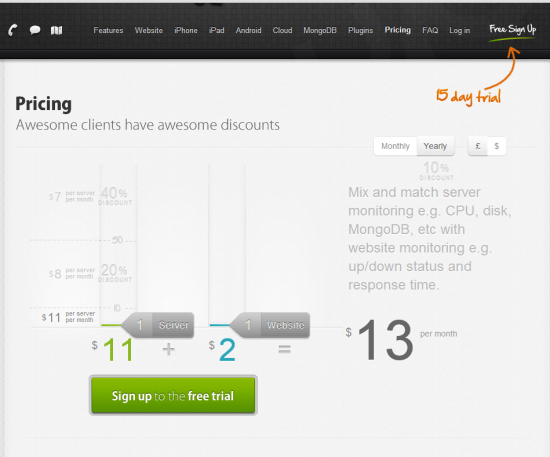
Kissmetrics offers great examples from real businesses. Image via their article , also linked below.
2. Kissmetrics Blog: How These 7 Companies Increased Revenue by an Average of 425%
You’re likely familiar with Kissmetrics, either via their product or simply based on the fact that they are one of the most reliable, respected voices in the marketing metrics space.
Their case studies are, naturally, very reliant on metrics to tell a story. This makes these case studies a must-read, as getting hard data on how sales initiatives actually improved key metrics is surprisingly hard.
Like Patel’s article, Kissmetrics dives deep into each business, and they offer a clear takeaway for each that you can apply to your own sales and marketing processes.

Modern Marketing Concepts offers a variety of case studies from their clients. ( Source .)
3. Modern Marketing Concepts: Case studies
This New York-based “sales optimization company” Modern Marketing Concepts offers perhaps some of the best sales case studies that you can find specifically from a marketing firm.
Each case study is formatted as a quick, easy to digest PDF, that touches on the challenges Modern Marketing Concepts faced, and the solutions they put into place. They also include actual data demonstrating the success of each sales initiative.
While many sales case studies tend toward the vague and fluffy, those presented by Modern Marketing Concepts actually offer something concrete. Be sure to check these ones out.
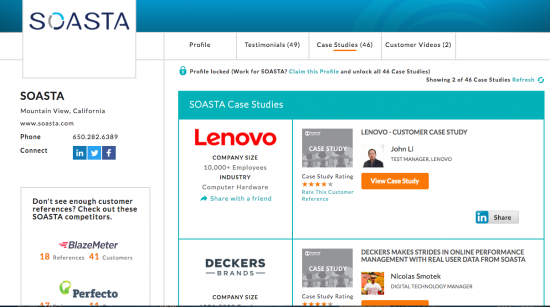
Featured Customers offers lots of case studies, like these ones from Soasta and their industry competitors. ( Source .)
4. Featured Customers: Soasta case studies, as well as competitors
Let’s get this out of the way at the outset: Featured Customers is a behemoth of a site to wade through. However, if you can navigate through all the information provided, you will actually find some great case studies to check out.
For example, following the link above will lead you to case studies from the software company Soasta, as well as their competitors. While case studies may not be the primary intended use of Featured Customers, it is a great resource to check out—if you have time to do a bit of digging.
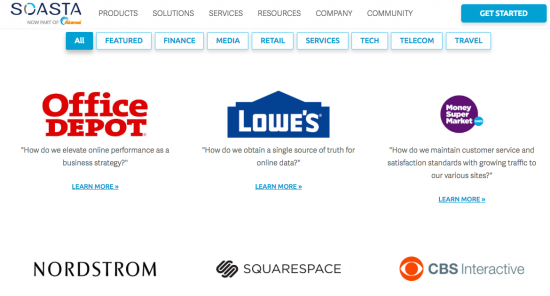
Soasta’s website offers even more of their sales case studies. ( Source .)
5. Soasta: Customers
Speaking of Soasta, going directly to their site yields tons of other great sales case studies that you should check out.
The best part? You can filter by industry—of which there are many, spanning industries from retail, to travel, to tech. Not only that, but the brands featured are some pretty big names, giving the case studies presented a level of resonance that discussion of smaller, unknown businesses might not have. Soasta’s case studies also include feedback from their customers themselves, which is definitely worth a read.
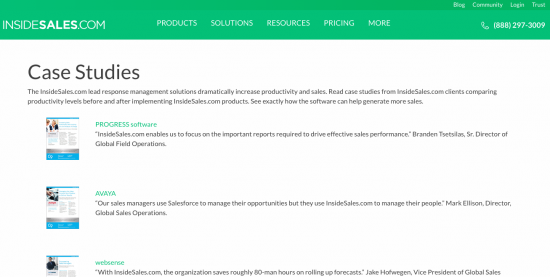
Case studies via Inside Sales.
6. Inside Sales: Sales case studies
Here, Inside Sales has collected a list of case studies from their customers, which discuss how the businesses they have worked with have managed to increase their productivity levels after implementing the products Inside Sales offers.
The case studies presented here are succinct and informative; they clearly lay out the challenges facing the business, the solutions Inside Sales implemented, and the eventual results.
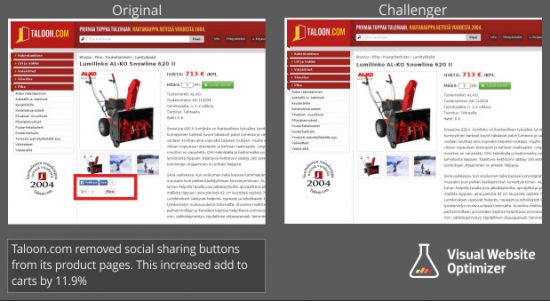
Core DNA shares case studies specifically from ecommerce businesses. ( Source .)
7. Core DNA: 7 eCommerce Case Studies You Need to Steal From
If you run an ecommerce business, your sales needs and strategies will likely differ from those of entrepreneurs who run a brick and mortar business. So, checking out some ecommerce specific case studies is a good idea.
Now, this is not the only entry on this list that shows case studies from ecommerce businesses, but it is framed from the standpoint of a discussion of the metrics that matter specifically to ecommerce businesses. So, definitely check this one out if that is your business type.
Now that you have spent some time reading sales case studies, it’s time to create your own
Wait, what?
Seriously. You have seen how powerful a tool case studies can be for businesses; with that in mind, it’s a good idea to consider creating some case studies of your own.
Case studies make fantastic promotional tools when done correctly. You are spending tons of time researching sales processes and becoming a better salesperson so that you can generate more clients and revenue for your business—you should be putting that effort to work for you even in the future.
You can feature client case studies on your website, in marketing materials, and even use them as part of your sales pitch . Just like that, you’ve created a feedback loop in which the work you are doing now to better your sales ability will continue to benefit you in the future, driving more sales.
One of the biggest benefits of featuring your sales case studies is that they allow you to build a narrative. Storytelling is powerful, and the more you can tell a compelling story for your prospective customers, the better. So, frame your case study in such a way that you really highlight the story and paint a picture that shows all the ways hiring your business helped this other business grow and improve. By doing so, you’ll be leveraging storytelling and social proof, which makes a simple cold outreach call or email markedly more likely to be well-received.
For more on sales tactics, hiring sales staff for your team, and great resources to check out to help you improve your sales chops, check these recent articles out:
- How to Deliver a Great Sales Pitch
- How to Close a Sale: 5 Tips to Help You Secure More Business
- The 11 Best Sales Techniques [Plus Formulas You Can Use Today]
- How to Write a Follow up Email That Clients Will Respond To
- Sales Definitions: The Ultimate A to Z Guide
- The Sales Pipeline, Explained
- Hiring a Sales Team: What Roles to Fill (and How to Decide If You Really Need One)
- 31 Sales Questions to Help You Hire a Salesperson for Your Team
- Sell Me This Pen: Why You Should Always See Potential Sales Hires In Action
- The Best Sales Books for Entrepreneurs to Read in 2018
- How to Find Email Addresses for Anyone
- How to Choose the Best Sales Dashboard
Which case study did you find the most valuable to read, or do you have one to add to this list? Leave a comment and let me know.
Get Our $270M Client Proposal Kit (free)

- Created from research of 25,000 proposals worth $270M
- Used by top agencies to land high paying clients
- Includes templates, worksheets, cover page designs, and more
Hey there! Free trials are available for Standard and Essentials plans. Start for free today.
What Is a Case Study and Why You Should Use Them
Case studies can provide more insights into your business while helping you conduct further research with robust qualitative data analysis to learn more.
If you're in charge of running a company, then you're likely always looking for new ways to run your business more efficiently and increase your customer base while streamlining as many processes as possible.
Unfortunately, it can sometimes be difficult to determine how to go about implementing the proper program in order to be successful. This is why many business owners opt to conduct a case study, which can help significantly. Whether you've been struggling with brand consistency or some other problem, the right case study can identify why your problem exists as well as provide a way to rectify it.
A case study is a great tool that many businesses aren't even aware exists, and there are marketing experts like Mailchimp who can provide you with step-by-step assistance with implementing a plan with a case study. Many companies discover that not only do they need to start a blog in order to improve business, but they also need to create specific and relevant blog titles.
If your company already has a blog, then optimizing your blog posts may be helpful. Regardless of the obstacles that are preventing you from achieving all your professional goals, a case study can work wonders in helping you reverse this issue.

What is a case study?
A case study is a comprehensive report of the results of theory testing or examining emerging themes of a business in real life context. Case studies are also often used in the healthcare industry, conducting health services research with primary research interest around routinely collected healthcare data.
However, for businesses, the purpose of a case study is to help small business owners or company leaders identify the issues and conduct further research into what may be preventing success through information collection, client or customer interviews, and in-depth data analysis.
Knowing the case study definition is crucial for any business owner. By identifying the issues that are hindering a company from achieving all its goals, it's easier to make the necessary corrections to promote success through influenced data collection.
Why are case studies important?
Now that we've answered the questions, "what is a case study?" Why are case studies important? Some of the top reasons why case studies are important include:

- Understand complex issues: Even after you conduct a significant amount of market research , you might have a difficult time understanding exactly what it means. While you might have the basics down, conducting a case study can help you see how that information is applied. Then, when you see how the information can make a difference in business decisions, it could make it easier to understand complex issues.
- Collect data: A case study can also help with data tracking . A case study is a data collection method that can help you describe the information that you have available to you. Then, you can present that information in a way the reader can understand.
- Conduct evaluations: As you learn more about how to write a case study, remember that you can also use a case study to conduct evaluations of a specific situation. A case study is a great way to learn more about complex situations, and you can evaluate how various people responded in that situation. By conducting a case study evaluation, you can learn more about what has worked well, what has not, and what you might want to change in the future.
- Identify potential solutions: A case study can also help you identify solutions to potential problems. If you have an issue in your business that you are trying to solve, you may be able to take a look at a case study where someone has dealt with a similar situation in the past. For example, you may uncover data bias in a specific solution that you would like to address when you tackle the issue on your own. If you need help solving a difficult problem, a case study may be able to help you.
Remember that you can also use case studies to target your audience . If you want to show your audience that you have a significant level of expertise in a field, you may want to publish some case studies that you have handled in the past. Then, when your audience sees that you have had success in a specific area, they may be more likely to provide you with their business. In essence, case studies can be looked at as the original method of social proof, showcasing exactly how you can help someone solve their problems.
What are the benefits of writing a business case study?
Although writing a case study can seem like a tedious task, there are many benefits to conducting one through an in depth qualitative research process.

- Industry understanding: First of all, a case study can give you an in-depth understanding of your industry through a particular conceptual framework and help you identify hidden problems that are preventing you from transcending into the business world.
- Develop theories: If you decide to write a business case study, it provides you with an opportunity to develop new theories. You might have a theory about how to solve a specific problem, but you need to write a business case study to see exactly how that theory has unfolded in the past. Then, you can figure out if you want to apply your theory to a similar issue in the future.
- Evaluate interventions: When you write a business case study that focuses on a specific situation you have been through in the past, you can uncover whether that intervention was truly helpful. This can make it easier to figure out whether you want to use the same intervention in a similar situation in the future.
- Identify best practices: If you want to stay on top of the best practices in your field, conducting case studies can help by allowing you to identify patterns and trends and develop a new list of best practices that you can follow in the future.
- Versatility: Writing a case study also provides you with more versatility. If you want to expand your business applications, you need to figure out how you respond to various problems. When you run a business case study, you open the door to new opportunities, new applications, and new techniques that could help you make a difference in your business down the road.
- Solve problems: Writing a great case study can dramatically improve your chances of reversing your problem and improving your business.
- These are just a few of the biggest benefits you might experience if you decide to publish your case studies. They can be an effective tool for learning, showcasing your talents, and teaching some of your other employees. If you want to grow your audience , you may want to consider publishing some case studies.
What are the limitations of case studies?
Case studies can be a wonderful tool for any business of any size to use to gain an in-depth understanding of their clients, products, customers, or services, but there are limitations.
One limitation of case studies is the fact that, unless there are other recently published examples, there is nothing to compare them to since, most of the time, you are conducting a single, not multiple, case studies.
Another limitation is the fact that most case studies can lack scientific evidence.

Types of case studies
There are specific types of case studies to choose from, and each specific type will yield different results. Some case study types even overlap, which is sometimes more favorable, as they provide even more pertinent data.
Here are overviews of the different types of case studies, each with its own theoretical framework, so you can determine which type would be most effective for helping you meet your goals.
Explanatory case studies
Explanatory case studies are pretty straightforward, as they're not difficult to interpret. This type of case study is best if there aren't many variables involved because explanatory case studies can easily answer questions like "how" and "why" through theory development.
Exploratory case studies
An exploratory case study does exactly what its name implies: it goes into specific detail about the topic at hand in a natural, real-life context with qualitative research.
The benefits of exploratory case studies are limitless, with the main one being that it offers a great deal of flexibility. Having flexibility when writing a case study is important because you can't always predict what obstacles might arise during the qualitative research process.
Collective case studies
Collective case studies require you to study many different individuals in order to obtain usable data.
Case studies that involve an investigation of people will involve many different variables, all of which can't be predicted. Despite this fact, there are many benefits of collective case studies, including the fact that it allows an ongoing analysis of the data collected.
Intrinsic case studies
This type of study differs from the others as it focuses on the inquiry of one specific instance among many possibilities.
Many people prefer these types of case studies because it allows them to learn about the particular instance that they wish to investigate further.
Instrumental case studies
An instrumental case study is similar to an intrinsic one, as it focuses on a particular instance, whether it's a person, organization, or something different.
One thing that differentiates instrumental case studies from intrinsic ones is the fact that instrumental case studies aren't chosen merely because a person is interested in learning about a specific instance.

Tips for writing a case study
If you have decided to write case studies for your company, then you may be unsure of where to start or which type to conduct.
However, it doesn't have to be difficult or confusing to begin conducting a case study that will help you identify ways to improve your business.
Here are some helpful tips for writing your case studies:
1. Your case study must be written in the proper format
When writing a case study, the format that you should be similar to this:

Administrative summary
The executive summary is an overview of what your report will contain, written in a concise manner while providing real-life context.
Despite the fact that the executive summary should appear at the beginning of your case studies, it shouldn't be written until you've completed the entire report because if you write it before you finish the report, this summary may not be completely accurate.
Key problem statement
In this section of your case study, you will briefly describe the problem that you hope to solve by conducting the study. You will have the opportunity to elaborate on the problem that you're focusing on as you get into the breadth of the report.
Problem exploration
This part of the case study isn't as brief as the other two, and it goes into more detail about the problem at hand. Your problem exploration must include why the identified problem needs to be solved as well as the urgency of solving it.
Additionally, it must include justification for conducting the problem-solving, as the benefits must outweigh the efforts and costs.
Proposed resolution
This case study section will also be lengthier than the first two. It must include how you propose going about rectifying the problem. The "recommended solution" section must also include potential obstacles that you might experience, as well as how these will be managed.
Furthermore, you will need to list alternative solutions and explain the reason the chosen solution is best. Charts can enhance your report and make it easier to read, and provide as much proof to substantiate your claim as possible.
Overview of monetary consideration
An overview of monetary consideration is essential for all case studies, as it will be used to convince all involved parties why your project should be funded. You must successfully convince them that the cost is worth the investment it will require. It's important that you stress the necessity for this particular case study and explain the expected outcome.
Execution timeline
In the execution times of case studies, you explain how long you predict it will take to implement your study. The shorter the time it will take to implement your plan, the more apt it is to be approved. However, be sure to provide a reasonable timeline, taking into consideration any additional time that might be needed due to obstacles.
Always include a conclusion in your case study. This is where you will briefly wrap up your entire proposal, stressing the benefits of completing the data collection and data analysis in order to rectify your problem.
2. Make it clear and comprehensive
You want to write your case studies with as much clarity as possible so that every aspect of the report is understood. Be sure to double-check your grammar, spelling, punctuation, and more, as you don't want to submit a poorly-written document.
Not only would a poorly-written case study fail to prove that what you are trying to achieve is important, but it would also increase the chances that your report will be tossed aside and not taken seriously.
3. Don't rush through the process
Writing the perfect case study takes time and patience. Rushing could result in your forgetting to include information that is crucial to your entire study. Don't waste your time creating a study that simply isn't ready. Take the necessary time to perform all the research necessary to write the best case study possible.
Depending on the case study, conducting case study research could mean using qualitative methods, quantitative methods, or both. Qualitative research questions focus on non-numerical data, such as how people feel, their beliefs, their experiences, and so on.
Meanwhile, quantitative research questions focus on numerical or statistical data collection to explain causal links or get an in-depth picture.
It is also important to collect insightful and constructive feedback. This will help you better understand the outcome as well as any changes you need to make to future case studies. Consider using formal and informal ways to collect feedback to ensure that you get a range of opinions and perspectives.
4. Be confident in your theory development
While writing your case study or conducting your formal experimental investigation, you should have confidence in yourself and what you're proposing in your report. If you took the time to gather all the pertinent data collected to complete the report, don't second-guess yourself or doubt your abilities. If you believe your report will be amazing, then it likely will be.
5. Case studies and all qualitative research are long
It's expected that multiple case studies are going to be incredibly boring, and there is no way around this. However, it doesn't mean you can choose your language carefully in order to keep your audience as engaged as possible.
If your audience loses interest in your case study at the beginning, for whatever reason, then this increases the likelihood that your case study will not be funded.
Case study examples
If you want to learn more about how to write a case study, it might be beneficial to take a look at a few case study examples. Below are a few interesting case study examples you may want to take a closer look at.
- Phineas Gage by John Martin Marlow : One of the most famous case studies comes from the medical field, and it is about the story of Phineas Gage, a man who had a railroad spike driven through his head in 1848. As he was working on a railroad, an explosive charge went off prematurely, sending a railroad rod through his head. Even though he survived this incident, he lost his left eye. However, Phineas Gage was studied extensively over the years because his experiences had a significant, lasting impact on his personality. This served as a case study because his injury showed different parts of the brain have different functions.
- Kitty Genovese and the bystander effect : This is a tragic case study that discusses the murder of Kitty Genovese, a woman attacked and murdered in Queens, New York City. Shockingly, while numerous neighbors watched the scene, nobody called for help because they assumed someone else would. This case study helped to define the bystander effect, which is when a person fails to intervene during an emergency because other people are around.
- Henry Molaison and the study of memory : Henry Molaison lost his memory and suffered from debilitating amnesia. He suffered from childhood epilepsy, and medical professionals attempted to remove the part of his brain that was causing his seizures. He had a portion of his brain removed, but it completely took away his ability to hold memories. Even though he went on to live until the age of 82, he was always forced to live in the present moment, as he was completely unable to form new memories.
Case study FAQs
When should you do a case study.
There are several scenarios when conducting a case study can be beneficial. Case studies are often used when there's a "why" or "how" question that needs to be answered. Case studies are also beneficial when trying to understand a complex phenomenon, there's limited research on a topic, or when you're looking for practical solutions to a problem.
How can case study results be used to make business decisions?
You can use the results from a case study to make future business decisions if you find yourself in a similar situation. As you assess the results of a case study, you can identify best practices, evaluate the effectiveness of an intervention, generate new and creative ideas, or get a better understanding of customer needs.
How are case studies different from other research methodologies?
When compared to other research methodologies, such as experimental or qualitative research methodology, a case study does not require a representative sample. For example, if you are performing quantitative research, you have a lot of subjects that expand your sample size. If you are performing experimental research, you may have a random sample in front of you. A case study is usually designed to deliberately focus on unusual situations, which allows it to shed new light on a specific business research problem.
Writing multiple case studies for your business
If you're feeling overwhelmed by the idea of writing a case study and it seems completely foreign, then you aren't alone. Writing a case study for a business is a very big deal, but fortunately, there is help available because an example of a case study doesn't always help.
Mailchimp, a well-known marketing company that provides comprehensive marketing support for all sorts of businesses, can assist you with your case study, or you can review one of their own recently published examples.
Mailchimp can assist you with developing the most effective content strategy to increase your chances of being as successful as possible. Mailchimp's content studio is a great tool that can help your business immensely.
- Browse All Articles
- Newsletter Sign-Up

- 05 Dec 2023
- Cold Call Podcast
What Founders Get Wrong about Sales and Marketing
Which sales candidate is a startup’s ideal first hire? What marketing channels are best to invest in? How aggressively should an executive team align sales with customer success? Senior Lecturer Mark Roberge discusses how early-stage founders, sales leaders, and marketing executives can address these challenges as they grow their ventures in the case, “Entrepreneurial Sales and Marketing Vignettes.”

- 22 Feb 2021
Reaching Today's Omnichannel Customer Takes a New Sales Strategy
For salespeople working harder than ever to stay ahead of customers' evolving buying habits, Frank Cespedes offers timeless advice in his new book, Sales Management That Works. Open for comment; 0 Comments.

- 04 May 2020
- Research & Ideas
Predictions, Prophets, and Restarting Your Business
Businesses are starting to plan their re-entry into the market, but how do they know what that market will look like? Frank V. Cespedes warns against putting too much trust in forecasters. Open for comment; 0 Comments.

- 22 Oct 2019
Use Artificial Intelligence to Set Sales Targets That Motivate
Setting sales targets has always been an inexact science, with serious consequences if done poorly. Using AI-based advanced analytics might be the answer, argues Doug Chung. Open for comment; 0 Comments.

- 30 Jun 2019
- Working Paper Summaries
The Comprehensive Effects of Sales Force Management: A Dynamic Structural Analysis of Selection, Compensation, and Training
When sales forces are well managed, firms can induce greater performance from them. For this study, the authors collaborated with a major multinational firm to develop and estimate a dynamic structural model of sales employee responses to various management instruments like compensation, training, and recruiting/termination policies.

- 22 Apr 2019
Why Salespeople Struggle at Leading
When salespeople become managers, they often do a horrible job. Four key steps can help them—and all soon-to-be managers—make the shift, says Frank V. Cespedes. Open for comment; 0 Comments.

- 09 Aug 2018
Two Million Fake Accounts: Sales Misconduct at Wells Fargo
Coming out of the financial crisis, Wells Fargo was one of the world’s most successful banks. But then its sales culture went wild, opening more than 2 million fake accounts. Suraj Srinivasan discusses what went wrong. Open for comment; 0 Comments.

- 09 Jul 2018
Overcoming the Challenges of Selling Brand New Technology (Hey, Need a 3-D Printer?)
Selling technology that is new to the market involves tricky tradeoffs around prospect targeting, channels, and tactics. Frank Cespedes makes the point with 3-D printers. Open for comment; 0 Comments.

- 06 Jun 2018
Cut Salaries or Cut People? The Best Way to Survive a Downturn
When times are tight, companies usually respond with employee layoffs. But what if they held on to workers and cut their salaries instead? New research by Christopher Stanton and colleagues has the answer. Open for comment; 0 Comments.
- 29 Apr 2018
Analyzing the Aftermath of a Compensation Reduction
This study of the effects of compensation cuts in a large sales organization provides a unique lens for analyzing the link between compensation schemes, worker performance, and turnover.
- 06 Jul 2017
Do All Your Detailing Efforts Pay Off? Dynamic Panel Data Methods Revisited
Personal selling in the form of detailing to physicians is the main go-to-market practice in the pharmaceutical industry. This paper provides a practical framework to analyze the effectiveness of detailing efforts. The method and empirical insights can help firms allocate sales-force resources more efficiently and devise optimal routes and call-pattern designs.
- 05 Apr 2017
For Women Especially, It Pays to Know What Car Repairs Should Cost
Consumers can negotiate cheaper auto repair prices by convincing service reps they know something about market rates—helping women overcome gender discrimination, according to recently published research by Ayelet Israeli and co-authors. Open for comment; 0 Comments.
- 22 Mar 2017
What's the Ideal Frequency for a Sales Quota?
Sales reps feed on two forms of compensation: salary, and a bonus tied to achieving a periodic quota. Would a more frequent quota incentivize better numbers? Doug Chung and Das Narayandas offer some answers. Open for comment; 0 Comments.
- 20 Feb 2017
Where Should We Build a Mall? The Formation of Market Structure and Its Effect on Sales
In spite of the recent surge in e-commerce, brick-and-mortar retail, specifically in the form of large-scale shopping malls, is still the dominant venue for consumer purchases in the developed world. The construction of mass-scale shopping malls has also experienced tremendous growth in newly industrialized countries such as China. This research provides a rigorous, yet practical, framework to understand and evaluate why retail stores join a shopping mall and how their decisions affect mall revenue. The model can be extended and applied to a number of settings where a decision maker must choose among alternative sites to construct a market, for example, for transportation hubs such as airports or train stations.
- 25 Jan 2017
The Effects of Quota Frequency on Sales Force Performance: Evidence from a Field Experiment
This study of different sales quotas and their effect on sales performance at a major retail chain in Sweden finds that changing from a monthly to a daily quota plan increases performance mainly for low-performing salespeople.
- 06 Dec 2016
Assortment Rotation and the Value of Concealment
Assortment rotation is the retailing practice of changing the assortment of products offered to customers throughout a selling season. It is used by both brick-and-mortar and online retailers as a strategy for gaining competitive advantage. This paper studies assortment rotation in product categories such as apparel, accessories, and toys, where consumers typically make multiple purchases during a season. The authors identify and explain a new reason for retailers to frequently rotate their assortment: Consumers may purchase more products throughout the selling season if a retailer conceals a portion of its full product catalog from consumers by rotating its assortment. Aside from its scholarly contributions, the paper provides practical insights to retailers to guide their assortment rotation strategy decisions.
- 21 Nov 2016
It Matters That Your CEO Doesn't Know Much About Sales
Sales appears to be getting short-changed in the C-suite, says Frank Cespedes. What’s needed are more links between top executives and the customer-facing side of the business. Open for comment; 0 Comments.
- 28 Mar 2016
Do Incentive Plans for Exemplary Employees Lead to Productive or Counterproductive Outcomes?
This study of a mobile phone retail company shows that incentive contracts that selectively incentivize exemplary employees (that is, preferential incentive plans) may be helpful when companies want to motivate employees to pursue objectively measured goals in addition to relevant tasks not explicitly written into their contracts. However, preferential incentive plans may lead to unintended consequences if they trigger perceptions of inequity.
- 08 Sep 2014
The Strategic Way To Hire a Sales Team
The equivalent of an entire sales force is replaced at many firms every four years, so it's critical that go-to-market initiatives remain tied to strategic goals. Frank Cespedes explains how in his book, Aligning Strategy and Sales. Closed for comment; 0 Comments.
- 01 Apr 2013
First Minutes are Critical in New-Employee Orientation
Employee orientation programs ought to be less about the company and more about the employee, according to new research by Daniel M. Cable, Francesca Gino, and Bradley R. Staats. Closed for comment; 0 Comments.
Case Studies & How to Use Them in Your Marketing Funnel
- March 1, 2022
Since our bootstrapped beginning, we’ve been using Drift to communicate with and convert our web traffic.
Our company’s original offer? Book a free consultation, and get a free article for your business – no strings attached.
We signed 7 clients in the first month with a newly-launched website, Drift’s chatbox, and that awesome offer. This lead generation offer worked well for us for over two years!
Drift’s case studies convinced us their software would be the perfect addition to our lead generation process.
Having never even heard of Drift in the past, we needed to make a choice based on recommendations.
After our head web developer recommended looking into Drift, the company’s case studies sold us on it being the solution we should get behind.
Thanks, Luke!
But let’s get back to the facts.
Drift educates its visitors with success stories and you can too. But first, you need to learn more about case studies.
Let’s define case studies and explore how you can use them as part of your sales funnels.
What is a Case Study?
What are case studies?
For starters, a case study is arguably the ultimate form of storytelling. Likely because these break-downs use real-world data to tell a story with a purpose.
Best practices for a study case may include some research. But the majority of that research involves analyzing cases in which your product, service, company, etc. solved a real-life problem.
You could show how a real customer overcame something by using your products or services. However, the key here is to make your case study easy for customers to see themselves; you want them to see themselves achieving their own goals or dodging potential issues.
Case studies are exploratory analyses of real-world instances. They give social proof of the success – or failure – they can experience, and they can be quite enticing when placed in front of the right eyes.
Case studies are one of the best tools for marketing. While this content format isn’t an advertisement, it certainly can promote new products or features or become a pivotal part of your marketing funnel.
Whether posting a study on social media or planning to use them in the development of a sales funnel, business owners use case studies to examine and explain with real data. Regardless of what industry you’re in, you can use a case study to exemplify your business as the answer to your customers’ problems.
But the content isn’t about you; it’s about your customer – the development of a hero overcoming a problem.
Why are Case Studies Important?
Why are case studies useful, anyway?
Case studies are particularly essential for businesses for marketing purposes. These showcase the success that businesses have had with other customers. Rather than discussing what a product or service does, business operators can show use instances in which customers or clients have experienced benefits from certain offerings.
Ultimately, case studies go a long way in convincing people why they should become customers. With the right case study, a potential customer can envision their own success using a business’s products or services, which makes case studies some of the strongest marketing materials available in our entrepreneurial arsenal.
SaaS companies , in particular, benefit from having loads of case studies. Knowledge base content is also essential. However, other operations experience similar success with the right insights.
How to Approach Case Studies
How do you write a case study, anyways?
As one of the most authentic forms of content available, case studies can be rather demanding. The key here is to gather the right data and resources.
Who is your target audience and what do these people need to see? What incredible development did your customer make and how will it convince potential customers to pay you?
You may want to show how your services helped your clients do something extraordinary in some cases. Or perhaps you’re more interested in explaining how your current practices may be better than your other outdated processes.
Some businesses show the development of their industry through case studies. Others focus on data pertaining to some sort of social experiment.
Regardless of the focus, these tips help while writing captivating case studies:
1. Build out a narrative in each of your cases
The most effective marketing on the planet tells a story. Make sure the stories in your cases follow a narrative format.
What does this even mean? Well, for starters, give the story a beginning, a middle, and an end.
Conduct some research on your target audience to ensure you’re not wasting time showing a minor problem that doesn’t need solving. You’ll start by introducing the customer and the problem they need to solve.
Follow this with what pushed the customer to find your company.
Tell the customer’s story. What drove them to find you? Focus on the customer’s woes as opposed to how you’re going to solve them.
Cases with direct quotes from the customer can also add to the authenticity. It’s always good to establish trust through the content you publish, and this is a prime opportunity.
Conclude your story with hard data. Your cases can include statistical data to show how effective your company was at solving the customer’s problem.

2. Drive case studies with data
The headline compels a click, and the story keeps people reading. However, without data, you’re just blowing smoke.
You’ll need more data for a case study, of course. Way more than with other content formats.
Your audience wants to see what’s possible.
Include screenshots of real performance metrics, in-depth charts, documentation of the effectiveness of your practices, and other convincing data whenever applicable.

3. Keep your target audience in mind
Data is great. But in many cases, people bore their audience to death without even realizing it.
Your story should include a compelling angle specifically for your target audience.
Too vague and you won’t convince; it has to be specific.
What are your customers accomplishing by using your resources? How can you relate this success to your target customer’s goals?
For example, if you’re doing a case study on how a plumber hired your services to generate more leads, you might want to title it, “How ________ Helped Plumbers-R-Us Unclog Lead Funnel for a 300% Increase in Leads in 3 Months!”
Your angle ‘hooks’ your audience by offering something relatable, entertaining, and valuable. Consider your core demographics and target customers, and use a customer story to show how your ideal customer can solve common problems with your product or service.

4. Focus on the customer’s story
Your business is not the hero in this story. Rather, it plays a supporting role.
Keep the focus on the problems and how your customer – the hero – solved them using you and your brand.
You’re not selling; you’re showing how smart people use your resources to help solve their problems.

5. Give your customer the chance to speak
Your customers are more reputable when it comes to discussing your brand. Encourage them to tell their own narrative using their own words.
Direct quotes can offer the customer’s perspective. And this could help your ideal customers relate to your current customer even further.
Think interview format, but let the client speak. Let the customer’s quote stand on its own – without repeating what they said in a follow-up sentence.
How to Use a Case Study at the Start of Your Marketing Funnel
The first stage in a marketing funnel is to help people recognize a problem. Fortunately, case studies are excellent for highlighting problems and ways to improve.
Showing a case study that features a common problem your customers have reveals a need potential customers might not even know exists. This could entice your ideal customer to conduct some research – research that could lead them all the way through your marketing funnel.
For example, if your business provides social media marketing services to website owners, you could perform a case study.
Let’s say the study includes how one of your customers increased MRR from $500 to $5,000 using your service to expand their reach on Facebook, Instagram, Quora, and Pinterest. This could be enough to warm a lead at the start of your funnel.
While advertising this case study on Facebook, a potential lead could notice it and realize they haven’t been marketing via social media. They click on the ad, learn about your success solving their recently-revealed problem, and become a lead.
Congratulations! Your lead has just made its way through the first stage of this marketing funnel.
While these leads will need some nurturing, this is only the first step in your marketing funnel. But this is just the beginning of where you can use this content.
How to Use a Case Study in the Bottom of Your Marketing Funnel
The right case study can influence purchasing decisions. With this being the case, it’s possible to use this content to convert customers long after they’ve heard about your brand.
You’ve already highlighted a problem and demonstrated how people have used your company to solve it. You’ve been supplying information in accord with what your leads are looking for, and even given an evaluation of alternative solutions to the problem.
Now it’s time to influence the purchase decision with a case study.
This is your opportunity to make a lasting impression in the minds of your potential buyers. An incredible case study will show your audience exactly what you’re capable of and demonstrate what it’s like to work with your company.
You can explain your practices and how using your resources has solved problems for your customers. You can go even further to show the sort of gain a customer has experienced with you.
A digital marketing agency helped a university reach 310% more students than last semester. That’s a case study you’ll want to put in front of other universities’ decision-makers.
A pressure washing company that made that same university a 5% increase in admissions by improving its aesthetic. This study is something university decision-makers should see, as well.
Shortly put, great case studies go a long way in convincing decision-makers to convert – and you can use one at the bottom of your marketing funnel.
Other businesses successfully use case studies to stand out from the competition. Are you?
Ready to create a lead-driving case study? Let’s speak strategy.
The NSC team creates and implements content strategies on behalf of our clients every month, including case study creation. We’re ready to do the same for you.
Get in touch to schedule your complimentary, no-obligation consultation and learn how we’ll scale your business’s traffic, engagement, and sales with content marketing.
Related Posts:
![How to Develop Your SaaS Content Marketing Strategy [The Ultimate Build-Out Guide] saas content marketing cover image](https://nostringscontent.com/wp-content/uploads/2020/07/saas-content-marketing-cover-image.png)
No Strings Content
Your strategy should scale your success. We’ll analyze your business, your competition, your content, and your audience to plan and execute your search engine marketing strategy.
© No Strings Content, All rights reserved. 2024
Made with ❤️ and 🙏 by luke.

Business Value Selling
Sales Leader Effectiveness
Growth & Talent Strategy
Enablement Outsourcing
- Enablement Strategy
Sales Compensation
- Sales Training
YOU'RE IN GOOD COMPANY
Partnering with industry leaders.
Our proven approach creates sustainable results for organizations across a diverse set of industries, sales models, and challenges.
Business & Professional Services | Consumer Goods & Services | Finance | Healthcare | Manufacturing | Technology
Business & Professional Services
Case study: sales training & sales leadership.
As one of the world's premier professional services firm, BDO delivers assurance, tax, and advisory services to clients around the globe. We have worked in close partnership with senior leadership to support the firm's multi-year growth strategy.
Our focus has been strengthening BDO's business development culture, processes, and skillsets. We created the firm's first sales methodology, customized to meet the needs of BDO's unique partner-led sales model. This approach supported a focused on elevating the conversation with sophisticated decision-makers and navigating complex, consensus-driving buying journeys.
In addition, we created a wide range of highly tailored training programs, including a year-long coaching and development academy for new partners. Other projects have included development of go-to-market strategies for new practices, business developer compensation and role design, and major pursuit coaching. During our partnership, firm revenue has more than doubled thanks to higher win rates, larger deal sizes, and expansion into new markets.

CASE STUDY: SALES METHODOLOGY & TRAINING

CHI is a global leader in the business travel industry – providing travel management, meeting and event services, and business travel consulting. While they have made significant investments in sales resources to build a presence in a high-profile market segment, the company lacked a consistent sales process. They sought our help in creating a “Way of Sales” for their global sales organization and a comprehensive sales onboarding program for new hires.
Our approach involved the development of a full “Way of Sales” program that included the development of a core sales process, supporting tools, sales training, and a sales coaching program aligned to a new sales management cadence. Specific focus included a sales process and playbook that supported fully-customized solutions for smaller niche segments. We also developed a high-impact conversation guide to enable greater messaging consistency as well as a sales leader playbook and coaching guide to structure team conversations. Finally, a training roadmap outlined the new hire learning journey that included modular training content for webinars and targeted instructor-led training sessions. Recently, we were reengaged to provide strategic advisory support related to their sales incentive plans.
CASE STUDY: GROWTH TRANSFORMATION
Constellation Energy is a national provider of power, gas, distributed generation in the deregulated energy sector. We have partnered with the company in a series of projects spanning the areas of sales team merger integration, customized business value sales process, and sales training.
A major focus was the standardization of selling and coaching processes. Sellers were pursuing the wrong decision-makers, encountering indirect challenges with brokers, presenting poorly developed cases for change, not clearly articulating value propositions, not developing compelling business drivers, and inefficiently moving the customer through the decision process. We developed a new coaching approach anchored to a set of standard processes and delivered practical training for the sales management and sellers.
Following this work, opportunity management effectiveness grew significantly as measured by higher close rates. Related training sessions were also well received, receiving the highest rating of any portion of the SKO agenda three years in a row.

Cox Automotive is the largest provider of technology solutions for manufacturers and dealers. Having grown rapidly by acquisition, the company faced multiple, individual sales forces without a unified go-to-market approach or methodology. Leadership wanted to develop a single sales team bringing holistic solutions for clients.
Our approach began with structured discovery that then bridged to a collaborative design process for crafting a custom enterprise account management methodology. We also integrated processes and tools for account and territory planning, opportunity management, relationship growth, and consultative selling. This methodology ultimately spanned 14 customized specific processes, multiple new roles, underlying tools, and CRM integration.
The new Client Success dealer sales organization now drives steady revenue growth and greater win rates. Voice of customer research also indicates that decision-makers now have a better understanding of the full Cox solution portfolio.
CASE STUDY: SALES ENABLEMENT STRATEGY

Extended Stay Hotels is the largest owner/operator of company-branded hotels in North America with over 650 hotels. We were engaged to help drive an organizational redesign of the sales team and bring leading practices around their many channels of business.
The project started with a selling skills assessment to define future skills, which guided development of a new onboarding strategy. This included developing the right sales process training materials and leadership cadence. Our approach also involved designing a sales compensation strategy for the team. After redefining key roles and expanding its centralized sales team, the company successfully realigned sales resources to sell to key clients and capitalize on market opportunities.
The company met or exceeded revenue targets in the 2+ quarters following our engagement, which is a testament to the renewed focus on driving customer value and providing a rewarding place to work for its sales team.

IHG has a global portfolio of hospitality brands spanning 4,400 hotels across 100 countries. IHG’s sales team positions their products to a diverse set of B2B customers seeking meeting space and corporate travel agreements. In response to changing markets, IHG sought to elevate its sales force and processes to support both on-property and corporate salespeople.
We were engaged to assess the alignment of their global sales organization, go-to-market strategy, org design, and pipeline culture. This work included analyzing their 1000+ tiered customer base to define a new go-to-market strategy and org design to maximize revenue and customer value. We also re-architected their sales structure and accounts/territories to align resources against market and account potential. Finally, this engagement deployed a “Way of Sales” insight-based sales methodology.
As result, IHG saw accelerated growth in their key segments. Additionally, key global sales leaders felt confident in their properties and energized by the selling story we created together.

PAG is a leading provider of inventory-supported MRO services for aircraft. The company engaged us to develop and deploy a custom sales methodology, a need triggered by fast-growth and an acquisition.
Because PAG’s customers run the gamut from single aircraft owners to corporate fleets, we focused on creating a process aligned to the unique needs of different customer segments and service offerings. A larger objective was establishing a stronger long-term revenue growth mindset. The new opportunity management and account management methodology centered on elevating the level of customer interactions, deepening seller understanding of their customers’ businesses, and executing more disciplined account planning. We then partnered to deploy these concepts via collaborative workshops that avoided the negative connotations of traditional training “events”.
After the initial rollout, PAG continues to utilize the workshop model to review account results and strategies. During our 8+ year relationship, PAG has experienced an average 20%+ annual growth. Leveraging the new selling tools, skills, and strategies, the client has also seen dramatic growth in both the number and size of their strategic accounts.

Provista is the leading group purchasing and supply chain operations management organization in the non-acute space.
Selling into this market is complex. The Provista sales team is met with numerous competitive forces - commoditization and channel confusion coupled with sophisticated procurement and supply chain operations. The sales team needed a differentiated approach to the market.
An adaptive, situational methodology was needed to address the many changing deal factors. Our training program focused on helping the reps identify the key deal factors, prioritize and interpret the situation, and build better pursuit strategies. This situational process ultimately generates better customer results.
Our work significantly enhanced strategic selling skills across the team, resulting in more sales process discipline and more effective customer-facing messaging. This highly customized program also provided the basis for launching a formal sales enablement organization. Sales results have continued to outpace the competition.
Sotheby’s is a global auction business with a complex set of services across sales, financing, and art education. The company sought to drive greater performance in the face of increasing market pressure. We were engaged to support their journey toward increased sales productivity of their client-facing team.
After an in-depth discovery process that included interviews with global stakeholders, we redesigned their client-facing organizational structure to bring to life a culture of performance and accountability. This work included role design, sales process refinements, and a new client management program. We also customized leading and lagging indicators as part of future scorecard development. Finally, we created a longer-term sales effectiveness roadmap that outlined a series of actions to institutionalize the new behaviors and capabilities over the long-term.

CASE STUDY: SALES LEADERSHIP

Sunbelt Rentals is one of the largest commercial and industrial equipment rental companies in North America. Experiencing significant growth, they needed to quickly scale their sales leadership to capitalize on market opportunities.
We partnered together to design a custom sales leadership development program. The objective was to upskill the sales management skills of the incumbent, operationally-focused leaders and to accelerate the onboarding of new leaders. Our approach included creation of new territory and account planning processes and a refresh of core sales process elements. We also developed a sales management and coaching playbook to help leaders more effectively diagnose and address team performance gaps. The project included design of a national deployment strategy that involved a series of 2-day instructor-led workshops.
As a result of this work, Sunbelt experienced a significant increase in engagement from sales leaders and sales teams. The program was considered a key enabler of the company’s rapid growth in both locations and team members.
CASE STUDY: SALES PROCESS & SALES LEADERSHIP
Thomson Reuters is the leader in financial software supporting smarter investment decision-making. We were engaged in two major areas of work. The first centered on identifying priority customer profiles and re-aligning the company’s overall sales process. The second focused on elevating the company’s sales manager capabilities.
We conducted sales and customer interviews to synthesize five distinct customer personas, including their purchasing influences, buying triggers, keys to gaining preference, resources for the decision process, and major sensitivities. The personas were used to create an adaptive buyer’s journey and aligned sales process. This work also developed a top sales performer profile.
To improve sales management execution, we identified “in-the-moment” coaching opportunities across the areas of: pipeline and forecasting, territory planning, account planning, opportunity management, pre-sales call prep, sales call execution, trials, and renewals. Knowing that coaching tools were not enough, we facilitated skill development and application sessions for first-level sales managers in the US and Europe. We also led train-the-trainer sessions for the sales manager audiences in Asia and Australia. These highly-interactive, day-long sessions gathered a cross-functional set of sales managers to discuss and workshop how the coaching moments could be applied to their teams in the short and long term. Managers walked away with a personal action plan that guided their coaching and development efforts for the next quarter.

CASE STUDY: SALES COMPENSATION

Waste Management is the leading provider of environmental solutions in the country. Their large field sales team works with numerous municipalities and businesses to support business operations while maintaining a focus on the environment.
Brevet worked with HR leadership to conduct a detailed review of the company's sales compensation programs. Conducting such a review requires a deep-dive into a large and complex sales organization with many different customer-facing motions.
Our work equipped HR leadership with the strategy and data insights to partner with sales leadership in a thoughtful update of incentive plans. The recommended changes enhanced plan designs and improved field communication effectiveness. Overall results improved the alignment between field behaviors and the key business value drivers.

Washington Gas Light participates in the fast-changing unregulated competitive energy market. They needed support improving various sales operations and effectiveness elements to continue scaling their growth.
We partnered with senior sales leadership to develop a custom set of operating processes for both the utility and retail sales teams: opportunity planning, sales call planning, win/loss review, one-with-one customer meetings, and team meetings. We then facilitated a series of coaching workshop sessions to set expectations and train leaders on a new cadence for management. Two subsequent seller workshops focused on the five procedures and equipped them with a set of practical tools to support their customer engagement.
As a result of this work, sales leaders are better equipped to coach, model, and reinforce sales best practices, and sales professionals are executing more effective and consistent interactions with their leaders and customers. Overall metrics – pipeline, opportunity size, win rate, and cycle time – continue to improve.

Wolters Kluwer is a provider of global information, software, and services. We partnered with their company’s Compliance Solutions unit, which sells technology and content to banks, lenders, investment houses, and insurance companies. This newly acquired unit had a disparate sales team that faced issues with market opportunity. The client wanted to optimize coverage for their channel economics and market segment potential. They also recognized opportunities to effectively leverage partners and an inside team.
We reviewed their go-to-market/sales strategy and identified gaps and opportunities through a combination of quantitative (data analysis, comparison to benchmarks, time survey) and qualitative (interviews, survey) methods. Next, we developed a gap analysis of needs across each of the major areas of our “Way of Sales” model: structure, processes, tools, skills, compensation, metrics, sales management, and role capabilities. We identified programs and initiatives to optimize the go-to-market model while developing a roadmap and prioritization model to help evaluate the timing, sequence, and value of our recommendations.
The company immediately executed our recommendations, which aligned well with their 3-year strategic plan. After the first year, the client experienced significant YoY increases in pipeline value, speed-to-close, and win rates.
Consumer Goods

AUL sells automotive insurance plans through third-party agents to automotive dealers throughout the country. Struggling with a smaller sales team and a highly saturated market, AUL needed to improve how sellers prioritized opportunities that drive incremental sales. There were three hurdles to these efforts: no consistent sales standardization/process, limited time for all levels of potential customers, and severely outdated CRM tools.
We started with agent segmentation focused on a growth potential rating, then implemented an adaptive sales process to create a consistent sales language. We also developed CRM business requirements reflecting the new agent segmentation and new sales process. Our change strategy emphasized the alignment across the C-suite, senior sales leaders, and sellers.
As a result of this work, the company saw meaningful incremental revenue growth, reduced sales cycle time, and higher volumes of opportunities.

CASE STUDY: SALES TRAINING

Avon is a well-known privately-held B2C direct marketing organization. With declining revenues, rising representative attrition, and increased competition, the company sought to energize, engage, and educate their large, independent-operator sales team.
Our engagement developed and activated a highly structured program to improve selling, recruiting, and leadership with their sales management team. The training and management engagement toolkit included a mix of live trainings, train-the-trainer sessions, eLearning modules, and a detailed manager field coaching guide. The concepts were introduced to over 5500 team members during their annual sales conference and then packaged for deployment to educate 350k+ representatives that were unable to attend.
As a result of this work, the company saw a significant increase in the effectiveness and consistency of sales management coaching across the organization. The program also provided a lasting framework for continuous training and manager development.

Brooks is the industry leader in performance running footwear and apparel. Superior innovation, product, and marketing continue to propel this brand forward. The sales strategy is critical to delivering on a brand promise that exceeds the competition.
With one of the most tenured sales team in the industry, Brooks was looking to innovative its sales model. The goal was to maintain their competitive advantage while accelerating growth. Sales compensation is a key lever to ensure sales delivers on aggressive targets.
Brevet worked with HR and sales leadership to design and model critical compensation design changes. Our team's recommendations drove improvements in the broader sales talent structure and incentive design decisions. The result has been continued growth for a industry leader.

CASE STUDY: SALES METHODOLOGY & TRAINING

CGP is a pet, lawn, and garden supply marketer and producer that operates across fifteen countries. We have served as a trusted partner over multiple years, supporting the company’s continued growth.
Our early work involved identifying efficiencies resulting from a merger and organizational change. This included better understanding of the combined company’s customer base and creating a more proactive, consultative channel sales process. We’ve also supported the development of new value propositions, consumer and category data, and a custom “Way of Sales” methodology. Over the years, our partnership has continued with a series of sales transformation projects covering foundational sales process, sales and marketing integration, sales leadership development, role and org structure design, and account planning methodology.
Most recently, we have supported continued improvement of their management capabilities through design and facilitation of a custom leadership training academy. This “mini-MBA” program spans multiple career levels and seeks to improve the business acumen and management effectiveness of new and mid-career leaders.

Brevet's growth transformation work with the Competitor Group, which owned the Rock 'n' Roll Marathon series as well as other sports media assets, helped secure the transaction of the organization to Ironman.
We worked with the executive team and equity ownership to advise on a broader growth transformation. The goal was to maximize the potential of the core Rock 'n' Roll series brand as well as the supporting media property brands that included Women's Running, Triathlete, and VeloNews.
Our work identified a number of growth opportunities within the media business. We also focused on strategies to improve results through better sales execution in the sponsorship and registration businesses. This included more targeted sales deployment, greater sales accountability, and improved sales messaging.
The results of our engagement enabled the Competitor Group to transact at an attractive value for the equity ownership team.

CASE STUDY: ACCOUNT SEGMENTATION & TRAINING

Jarden is a global consumer products company that sells across multiple segments. The Consumer Solutions Division had grown through acquisitions and lacked a consistent line review process and definitive roles/responsibilities across product and field sales.
The previous approach was inefficient, last-minute, and generally item/price-focused. The activities were also primarily conducted by product managers, keeping them from new product innovation and more strategic sales management. To enable a better process, we designed a new customer marketing organization to work with field sales and channel sales. This enabled product managers to return to their primary role. Our project also delivered a quantitative account segmentation tool, and we trained field sales, channel sales, and customer marketing teams to run the new line review process.
As a result of this engagement, the client implemented a disciplined new line review process that included more efficient prep activities customized for customer segments, a stronger quantitative customer segmentation with easily-changeable parameters, and re-defined roles/responsibilities for all teams.
Financial Services
Case study: sales enablement strategy.

The world's leading provider of corporate payment solutions was looking to ensure they stay at the forefront of the market. Doing so requires insights into how to best enable a 5,000+ global field force.
We supported sales enablement leadership by leveraging research and insights from Brevet's Sales Enablement Maturity Model. Using our proprietary database, we conducted an assessment and benchmark study on leading and emerging sales enablement practices.
Our perspective and recommendations guided leadership to make significant investments in their enablement operations, redesign organizational structures, and refined key workflows with other functions. All while maintaining a focus on the core metrics that drive sales.

Assurant is a global, billion-dollar specialized insurance provider with various routes-to-market, including brokers, agents, distributors, and sellers. For this initiative, the focus was on a newly created mortgage solutions division. We partnered to align leaders of multiple business units to a new, well-rounded go-to-market strategy.
Our work included collecting customer insights, conducting seller interviews, and facilitating collaborative working sessions to finalize a set of go-to-market options. Once the new model was selected, we supported the activation of the new org design and other recommendations.
This effort also included training all sellers across the business units on the full ‘bag’ of products and services. As a result, new revenue synergies were generated, and the sales team was equipped to present a solutions-oriented message to joint customers.
Datasite (formerly Merrill Corporation) provides technology-enabled platforms for secure content-sharing, regulated communications, and financial disclosure services. Sales leadership faced a set of challenges, including managers being promoted without proper training, a lack of consistency in a high-velocity environment, and the need to transition from transactional selling to value selling.
We designed a customized front-line manager program that included a dynamic playbook, tools, and job aids. A major focus of the program was introducing and training a stronger management rhythm and related skills. In addition, we developed a new strategic account management program to elevate how sellers identified and prioritized the top business issues facing their customers. This approach was key in moving the company away from pure tactical sales.
Unlike “off the shelf” approaches that the client had seen from other firms, our customized manager program was extremely well-received and continues to impact the quality and consistency of sales leadership. In response to the account planning project, the strategic teams saw short-term revenue gains of over $5 million, and they are continuing to incorporate these new approaches company-wide.

The world leader in global payment solutions has grown through many acquisitions over the last 5 years. These transactions have forced the sales organization to rationalize numerous sales roles and compensation design practices as they seek to build synergies.
Working with the sales compensation leader, we advised on a key plan design parameters. We teamed with sales, HR, and finance across the various segments of the complex organization to build support for the design changes.
Our work has resulted in improved role clarity and competency requirements, continued consolidation in the number of plan designs, improved cost of sales, and gains in administration and plan governance efficiency.

Mastercard is a global payments technology pioneer operating in more than 200 countries and territories. They needed a new hire onboarding program for account managers.
Following an assessment phase, we developed a “Fast Start” new hire onboarding strategy and roadmap. This included a new seller onboarding guide and a companion manager guide that outlined their role in supporting new seller success. The program allowed the company to map the new seller experience over time using a structured framework. It also provided detailed, personalized guidance for new account managers during their first year.
Our client has implemented “Fast Start” pilot programs within each of their global regions. The feedback from both new hires and managers has been positive. Objective measures involving ramp/time-to-productivity have also increased. Full global rollout of the program continues.

Schroders is a major asset management firm operating in 28 countries. While they had experienced significant growth across institutional and intermediary business lines, competitive landscape and client expectations were rapidly evolving.
We were engaged to identify and address variances in sales processes across the customer lifecycle. The lack of consistent terminology, standard processes and practices, and globally defined insights held them back. In response, we developed and deployed a global “Schroder’s Way” of selling along with requirements to update their CRM and enabling tools. Our work centered on defining or refining their territory management, lead management, opportunity management, contact management, and account management processes.
As a result of our partnership, Schroders optimized sales team coverage, improved focus on the right accounts, and elevated pipeline and sustainable growth of the business. Our program provided a consistent language and platform for Schroder’s to continue to improve the value their team provides to clients.

We were engaged to equip their sales force to successfully engage this new segment. A major focus was developing a common business architecture to drive a single CRM system. Through a series of discovery activities and facilitated workshops, we aligned on a high-level business process narrative. We then created recommendations for their new go-to-market strategy, ultimately driving a series of sales transformation workstreams covering a customer-aligned sales process, a cross-division, internal lead management process, and territory management. To activate these changes, we built a sales management cadence and playbook, facilitated alignment of marketing and sales priorities, and defined the major KPIs.
This work was key to establishing business alignment across the US and global segments. The global building blocks continue to serve as the baseline for ongoing business process refinements. Leading indicators of sales growth have increased substantially.

Western Union, 100+ year financial services organization, faces disruption on many fronts. Growth is contingent on digital innovations and expanding their independent agent channel.
Brevet collaborated with sales leadership to design, build, and deploy a custom sales methodology to improve field rep effectiveness.
Our program focused on equipping field teams with new and improved strategies and tactics to drive growth within the independent agent channel. The methodology included tools for helping reps plan their territories and prioritize accounts. It also introduced and trained key selling skills. Additional tools and training were provided to field leaders to help them coach the new methodology.
In addition to improving new agent activations, our customized sales methodology helped establish an enhanced corporate sales enablement function.

Aflac, America’s most recognized provider of supplemental insurance, was at an inflection point within their distribution strategy. A very entrepreneurial and grass roots field team needed to evaluate its sophistication to meet the changing employer and consumer needs during the launch of the Affordable Care Act.
We partnered with Aflac to develop their first Aflac Sales Academy, a role based, robust curriculum and certification process that covered all roles from first-time seller to sales leadership.
We partnered with them to build 200+ training assets to support the seller’s journey through academy. Curriculum assets included videos, instructor led classroom, product tip sheets, eLearning, sales kickoff materials, recruiting and learning assessments. In addition, we redesigned their field selling guides to help agents navigate a more complex environment.
In addition to the field strategy, we supported the stand-up of a broker focused team that has tasked with working with the top insurance brokers and penetrating the Fortune 500.In the first year, the Sales Academy drove several positive outcomes including 8% incremental premium growth, shortened ramp time by 33%, seller retention increased 16pts, increased seller recruitment (14%)
Agiliti is the leading medical equipment management company servicing healthcare organizations across all sizes and specializations. Their services ease the pressures on overloaded nursing staff and help minimize costs of equipment management and repair.
Agiliti selected Brevet as their strategic enablement partner to develop and deliver initiatives to support a wide range of selling roles. Brevet helps facilitate a collaborative strategic planning process annually – identifying opportunities for more intentional enablement.
Strategic enablement initiatives include the activation of an account planning process and tool, planning and facilitation of multiple SKO events, seller and leader development, and realignment of roles in their go-to-market model.
A unique element of these initiatives emphasizes the role of the front-line leader. Tools and resources are developed to support leaders’ communication and reinforcement with the field.
This strategic enablement partnership creates a consistent, high-impact cadence of enablement for the field. Various selling roles are enabled to collaborate more effectively and sell larger, more complex deals.

Avante Health Solutions makes it easier and more affordable for every hospital, clinic, and medical practice to have the very best equipment, supplies, and service. We partnered with the company as they worked to integrate three sales teams into one organization.
The strategic objective was to transform the sales function to better meet the needs the changing healthcare market while optimizing call points. Working with senior leadership, our team lead the integration work to define the market opportunity, segment the current account base, build new territories, align team members, refine compensation programs, deploy quotas, and allocate targets.
Our proprietary approach to territory design and data management has given the team new insights into the market opportunity. The transformation has driven a more balanced selling approach. Allowing the reps to go deeper and broader into the market.

BenefitMall is a leading insurance broker services firm that helps brokers and carriers throughout the US enroll and manage clients. Through a series of acquisitions and rapid growth, senior leadership recognized that the front-line sales managers did not have a consistent way of leading their teams.
We were engaged to define and standardize BenefitMall’s “way of sales management”. Following an in-depth assessment of their sales management team, we delivered a customer sales management training program. This provided the front-line managers with practical skills and tools to support their teams.
The training program was well-received and has become the common language for sales managers across the organization. The company continues to see tangible results from consistent sales management as they continue to grow.
Benefytt is an insurance technology company that operates e-commerce health insurance marketplaces – allowing consumers to easily compare Medicare and private health insurance plans. In a crowded market, the company was looking to gain ground and deliver a differentiated customer experience.
Our initial engagement began by assessing the sales enablement organization’s effectiveness and training programs. Through a collaborative diagnostic, we uncovered a significant opportunity to build on the foundational selling skills developed during new agent onboarding. Agents often used the same approach with each customer. Through a series of workshops, we identified the most common customer scenarios and developed a situational selling playbook to equip agents with the knowledge, actions, language, and skills to tailor to various customers. We then activated this playbook through a series of virtual training sessions.
Our work provided the basis for new and tenured agents to more quickly recognize a customer scenario and adapt their selling approach. This helped reduce the number of lost opportunities and shortened the average sales cycle.
.jpg)
CASE STUDY: SALES MESSAGING

Brookdale is the largest senior living provider in the US with more than 1,200 sales professionals. The complex decision process related to senior care creates many barriers for buyers. Working with senior leadership, we redefined the customer journey and how that comes to life in the sales experience.
Our focus was on positioning the sales team as guides for the decision process. This included new conversation tools, messages, and sales experiences designed to educate and align all influencers through the consensus-driven sales process. We deployed the program over six months using a highly structured process.
New concepts were first introduced by leadership, then shared with front-line coaches before sales reps were trained. The strategy also included a complete set of reinforcement and coaching tools. Key sales metrics saw significant improvement, including double-digit increases in close rates. Greater consistency in sales execution and quality coaching driven by the program also decreased rep turnover more than 10%.
Centene recently acquired Wellcare. As part of the integration, Distribution leadership identified an opportunity to improve the field team’s (~700 sellers) capabilities to execute outreach motions in a virtual environment. Developing a virtual skillset for the field team was critical to executing a successful annual enrollment period.
Our work focused on building a methodology for field team members to execute to work lead lists within their community through virtual touchpoints. A significant emphasis was on increasing the digital skillset and the telephonic sales conversation for traditional field sellers. Curriculum also included a dedicated focus to help sales leaders coach to the methodology
Our program included customized skill modules, job aids and tools to support field execution, including embedding new technology and quote processes. Our program led to an increase in cross-sell production and the most successful AEP in the company’s history in which they saw market share gains across their various markets
Centers Health Care is a leading post-acute health care provider in the Northeast US. They provide services in a highly disrupted, quickly changing market.
After implementing an off-the-shelf sales training program, senior leadership recognized major gaps in sales management execution. This included a lack of a consistent management process and sales coaching skills. Sales managers acted more as individual contributors – taking over opportunities, not leading their teams.
We designed and implemented our Sales Leader Effectiveness Program that tailored the sales leadership methodology to their sales model. Through live sessions, virtual reinforcement sessions, and practical tools we worked with directly sales leaders.
Our program and strategy set the structure for a consistent management cadence and coaching framework. Managers were more equipped with right mindset, skills, and tools to support their team’s growth. More importantly they were able to lead a more disciplined sales management approach as the backbone for growth. As a result, sales improved but so did employee retention and accuracy and transparency into forecasting.

The leading provider of occupational healthcare solutions was seeking a way to elevate their sales rep conversations. We collaborated to develop an enablement tool that would equip their reps to facilitate broader business discussions with an employer.
Partnering with marketing, Brevet built a customized web application that allowed field sales to benchmark an employer's workplace injury and onsite clinic programs against best-in-class. Combined with new messaging, the tool guiding the sales team in delivering more strategic customer conversations. The data from the tool linked with their CRM, providing field insights and further enhancements to their health benchmarking capabilities.
This new messaging approach and tool were rolled out through a series of training workshops. As a result, sales team effectiveness with B2B buyers has dramatically increased, especially the ability to sell broader and more complex solutions.

The approach would leverage an omni-channel experience that incorporated their digital marketing presence. Working with sales leadership, we built a custom sales methodology that reflects the unique aspects of their sales motion. This work included adaptive sales plays within a structured process as well as tailored messaging.
We supported the rollout of the new methodology with a blending learning strategy that included live workshops, podcast-style reinforcement modules, and coaching tools. Our approach has led to a dramatic increase in lead conversion rates and overall sales volume. Thanks to ongoing reinforcement support, sales KPIs continue to rise.

Blue Cross Blue Shield of Florida (a Guidewell entity) is a thought leader in healthcare, insurance and wellness market. As a market leader, BCBSFL identified a need to quickly scale field-based retail team members as well as their commercial team on selling skills, tactics, and messages
We partnered with BCBSFL to launch a video certification process in which reps would complete a video simulation associated with key milestones of the customer journey – from consumer outreach to broker conversations, to employer business coverage reviews.
We developed a simulation curriculum based on real selling challenges that leveraged technology to automate workflows and scale the simulation. Sellers progressed through the curriculum by executing a series of recorded role plays.
Sales leaders were trained to coach and inspect the certification process. The simulation certification process became embedded within new hire, product and process launch cycles. Seller effectiveness improved as measure through role specific results as well as post simulation surveys.

Humana's commercial business services small, medium, and large employers across the country. With nearly 500 sales professionals, Humana was seeking a differentiated approach to engage their broker channel sales partners.
To differentiate themselves with brokers, Humana sought to be viewed as a provider of broader wellness solutions, moving beyond the traditional view of health insurance.
Working with sales training, sales operations, and field sales leaders, we built a customized training program. The new sales process leveraged employer insights to elevate the conversation with brokers. Our program scaled across the geographic teams and to different roles servicing the employers. The methodology and messages were custom built to reflect Humana's positioning and value.
Our program has become the benchmark in the organization for learning programs and continues to generate positive results. Advanced training programs have been added to supplement the core program, further enhancing the effectiveness of the core methodology.

Oak Street Health is an emerging player in senior healthcare market focused on preventive medicine and quality of care over volume. Oak Street is experiencing significant growth and needed realign their call centers, as they double their headcount resources and triple their revenue.
We provided a full sales compensation audit of their existing plans and designed and modeled the new compensation plans for the future call center organization. Our designs included multiple levels of front-line sellers, team leads, supervisors and management roles.
As a result of the benchmark analysis, Oak Street Health increased their overall compensation structure to achieve their aggressive hiring goals and recruit the best of the best in the market. In addition, our new incentive plan is simplified, maintains cost of sales, and improves the line-of-sight reward for high performing individuals, while driving overall patient volume goals.
.jpg)
Manufacturing

Benjamin Moore produces high-quality paints and finishes and delivers them directly to customers through a nationwide network of independent retail locations. We partnered with the organization to help sellers improve the effectiveness of their lead generation and account management activities.
We designed and facilitated training, including sessions integrated into their national sales kickoff meeting. As part of our process, we collaborated to define the desired learning outcomes, test different models for adaptability, iterate the session content, add interactive elements, and pilot the final session content.
The focus of the training was on helping sales professionals make quality calls with the right process, pursue the right leads, and invest time with the right accounts. Our initial training received very positive feedback, and we continue to provide support and related content for improving sales performance.

As one of the top companies in the industry, dormakaba offers a wide range of high-quality products, solutions, and services for secure access to buildings and rooms from a single source. Through the years, dormakaba has consolidated 8 unique businesses into 5 focused organizations while harmonizing similar roles within and across those 5 organizations.
As part of many workstreams, the Brevet Group worked with business leaders, HR, Finance and IT to assess the current compensation framework for over 80+ roles across all businesses. Over a 6-week period and 20+ workshops, the Brevet Group consolidated numerous roles, simplified the number of plans all while providing data and goals to measure at lower level of influence such as account or region.
In addition, almost 50% of the organization has a top and bottom-line component. The Brevet Group mapped ~400 individuals from current to new plan and provided talking points and FAQ for each person and continued to simplify the communication and administration of the plan through consistent framework and documentation.

Flexco is a global leader in conveyor belts who has grown significantly in the past decade. As the company’s offerings and growth goals expand, leadership asked us to assess their sales compensation program.
Through design workshops, we transitioned the sales team from a ‘one size fits all’ commission plan to a goal-based plan, aligned to each territory. The plan significantly rewards high performers for achievement of goals and the growth of strategic products.
For the first time in company history, the sales quotas align with the overall corporate objectives. During implementation, we provided definitions, formalized plan documentation and policies for the organization. Since inception of the plan, the majority of the sales team is achieving their product and territory goals, while reducing the cost of sales.
Ingersoll Rand manufactures, sells, and services industrial and commercial products. As part of an overall sales effectiveness initiative, the organization sought to deploy standard processes that included opportunity and account management.
Our approach started with a comprehensive discovery process that included identification and codification of Ingersoll Rand’s existing best practices. We then collaborated to build a custom opportunity and account management methodology. Following the design and gaining leadership alignment, we focused on how to bring the concepts to life in the field. This centered on translating these new concepts into practical training and coaching materials. In a leader-led model, managers were trained to introduce and continuously reinforce the new processes with their teams.

Leviton is the largest privately held manufacturer of electrical wiring equipment in North America. Boosted by a series of new product innovations and product expansions, the company sought to elevate its sales effectiveness.
We supported the company through a series of engagements aimed at helping their internal and distributor teams sell more total solutions in the changing market. Our work included sales coaching and management training to improve field execution and effectiveness. New training and skill concepts were also embedded into product launches and new hire onboarding. A c hannel partner training program also extended the training to the company's larger sales ecosystem.
As a result of these efforts, the company's sales success continues in a highly-competitive marketplace. The strategies also improved alignment across the firm's global network of channel partners.

The leading provider of infrastructure solutions is a model for continuous improvement initiatives across it's diversified field operations. A new growth strategy was developed from these initiatives that led to redefinition of a number of customer-facing roles.
More focused field sales roles were freed from estimating and administrative tasks to be more focused on new business generation. To implement this transition, Brevet partnered with HR and sales leaders to build new sales compensation programs to motivate and reward the right selling behaviors. We also developed a quota assignment methodology to ensure the program aligned economically. Finally, we supported a multi-media communication strategy to build field awareness and buy-in to the new plan.
Our program was met with excitement in the field and delivered a positive ROI within the first quarter of implementation.

Pelican has grown from the niche scuba dive market into an industry leader in industrial cases and protective equipment.
Sales compensation and quota setting has played a critical role in driving the growth transformation, helping to build both a leading consumer and commercial brand.
Selling through numerous direct segments and channel partners creates complexity in defining sales roles, objectives, and compensation levels. Working with HR and sales leadership, the Brevet team advised on a series of strategic sales organization and incentive plan changes. Our work was grounded in the competitive market and leveraged many unique strategies to motivate and retain this high-performing team.
The company's premium status in the market is reflected in their go-to-market operations. Our work supported the growth of Pelican's brand awareness and sales results.

SATO America is a premier manufacturer of printers and RFID embedded tags and labels. We worked with the new executive team to layout a path to triple their revenue over the next few years, as they grow strategic solutions. Brevet led dozens of design workshops on sales strategy, sales structure, sales roles, sales process and sales compensation.
Our workshops provided senior leaders detailed assessments of the current organization, market organization & compensation benchmarks and industry insights on how to incentive direct and channel sales reps. Our recommendations drove SATO to redefine their sales organization and specifically align to customer type revenue (maintain, growth and new).
In addition, opportunities were identified to introduce strategic selling roles. Our strategy is supported by a new compensation plan, that rewards sellers for individual production over team performance. We led the reallocation of accounts and redefinition of roles to better align with customer segments.
The new incentive plan requires a new approach to setting quotas based on marketing potential, while limiting the ambiguity and cost of multiple crediting. Our work has helped them grow in their target segments and acquire new customer aligned with their strategy.
A global leader in water park design, equipment and technology needed to evaluate their sales compensation program, as they expanded their global footprint and increased their average deal size. Brevet worked closely with the executive leadership team to assess, design and implement a standardized global sales compensation framework.
The new framework ensured sales reps were focused and incented for both top line growth and bottom-line results. In addition, the sales compensation program established specific criteria to bridge the gap between sales and operations to encourage them to work together to define and deliver projects profitably.
Our work drove alignment among leadership and helped to establish the sales team role in driving margin, while increasing collaboration between sales, support and project managers. Our new designs were simple, improved role clarity, encouraged team selling. while minimizing the compensation administration.
CASE STUDY: SALES PROCESS & TRAINING

8x8 is a leader in the integrated phone and video communications market. We created a new adaptive sales methodology. Our process enabled reps to deliver a repeatable sales experience customized to the prospect's business situation.
Our work with leadership and sales management focused on a sustainable process to help their teams thrive in a high-velocity sales environment. Starting with an extensive analysis of call recordings and workshops, we identified specific sales situations and the desired call flow process. From there, we simplified the discovery framework with more prescriptive guidance and sales messaging.
We reinforced the methodology by building a library of their common sales plays. A major focus was defining sales plays to keep deals from getting stuck. The results led to more reps hitting quota than ever before. The SMB market growth continues to accelerate 8x8 shareholder returns.

Carbon is a leading digital manufacturing company that provides 3D printing technology and products. The historical geo-based hybrid sales organization and compensation plans did not align with the future vision.
Through a series workshops, we worked with the Sales, Sales Ops, HR, Legal, and Finance teams to design a global sales organization focused on new vs. existing customers, specific product lines, and channels.
Our work ensured competitive pay packages with specific measures to incent the new sales organization, especially for high performers. In addition, a plan summary was built to easily track and manage the individual sales compensation plans.
The Sales Ops team was equipped with a revamped Terms & Conditions, simplified formal plan documents, plan overviews & FAQ, as well as individual plan “one pagers” to share with the field.
CASE STUDY: SALES METHODOLOGY AND TRAINING
Cornerstone is the industry leader in talent and learning management software. Through their technology solutions, they transform how organizations engage their employees in the areas of learning and development, performance management, and recruiting.
We partnered with senior leadership, sales, and marketing to explore how Saba could deliver a differentiated buyer experience in a crowded market. Our solution focused on engaging clients early in their decision process, co-creating the recommended solution, and guiding sellers and influencers in building the organizational buy-in and budget for the purchase decision.
Our strategic approach to transforming the sales process has been met with glowing reviews from both prospects and sales team members. The sales impact has also been significant, resulting in growth across all geographies and business segments.

D2L is a leading learning management system (LMS) software provider for online learning and teaching. Like many other SaaS companies, D2L grew out of its ‘one size fits all’ revenue model and compensation plan.
We were engaged to conduct a qualitative and quantitative assessment of the D2L core compensation elements including on-target earnings, pay mix, performance metrics, accelerator tables, multipliers, and quota levels.
Leveraging the Brevet SaaS Sales Compensation Survey, D2L’s practices were compared to other freemium product (consumption) compensation plans and overall SaaS compensation best practices.
We developed a formal benchmark report that included detailed recommendations and a roadmap for senior leadership to guide implementation.

Handshake is a high-growth SaaS company, focused in building a career network and recruiting platform for college students and young alumni. Due to rapid growth, Handshake was interested in assessing their sales incentive plans and policies to ensure alignment with their revenue model.
Leveraging our SaaS client network, Brevet conducted a customized benchmarking survey focused on sales structure/roles, sales compensation plans & policies and management practices. Our recommendations helped sales leadership make updates to their incentive design and crediting policies.
Our work included high-growth SaaS industry benchmarks and a data driven assessment of Handshake’s alignment to industry and their growth strategy. Specific recommendations have helped them enhance their designs, achieve their hiring targets as the scale while driving enterprise growth.

CASE STUDY: SALES MANAGER TRAINING

HPE has rolled out many new processes, programs, enablement tools, and systems to increase sales productivity. Unfortunately, sales productivity across the team of more than 10,000 sales reps had continued to decline. A new approach was needed.
In response, the company put a major new emphasis on front-line sales management. This included leveraging this role to train and activate the new rep processes, programs, tools, and systems.
An anchor of this model was a focus on coaching behavioral indicators vs. just lagging or leading indicators. This required new skills and strategies for the field management team.
Brevet supported the global deployment of a new front-line sales leader development program. The program trained core behavioral areas across skills coaching, opportunity management methodology, pipeline building, and sales talent management. Live workshops were conducted across four continents involving more than 1500 sales leaders.
Following program rollout, the company saw critical improvements in win rates, average sales price, sales cycle length, and turnover, with overall sales productivity and revenue increasing.
CASE STUDY: GLOBAL ACCOUNT PLANNING

A key element of this plan was the creation of a global key account program. This work included account segmentation and global account organization, roles, and incentives. Underpinning this program was a global account sales methodology covering key processes, tools, and skills training.
Armed with a global account model, the company's major relationships gained a more seamless sales and customer management experience. This provided a foundation for broadening and deepening relationships and increasing revenue from cross-selling.

CASE STUDY: SALES METHODOLOGY

Walk down any street and you’ll see people staring at their phones, flipping through their social feeds. Hootsuite is a SaaS software platform that powers the social media feeds for everyone from influencers to the Fortune 500.
Hootsuite’s business was built on it’s success with individuals and small, medium-sized business. Brevet helped expand the large, enterprise market sales strategy.
Executing in the enterprise market requires a different sales motion. We partnered with Hootsuite's sales operations and enablement team to build a custom SaaS sales process and methodology for their enterprise reps. Our priority focus was on improving the discovery stage with aim of delivering a differentiated customer experience. The approach merged strategic consulting and product sales strategies to deliver maximum value to the customer.
The results were significant. The company quickly gained market share with large organizations thanks to higher enterprise win rates, deal size, and solution attach rates.
Informatica has been an industry leader in master data management for many years. As the cloud revolution kicked into full gear, their sales enablement organization found themselves understaffed and over-committed to meet the demands of the sales force.
Brevet worked with sales leadership and sales enablement on the design and staffing of the sales enablement function to best support Informatica's transformation from an on-premise to cloud-led sales organization. Our business case led to the board funding a multi-million dollar, multi-year sales enablement roadmap.
Our strategic advisory provided the foundation for the investment of new enablement resources and strategies to support the company's evolution.

Neopost's acquisition of the ProShip software solution further established their capabilities in the parcel and logistics business.
The market for parcel solutions is high growth as organizations continue to expand their e-commerce channels. Our work with sales leadership focused on building a repeatable sales process to enable the sales team to capitalize on the expanding market opportunity.
The adaptive sales methodology introduced a series of new sales tools to guide sellers in opportunity management. Our training was delivered through a mix of live sessions, virtual reinforcement, and programming support for sales managers. The final element of our solution was introduction of a series of situational sales plays and messaging to support sellers in their common deal situations.
As a result of our program, the company market share growth increased, especially wins in the competitive Fortune 500 market and expansion of their largest accounts.
Rubicon Global is a technology company providing full-service waste management, recycling, and smart city technology solutions. The company was experiencing fast growth, but needed to scale its sales effectiveness.
We worked with the company's sales operations team to implement a new onboarding and skill training program leveraging our online PointForward platform. This solution helped standardize the training model and improve sales coaching through the use of video feedback.
Using this new approach, the company shortened the length of their live onboarding training session, generating meaningful hard cost savings while also decreasing ramp time for new hires. In addition, this program served as the foundation for a more formal sales enablement and operations function.
SecurityScorecard is a leading provider in the cybersecurity space. As revenue continued to grow, commission costs became a significant driver of overall spend.
We conducted extensive analysis of the prior 3-year pay and performance data, quotas, and market benchmarks to provide specific recommendations for FY23. This included role definition/focuses, On-Target Earning (OTE) levels, alignment of measures to role, rules of engagement and crediting policy changes, quota-setting guidance based on market vs. ‘one size fits all’, and a reduction of SPIFFs.
We worked with Sales, Sales Ops, and Finance to make design changes and implement for the new fiscal year. The updated plan helped motivate and drive the right selling behaviors, while maximizing cost efficiency.
As a third-party maintenance provider, Service Express specializes in data center maintenance for server, storage, and networking equipment.
Service Express engaged us to help the organization transition from hybrid sellers to defined new business and existing business selling roles, as well as sales managers for the respective roles. The engagement began with a full assessment of existing compensation plans, pay and performance data, market benchmarks, and quota-setting process.
Over the course of 8 weeks, collaborative design workshops focused on future state organizational design, role focuses, compensation plan strawman, and policies. Extensive cost modeling was conducted to compare current vs. proposed payouts, determine optimal goals, payouts and upside across the 3 sales roles to ensure payouts were market competitive and rewarded overperformance. A complete compensation communications package was developed to share with the field.

CASE STUDY: ADVANCED SALES TRAINING

Leveraging the power of its distribution network, Siemens can provide industrial buyers a complete industrial communication solution. The key challenge is ensuring the company's extensive partner network can position the right solution and manage increasingly complex opportunities.
Working with marketing leadership, we developed a proprietary training program made available only to the company's most exclusive distribution partners. Once selected, these distributor reps are put through a rigorous training program that goes well beyond product knowledge. Sellers have to plan and execute in complex selling scenarios, against unrelenting buyers, all the while trying to compete against other teams in a highly-interactive workshop.
The program has been met with raving reviews, strengthening the company's mind-share and partnership with key distributors. We've elevated the skillset of the distribution force, changed the customer dialogue, while also delivering more value to buyers.
Snowflake is a hyper-growth tech startup turned data cloud platform behemoth. With a global sales force, there was a significant opportunity for a common language and way of selling.
After an extensive review, Snowflake selected Brevet as the strategic enablement partner because of our ability to deliver a custom program aligned to their consumption strategy.
Brevet developed a tailored methodology, supported by value messaging and skill content to drive alignment across sales teams and internal partners.
This high-impact live virtual training program has been delivered in multiple languages, across diverse segments and 20+ countries. It has also formed the basis for onboarding programming so all new hires are equipped with the common language from day 1.
The Business Value Selling program has become a critical lever in improving customer business impact of a highly technical IT solution.
.jpg)
Sportaradar is the world's leading provider of sports data. Through exclusive relationships with the largest leagues, Sportradar powers the largest sports media and sports-betting businesses worldwide.
We partnered with sales leadership to explore how the changing market landscape impacts their sales compensation practices. High growth business in a regulated, yet exploding global market presents unique sales compensation design challenges.
We worked with sales and HR to assess the current plans and develop the new plan designs that will allow them to target growth in key markets and to scale their operations. The results of our work supported their continued growth and reorganization of their selling teams through emphasis on balanced selling across their solution portfolio.

In response to a trend of flat revenues and slow growth among major accounts, we developed a custom Major Accounts Program (MAP). The aim was enabling account directors with new skills and a MAP “playbook” that clarified the role and operating model, detailed the key process steps, and established a set cadence of account management activities. The program was launched at SKO and reinforced in a series of one-day, account-specific workshop sessions. Building on the success of the initial deployment, we ran sessions for a subset of accounts focused on the asset management portion of the business.
The new program resulted in an 8% lift in revenues within one year and a 47% gain in sales through the first half of the subsequent year once the full benefits of account strategies were realized.

Trimble is a dynamic software and services company and a specialist in geo-spacial, mapping, and data analytics. As an industry leader in transportation technologies, their acquisition of PeopleNet further enhanced their capabilities. Working with sales leadership in the transportation and mobility division, we worked to develop a new sales process and sales methodology.
Our project began by redesigning the sales process to identify specific customer verified actions at each step of the buying journey. Through workshops, we mapped the most common deal scenarios. We then used these insights to define the common selling situations and more effective sales actions required to move the opportunity forward. We also collaborated with marketing to enhance messaging to support the sales process. The objective was ensuring value was being communicated and delivered throughout the customer deciding journey.
The work accelerated PeopleNet's successful integration into the broader Trimble organization. Key sales KPIs also increased, including forecast accuracy, average deal size, and sales cycle length.
VIAVI is a global provider of network testing, monitoring, and assurance solutions for multiple broadband communications (5G/6G). They also develop leading-edge technology for 3D motion sensing, fiber optics, and data cloud optimization.
The sales team has successfully leaned on superior technical capabilities and solutions to win large deals. But leadership sees a significant opportunity for growth through business value-oriented conversations across direct and channel sales partners.
Over the course of organic and inorganic growth, VIAVI has leveraged with Brevet as its core sales enablement partner. We partner together using our expert resources and capabilities to deliver a series of quarterly, connected, high-impact solutions.
Recent sales enablement initiatives include the development of an insights-based sales training program, analysis of channel partner productivity, facilitation of Kaizen (Lean continuous improvement) events for key sales motions, and co-creation of a step-by-step playbook for front-line sales managers.
These enablement initiatives deliver the right support for the field at the right time. Our partnership has helped establish consistency and rigor across sellers, managers, and channel partners.

Making an Impact on Your Sales Organization
We've delivered sustainable results for both start-ups and fortune 500 clients.

Ready for a Smarter Take on Sales Enablement?
We’d love to share more about how we help clients build stronger sales teams and drive more meaningful customer relationships. Please complete the form and let’s explore ways we can partner together.
Stay connected
Join over 32,000 modern sales thinkers who receive our regular insights
© 2023 The Brevet Group is a sales consulting firm that provides modern sales training, sales enablement, sales strategy, and sales transformation solutions.
Sales Enablement Strategy
Sales Messaging
Modern Sales Training
Success Stories
Tech Partners
Privacy Policy
DNA Tests Are Uncovering the True Prevalence of Incest
People are discovering the truth about their biological parents with DNA—and learning that incest is far more common than many think.

Listen to this article
Produced by ElevenLabs and News Over Audio (NOA) using AI narration.
When Steve Edsel was a boy, his adoptive parents kept a scrapbook of newspaper clippings in their bedroom closet. He would ask for it sometimes, poring over the headlines about his birth. Headlines like this: “Mother Deserts Son, Flees From Hospital,” Winston-Salem Journal, December 30, 1973.
The mother in question was 14 years old, “5 feet 6 with reddish brown hair,” and she had come to the hospital early one morning with her own parents. They gave names that all turned out to be fake. And by 8 o’clock that evening, just hours after she gave birth, they were gone. In a black-and-white drawing of the mother, based on nurses’ recollections, she has round glasses and sideswept bangs. Her mouth is grimly set.
The abandoned boy was placed in foster care with a local couple, the Edsels, who later adopted him. Steve knew all of this growing up. His parents never tried to hide his origins, and they always gave him the scrapbook when he asked. It wasn’t until he turned 14, though, that he really began to wonder about his birth mom. “I’m 14,” he thought at the time. “This is how old she was when she had me.”
Steve began looking for her in earnest in his 20s, but the paper trail quickly ran cold. When he turned 40, he told his wife, Michelle, that he wanted to give the search one last go. This was in 2013. AncestryDNA had started selling mail-in test kits the previous year, so he bought one. His matches at first seemed unpromising—some distant relatives—but when he began posting in a Facebook group for people seeking out biological family, he got connected to a genetic genealogist named CeCe Moore. Moore specializes in finding people via distant DNA matches, a technique made famous in 2018 when it led to the capture of the Golden State Killer . But back then, genetic genealogy was still new, and Moore was one of its pioneers. She volunteered to help Steve.
Within just a couple of weeks, she had narrowed down the search to two women, cousins of the same age. On Facebook, Steve could see that one cousin had four kids, and she regularly posted photos of them, beautiful and smiling. They looked well-off, their lives picture-perfect—“like a storybook,” Steve says. The other woman was unmarried; she didn’t have kids. She was not friends with her immediate family on Facebook, and she had moved halfway across the country from them. One evening—a Saturday, Steve clearly remembers—Moore asked to speak with him by phone.
She confirmed what he had already suspected: His birth mom was the second woman. But Moore had another piece of news too. She had unexpectedly figured out something about his biological father as well. It looks like your parents are related. Steve didn’t know what to say. Do you understand what I mean? He said he thought so. Either your mom’s father or your mom’s brother is your father. A sea of emotions rose to a boil inside him: anger, hurt, worthlessness, disgust, shame, and devastation all at once. In his years of wondering about his birth, he had never, ever considered the possibility of incest. Why would he? What were the chances?
In 1975, around the time of Steve’s birth, a psychiatric textbook put the frequency of incest at one in a million.
But this number is almost certainly a dramatic underestimate. The stigma around openly discussing incest, which often involves child sexual abuse, has long made the subject difficult to study. In the 1980s, feminist scholars argued , based on the testimonies of victims, that incest was far more common than recognized, and in recent years, DNA has offered a new kind of biological proof. Widespread genetic testing is uncovering case after secret case of children born to close biological relatives—providing an unprecedented accounting of incest in modern society.
The geneticist Jim Wilson, at the University of Edinburgh, was shocked by the frequency he found in the U.K. Biobank, an anonymized research database: One in 7,000 people, according to his unpublished analysis, was born to parents who were first-degree relatives—a brother and a sister or a parent and a child. “That’s way, way more than I think many people would ever imagine,” he told me. And this number is just a floor: It reflects only the cases that resulted in pregnancy, that did not end in miscarriage or abortion, and that led to the birth of a child who grew into an adult who volunteered for a research study.
Most of the people affected may never know about their parentage, but these days, many are stumbling into the truth after AncestryDNA and 23andMe tests. Steve’s case was one of the first Moore worked on involving closely related parents. She now knows of well over 1,000 additional cases of people born from incest, the significant majority between first-degree relatives, with the rest between second-degree relatives (half-siblings, uncle-niece, aunt-nephew, grandparent-grandchild). The cases show up in every part of society, every strata of income, she told me.
Read: When a DNA test shatters your identity
Neither AncestryDNA nor 23andMe informs customers about incest directly, so the thousand-plus cases Moore knows of all come from the tiny proportion of testers who investigated further. This meant, for example, uploading their DNA profiles to a third-party genealogy site to analyze what are known as “runs of homozygosity,” or ROH: long stretches where the DNA inherited from one’s mother and father are identical. For a while, one popular genealogy site instructed anyone who found high ROH to contact Moore. She would call them, one by one, to explain the jargon’s explosive meaning. Unwittingly, she became the keeper of what might be the world’s largest database of people born out of incest.
In the overwhelming majority of cases, Moore told me, the parents are a father and a daughter or an older brother and a younger sister, meaning a child’s existence was likely evidence of sexual abuse. She had no obvious place to send people reeling from such revelations, and she was not herself a trained therapist. After seeing many of these cases, though, she wanted people to know they were not alone. Moore ended up creating a private and invite-only support group on Facebook in 2016, and she tapped Steve and later his wife, Michelle, to become admins, too. The three of them had become close in the months and years after the search for his birth mom, as they navigated the emotional fallout together.
One day this past January, Michelle, who also works as Moore’s part-time assistant, told me she had spoken with four new people that week, all of them with ROH high enough to have parents who were first-degree relatives. She used to dread these calls. “I would stumble over my words,” she told me. But not anymore. She tells the shaken person on the line that they can join a support group full of people who are living the same reality. She tells them they can talk to her husband, Steve.
When Steve first discovered the truth about his biological parents, a decade ago, he had no support group to turn to, and he did not know what to do with the strange mix of emotions. He was genuinely happy to have found his birth mom. He had never looked like his adoptive parents, but in photos of her and her family, he could see his eyes, his chin, and even the smirky half-grin that his face naturally settles into.
But he radiated with newfound anger, too, on her behalf. He could not know the exact circumstances of his conception, and his DNA test alone could not determine whether her older brother or her father was responsible. But Steve could not imagine a consensual scenario, given her age. The bespectacled 14-year-old girl who disappeared from the hospital had remained frozen in time in his mind, even as he himself grew older, got married, became a stepdad. He felt protective of that young girl.
As badly as he wanted to know his birth mom, he worried she would not want to know him. Would his sudden reappearance dredge up traumatic memories—memories she had perhaps been trying to outrun her whole adult life, given how far away she had moved and how little she seemed connected to her family? A religious man, Steve prayed over it and settled on handwriting a letter. He included a couple of paragraphs about his life, some photos, and a message that he loved her. He left out what he knew about his paternity. And he took care to send the letter by certified mail, so that he could confirm its receipt and so that it would not accidentally fall into anyone else’s hands.
She never responded. But Steve knew that she had received it: The post office sent him the green slip that she had signed upon delivery, and he scrutinized her signature—her actual name, written by her actual hand. At 40 years old, he touched for the first time something his mother had just touched, held something she had just held. He put the slip inside the pages of his Bible.
Steve had never faulted his mother for leaving him at the hospital, and finding out about his paternity made him even more understanding. But the revelation also made him struggle with who he was. Did it mean that something was wrong with him, written into his DNA from the moment of his conception? On a podcast later, he admitted to feeling like trash, “like something that somebody had just thrown away.” Those first six months after his discovery were the hardest six months of his life.
Across human cultures, incest between close family members is one of the most universal and most deeply held taboos. A common explanation is biological: Children born from related parents are more likely to develop health complications, because their parents are more likely to be carriers of the same recessive mutations. From the 1960s to the ’80s, a handful of studies following a few dozen children born of incest documented high rates of infant mortality and congenital conditions.
But in the past, healthy children born from incestuous unions would have never come to the attention of doctors. As widespread DNA testing has uncovered orders of magnitude more people whose parents are brother and sister or parent and child, it’s also shown that plenty of those people are perfectly healthy. “There is a large element of chance in whether incest has a poor outcome,” according to Wilson, the geneticist. It depends on whether those runs of homozygosity contain recessive disease-causing mutations. All of us have some of these runs in our DNA—usually less than 1 percent of the genome in Western populations, higher in cultures where cousin marriage is common. But that number is about 25 percent, Wilson said, in people born from first-degree relatives. While the odds of a genetic disease are much higher, the outcome is far from predetermined.
Still, these numbers make people wonder. Steve was born with a heart murmur, which required open-heart surgery at ages 13 and 18, though he does not know for sure the cause; heart defects are among the more common birth defects in the general population. He and Michelle were also never able to have children together. Others in the Facebook group have shared their struggles with autoimmune diseases, fibromyalgia, eye problems, and so on—though these are often hard to definitively link to incest. Health problems arising from incest might manifest in any number of ways, depending on exactly which mutations are inherited. “When I go to the doctor and they ask me my family history, I wonder: How much do I need to go into it? ” says Mandy, another member of the group. (I am identifying some people by first name only, so they can speak freely about their family and medical histories.) How much experience would a typical doctor have with incest, anyway?
After Mandy first learned that her father was her mother’s uncle, she went looking for stories about other people like her. All she could find were “gross fantasies” online and medical-journal articles about health problems. She felt very lonely. “ I don’t have anybody I can talk to about this ,” she remembers thinking. “ Nobody knows what to say. ” When she found the Facebook group, she could see that she was far from the only one like her. She watched the others cycle, too, through the stages of denial, anger, bargaining, depression, and acceptance.
She does not know exactly what happened between her biological parents, but her mother was 17, and her mother’s uncle was in his 30s. The discovery, for all the hurt that it surfaced, has helped Mandy reconcile some of her childhood experiences. Unlike Steve, she was raised by her biological mother, and she believed her mother’s husband to be her biological father. He mostly ignored her, but her mother was cruel. She treated Mandy differently than she did her younger brothers. “At least now I have more of an answer as to why,” Mandy told me. “I wasn’t a bad kid and unlovable.”
Kathy was also raised by her mother, though she had an early inkling that her dad was not her biological dad. Their blood types were incompatible, and she heard rumors about her mother and grandfather. Although her mother’s family was violent and chaotic, she was close to her dad’s family, especially her granny on that side. “They’ve been my rock,” she told me. By the time Kathy took a DNA test confirming that her dad was not her biological dad, she had spent a lifetime distancing herself from her biological family and embracing one with whom she shared no DNA.
Hers was, in some ways, the opposite journey of adoptees such as Steve, who wanted so badly to know his biological family. But the two of them have become close. Kathy remembers how angry he used to be on his mother’s behalf. She told him that she used to be angry too, but she had to leave it behind. “It’s not going to bring me any peace. It’s not going to bring my mother any peace,” she recalled saying. And it wouldn’t undo what had been done to his mother by her father or her brother so many years ago.
In the end, Steve was able to identify his biological father, though not through any particular feat of genetic sleuthing. One day, two and a half years after his DNA test, he logged in to AncestryDNA and saw a parent match. It was his mother’s older brother. From the site, he could see that his father-uncle had logged in once, presumably seen that Steve was his son, and—even after Steve sent him a message—never logged back on again.
By then, his initial anger had started to dissipate. He still felt deeply for his birth mom. Michelle says that her husband has always been a sensitive guy—she makes fun of him for crying at movies—but he’s become even more empathetic. The feeling of worthlessness he initially struggled with has given way to a sense of purpose; he and Michelle now spend hours on the phone talking with others in the support group.
Steve has still never spoken to his birth mother. He tried writing to her a second time, sending a journal about his life—but she returned it unopened. He messages her occasionally on Facebook, sending photos of grandkids and puppies he’s raised. Every year, he wishes her a happy birthday. She has not replied, but she has also not blocked him.
When the journal came back unopened, Steve decided to try messaging his mother’s cousin—the other woman he’d initially thought could be his birth mom. He yearned for some kind of connection with someone in his biological family. He wrote to the cousin about his mom—but not his dad—and she actually replied. She told him that she and his mom had been close as children, Steve recounted, but she did not know about a pregnancy. To her, it had seemed like her cousin one day “fell off the face of the Earth,” he says. She agreed to read his journal, and the two of them soon began speaking on the phone about their families.
Months later, Steve felt like he could finally share the truth about his biological father, and the cousin again accepted him for who he was. They met for the first time in 2017 when she was visiting a nearby town, and she later invited Steve and Michelle to Thanksgiving. Last year, she extended another invitation to a large family gathering. Steve’s immediate biological family was not there, but hers was, and they all knew about him and his mom and his dad. They greeted him with hugs, and they took photos together as a family. “It felt like a relief,” he told me, like a burden had been lifted from him. In this family, he was not a secret.

IMAGES
VIDEO
COMMENTS
Here's a bare-bones overview of the steps you should follow when creating Case Studies: Select a client to feature in the Case Study. Obtain client permission in writing in regards to the Case Study. Schedule an interview with the client. Collect background information about the client. Prepare interview questions. Conduct the client interview.
November 4, 2021. Unfortunately, few companies have a defined customer case study strategy in place. Often, they'll just identify a good customer or project ("This would make a great case study!") and then fly at it. If they get that case study done, they may eventually turn to another good candidate and repeat the process.
14. Include case studies in your lead gen efforts. There are a number of offers you can create based off of your case studies, in the form of ebooks, templates, and more. For example you could put together an ebook titled "A step-by-step guide to reaching 10,000 blog subscribers in 3 months…just like XX did.".
A sales case study is a sales research method where sales professionals and businesses share their experiences by providing documented examples of what has worked for them. They can be used to demonstrate success, but they are most valuable when shared as a learning tool so that other sales teams learn from the successes and failures of others.
Sales Case Study Examples. Customer case studies are a particularly effective way of selling. A sales case study is an in-depth look at how your service or product helped a client. It not only shows their opinion of your brand but highlights the results they achieved with you. Make Impactful Statistics Pop in Your Sales Case Study
1. Identify your goal. Start by defining exactly who your case study will be designed to help. Case studies are about specific instances where a company works with a customer to achieve a goal. Identify which customers are likely to have these goals, as well as other needs the story should cover to appeal to them.
A case study is a unique type of thought leadership content that tells a story. Case studies are narratives that feature real world situations or uses of products or services to demonstrate their value. A well written case study will follow a customer as they define a problem, determine a solution, implement it, and reap the benefits.
A case study, also called customer success story, is a product marketing document used to show how your clients solved a business problem with the aid of your product or service. Case studies include statistics, quotes, and concrete examples with the goal of credibly demonstrating your capability to deliver results. Browse case study templates.
Include a call-to-action at the bottom that takes the reader to a page that most relates to them. 26. " Bringing an Operator to the Game ," by Redapt. This case study example by Redapt is another great demonstration of the power of summarizing your case study's takeaways right at the start of the study.
Revised on November 20, 2023. A case study is a detailed study of a specific subject, such as a person, group, place, event, organization, or phenomenon. Case studies are commonly used in social, educational, clinical, and business research. A case study research design usually involves qualitative methods, but quantitative methods are ...
Bottled water's total volume sold in 2022 was 15.9 billion gallons, its highest volume ever, surpassing carbonated soft drinks for the seventh year in a row. In terms of retail dollars, 2022 sales approached $46 billion, up from $40.8 billion in 2021. Yahoo! Finance.
Case studies via Inside Sales. 6. Inside Sales: Sales case studies. Here, Inside Sales has collected a list of case studies from their customers, which discuss how the businesses they have worked with have managed to increase their productivity levels after implementing the products Inside Sales offers.
1 Define the objectives and criteria. Before you design a sales simulation or case study, you need to define what you want to measure and how you will evaluate it. Start by identifying the key ...
A case study is a great way to learn more about complex situations, and you can evaluate how various people responded in that situation. By conducting a case study evaluation, you can learn more about what has worked well, what has not, and what you might want to change in the future. Identify potential solutions: A case study can also help you ...
When planning your case study, focus first on the people involved and how they were transformed in a way that made their life and business more successful. Avoid a focus on your company or product as the protagonist or main character of the story. At the most you and your product are a guide. Identify key topics and themes to focus on.
by Doug J. Chung and Das Narayandas. This study of different sales quotas and their effect on sales performance at a major retail chain in Sweden finds that changing from a monthly to a daily quota plan increases performance mainly for low-performing salespeople. 06 Dec 2016. Working Paper Summaries.
The adoption of inside sales is often an advantageous move, especially in terms of productivity. In fact, inside sales reps can typically cover four times the prospects at 50 percent of the cost of a traditional field rep, allowing the team to serve many customers without sacrificing quality of service. 5 McKinsey analysis. Top performing B2B companies are 50 percent more likely to leverage ...
A case study is an in-depth investigation of a single person, group, event, or community. This research method involves intensively analyzing a subject to understand its complexity and context. The richness of a case study comes from its ability to capture detailed, qualitative data that can offer insights into a process or subject matter that ...
Others focus on data pertaining to some sort of social experiment. Regardless of the focus, these tips help while writing captivating case studies: 1. Build out a narrative in each of your cases. The most effective marketing on the planet tells a story. Make sure the stories in your cases follow a narrative format.
A journey is a specific, discrete experience in the customer life cycle. The act of simply purchasing a product in a store is a touchpoint within a customer's journey. Researching and then buying a new product and getting it up and running at home would constitute the full journey as the customer sees it.
A use case is the blueprint for building solutions; it's the idea of how something will work. A case study is the embodiment of your solution in all its glory. Both can be used ahead, during ...
Case Study: Digital Marketing Agency Uses EngageBay To Keep Track of Sales Goals and Reduce Churn by 15%. One of EngageBay's early customers, a US-based digital marketing agency, had a tough time reaching sales quotas. In fact, one of their quarterly sales target reports showed poor growth numbers.
CASE STUDY: Sales Training & Sales LEADERSHIP. As one of the world's premier professional services firm, BDO delivers assurance, tax, and advisory services to clients around the globe. ... This included role definition/focuses, On-Target Earning (OTE) levels, alignment of measures to role, rules of engagement and crediting policy changes, quota ...
One of the first definitions of sales enablement can be traced back to a global market research company that described it as a role and a function within an organization to support sales activities (Santucci, 2010).This definition is based on the challenges of setting up a dedicated sales enablement team that works across traditional boundaries and reporting levels, since coaches, marketers ...
Widespread genetic testing is uncovering case after secret case of children born to close biological relatives—providing an unprecedented accounting of incest in modern society.